
12 Best Travel Gifts for the Holidays 2025, According to a Full-time Traveler
 Alfred the Gnome loves being part of my annual travel gift guide!
Alfred the Gnome loves being part of my annual travel gift guide!
Every year, I compile a list of my favorite travel items that I’ve recently discovered that make my adventures easier, more comfortable or stylish. Several of these were suggestions from friends and other travelers that I’ve added to my packing list.
This year’s theme was AFRICA—I’m wrapping up a two-month trip of traveling and working remotely from Southern Africa. This trip took over a year of planning and days of packing.
Here are 12 of the best travel gifts (big, small and silly!) for the holidays to help you find the perfect gifts for friends and family. Feel free to add these to your own Christmas list before you send it to Santa!
Affiliate links are used in this post. If you make a purchase, I earn a small commission at no cost to you, which helps cover blog maintenance costs. I appreciate your support!
Ozlo Sleepbuds
 Ozlo’s comfortable all-night Sleepbuds help me survive long flights.
Ozlo’s comfortable all-night Sleepbuds help me survive long flights.
These noise-canceling sleep earbuds are the best on the market—supurb noise canceling and a flat-profile for side sleepers. It’s no wonder Ozlo Sleepbuds were named Time Magazine’s best inventions of 2025. Three ex-Boise employees got together to resurrect Boise’s discontinued sleep buds. (The two friends I’m traveling with in Africa now have sworn by the Boise ones for years, which piqued my interest.)
As a side sleeper, I’ve always struggled with earbuds—my AirPod Pros are too uncomfortable to sleep with and fall out of my ears too easily. (I tried a cheaper pair of the Anker ones that lack noise cancellation, which I ended up selling on eBay.) The Ozlo’s stay snug in my ear all night and make it much easier to sleep on my side. I love using these on flights to block out the noise without having to worry about them falling out of my ear, an endless issue with my AirPods Pro. The noise-canceling ability is just as good if not better than my AirPods.
While I still prefer to sleep sans earbuds, these comfy silicon ones have been a lifesaver on my travels. They are pricey ($299) but worth it.
Peak Design’s New Minimalists Straps &
Roller Carry-Ons
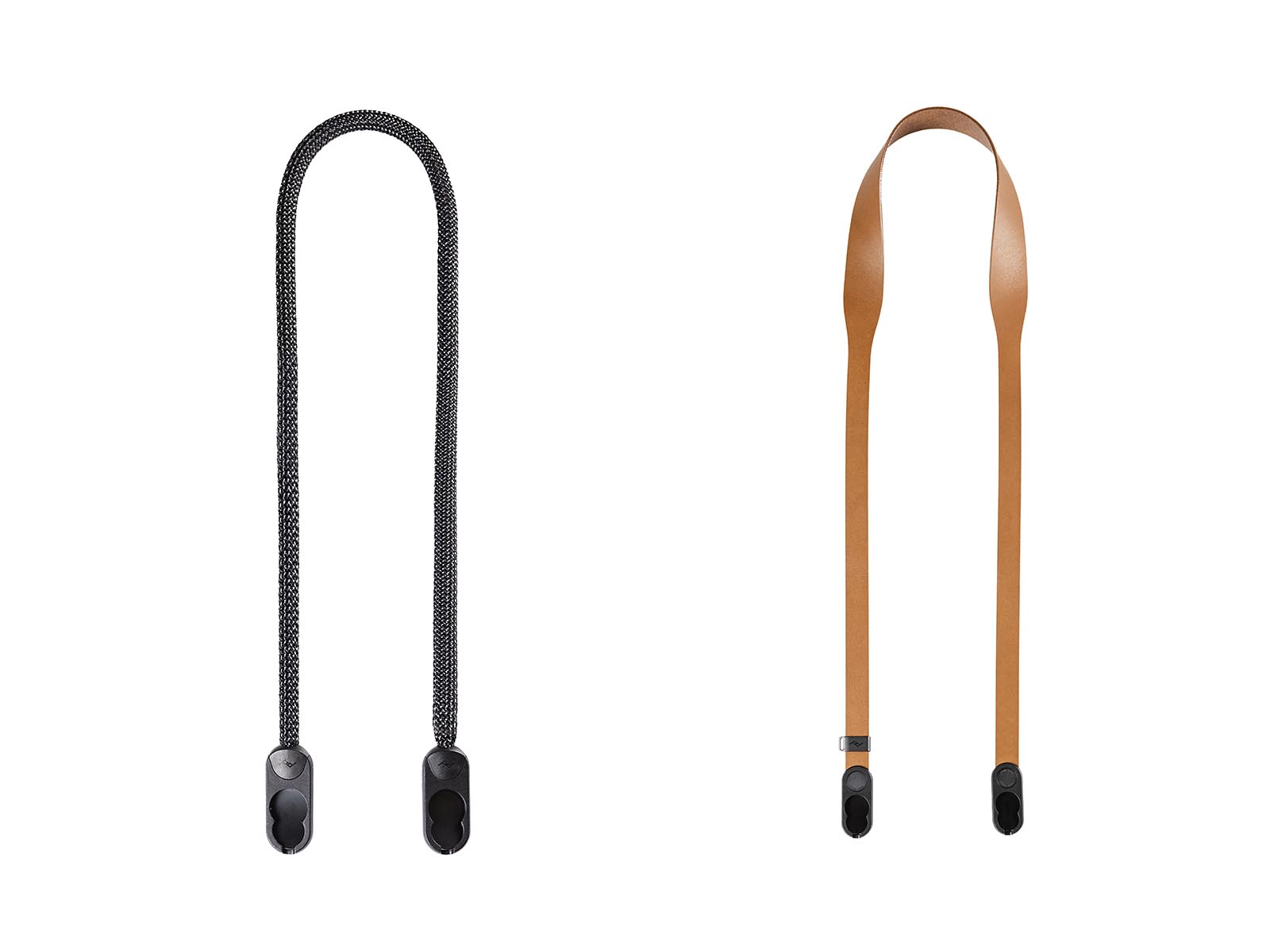 Peak Design’s new low-profile, minimalist form straps come in both rope (right) and leather (right) styles. Photo courtesy of Peak Design.
Peak Design’s new low-profile, minimalist form straps come in both rope (right) and leather (right) styles. Photo courtesy of Peak Design.
Peak Design makes the list every year because it makes my favorite travel and photography essentials. I’m currently in Africa traveling for two months with the Peak Design slide camera straps, lightweight travel tripod, iPhone case, car mount and travel backpack.
One of the simplest accessories has been a game-changer for this Africa trip—the magnetic mobile wallet that attaches to the back of my phone. Due to safety concerns, I wanted a minimal wallet for this trip—I can slip the wallet in a pocket if needed or keep it attached to my phone. I’ve literally used it daily for the past month. It fits two cards and a few cash bills rolled up. (I keep the rest of my cards separate for safety.)
Their new arrivals are amazing—the Roller Pro Carry-ons, and the new low-profile, minimalist form straps in both leather and rope. Peak Design only does one sale every year on Black Friday, so act fast. All products are on sale up to 30 percent off!
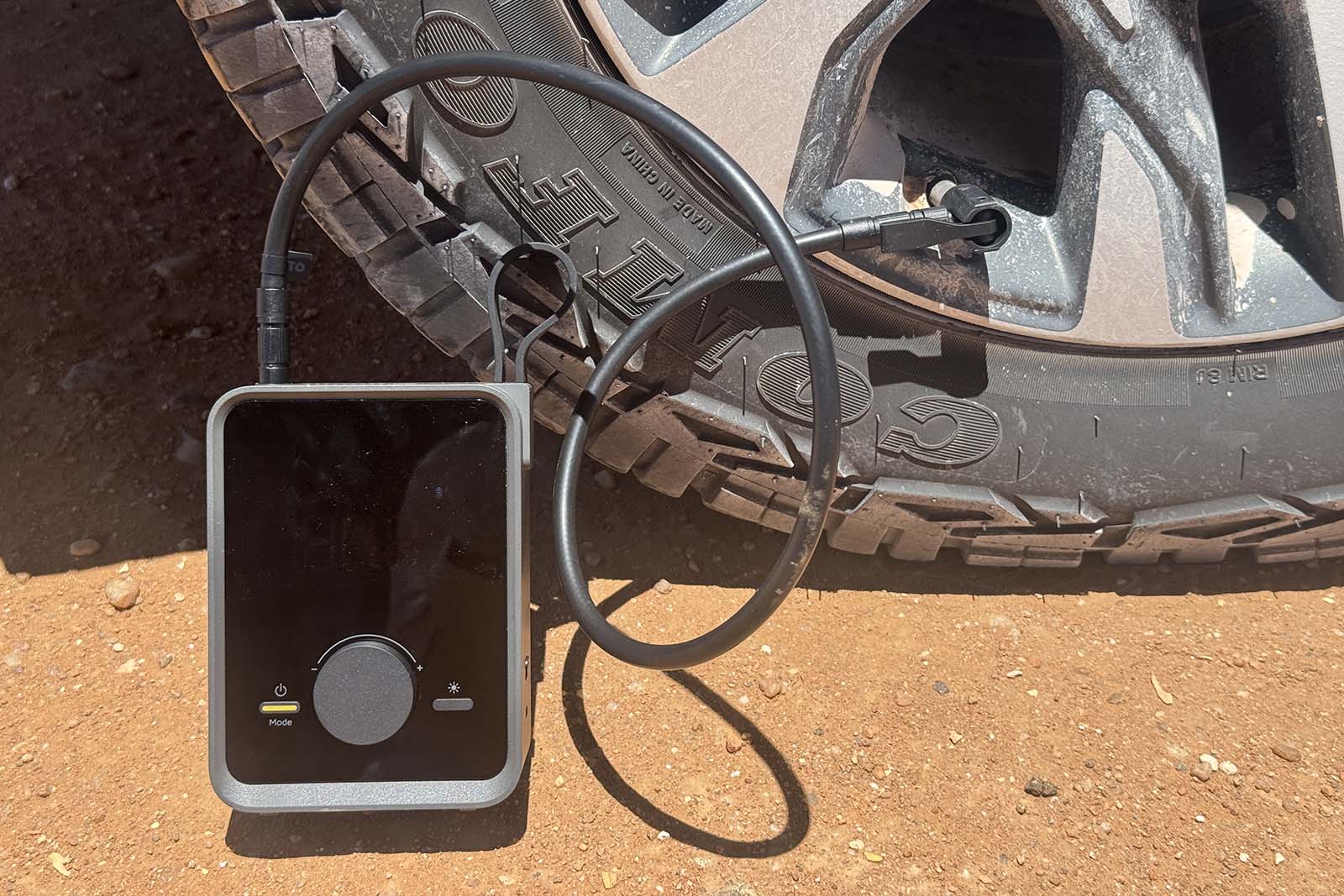 Hoto’s line of portable air compressors are perfect for both domestic and internatoinal travel.
Hoto’s line of portable air compressors are perfect for both domestic and internatoinal travel.
Last week, my friends and I were road tripping around Namibia mostly on unpaved washboard roads. When our back tire was low, this handy portable air compressor saved us. Plus, it has an auto-stop feature making it a breeze to use. It took no time to fill up the tire and get us back on the road. It works for cars, motorcycles, bikes and balls. (Our rental car company has given us a gargantuan air compressor to use but this was much more convenient. And it didn’t evolve unpacking the entire car!)
It also has three inflation units: kPa, psi, and bar. This is handy for international travel because the U.S. uses psi and Namibia uses bar. The model we used is only $69 on Amazon during the Black Friday sales!
The Foldie® Travel Bag
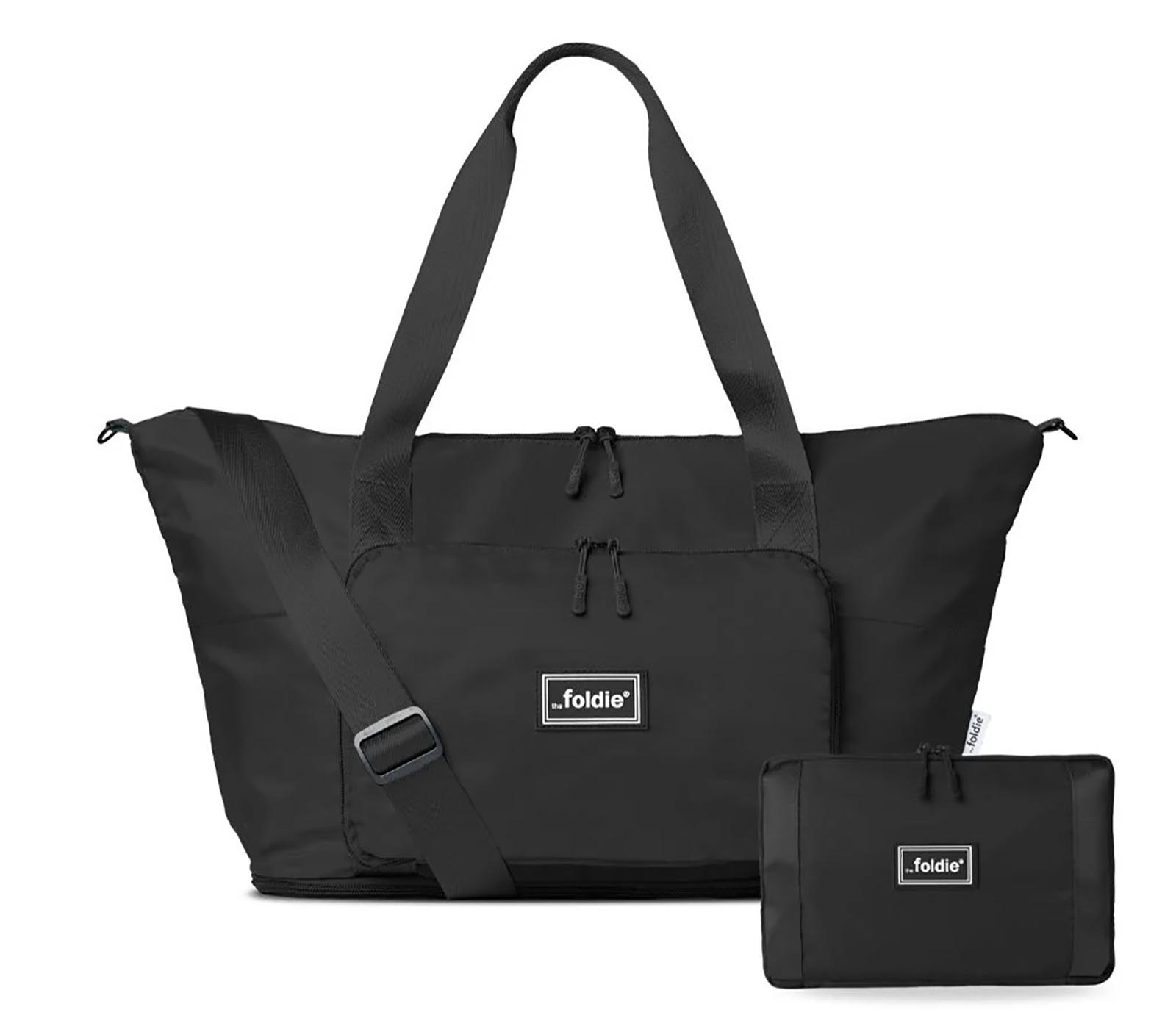 The Foldie Travel Bag zips up into a small pouch making it easy to pack! Photo courtesy of The Foldie.
The Foldie Travel Bag zips up into a small pouch making it easy to pack! Photo courtesy of The Foldie.
My sister gave me one of The Foldie® Travel Bags, and I absolutely love it. This 40-liter zippered, water-resistant travel bag folds flat in a pouch. I keep this in my rolling carry-on suitcase, so if I’m forced to check my roller bag, I put my electronics in this as a backup.
I’ve also used it as a weekend bag, a carry-on and used it on the bus on my Africa trip recently. There’s an inside zippered pocket for wet items like swimsuits and a zippered bottom expansion. Keep an eye out for their BOGO Black Friday sale!
Patagonia Terrebonne Joggers
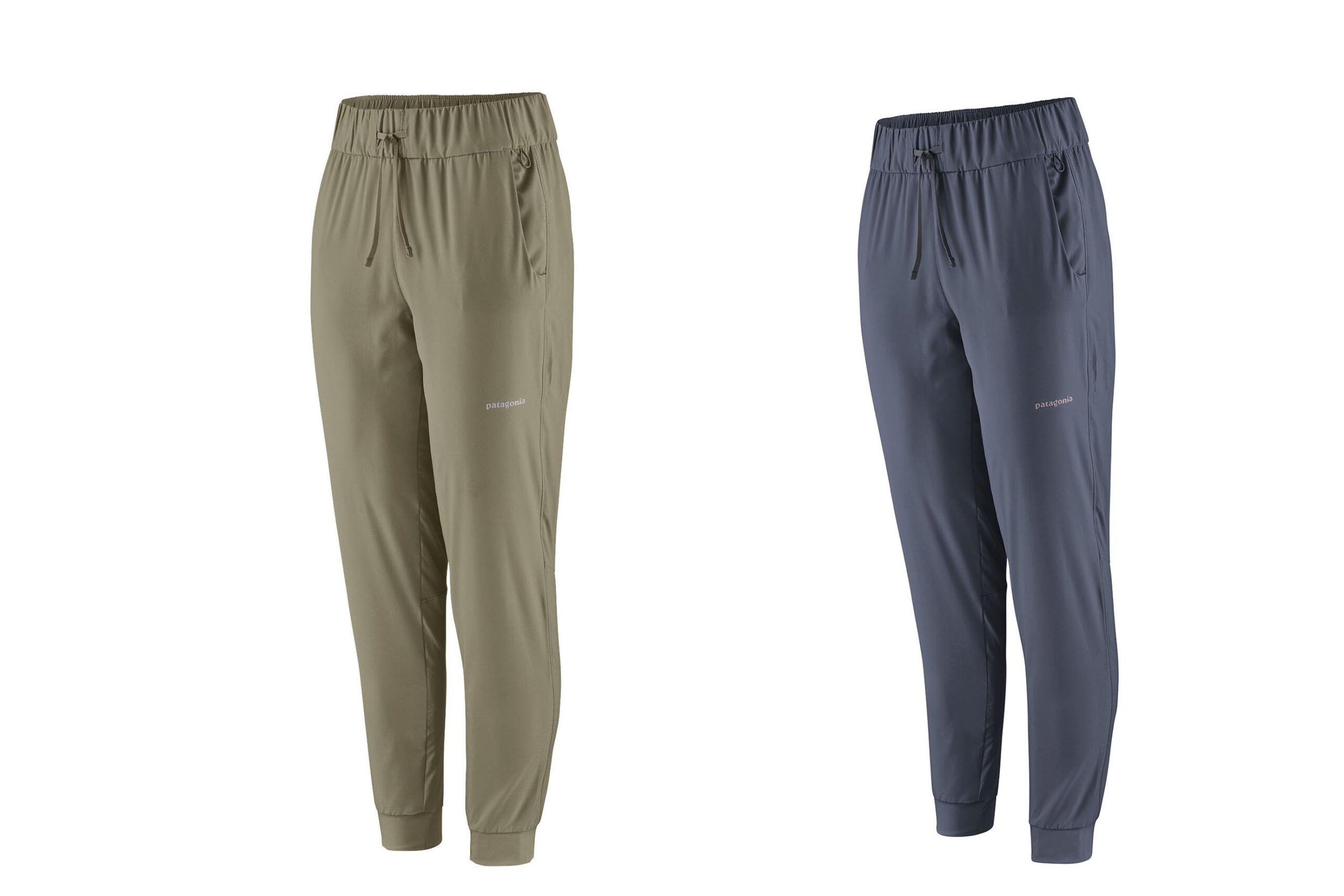 Patagonia Terrebonne Joggers come in four colors in both men’s and women’s sizes. Photo courtesy of REI.com.
Patagonia Terrebonne Joggers come in four colors in both men’s and women’s sizes. Photo courtesy of REI.com.
I’ve been on the hunt for lightweight travel pants for hot, humid climates with no luck until I found these Patagonia Terrebonne Joggers, which are available in both men’s and women’s sizes. These are lightweight, breathable, quick drying and stretchy. And, perfect for plane rides and wandering around a new city. The joggers came in four colors, but I’m loving the black. Available at Patagonia.com and REI.
Sawyer Picaridin Insect Repellent
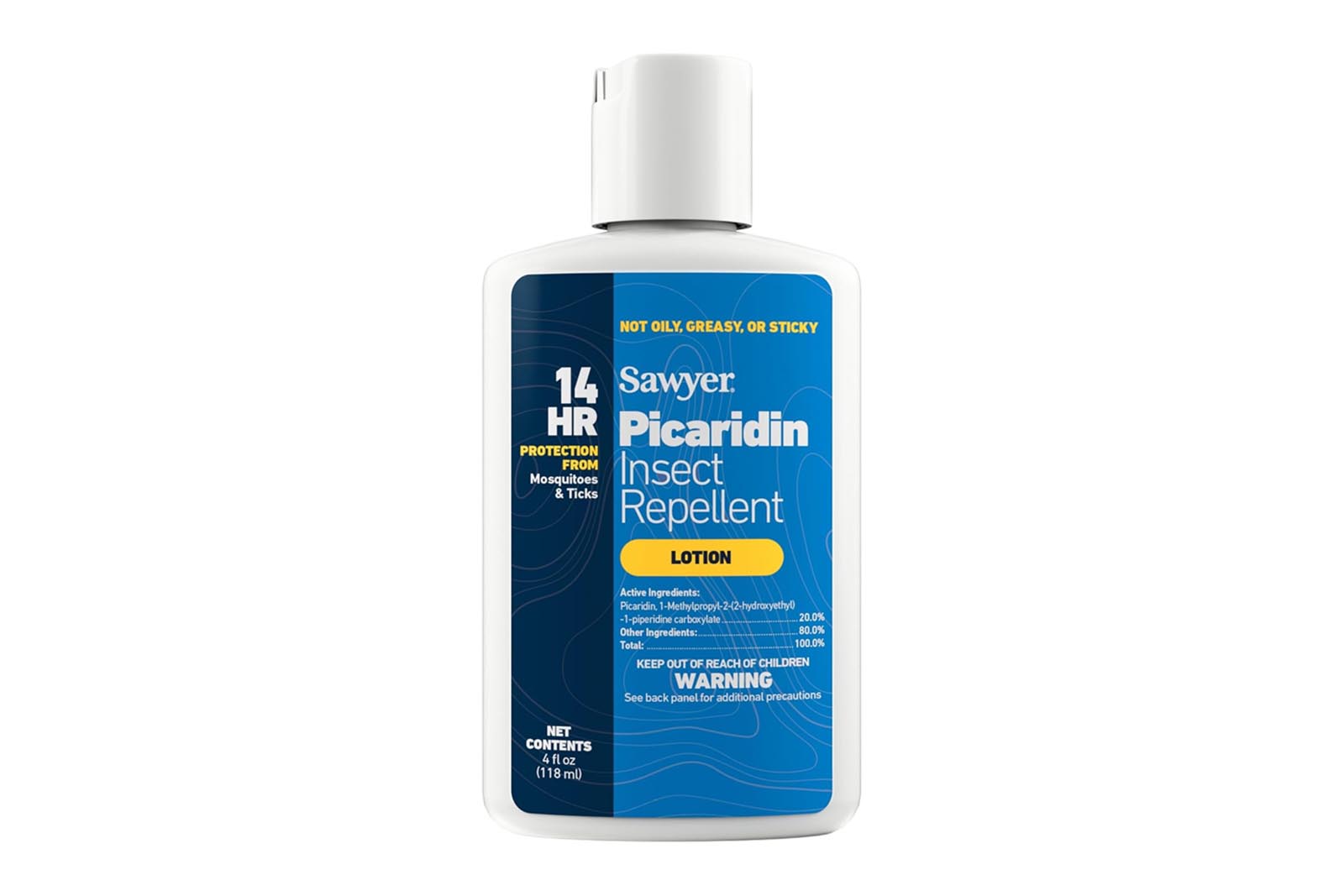 Sawyer’s picaridin insect repellent comes in both spray and lotion forms. Photo courtesy of Sawyer.
Sawyer’s picaridin insect repellent comes in both spray and lotion forms. Photo courtesy of Sawyer.
While this isn’t a sexy holiday gift, it’s a very useful one. I’ve always been a DEET-hater because it stinks, ruins clothing and melts flipflops. Now, I use the Sawyer brand of picaridin, which is approved by the EPA and is safe for use on clothing. It also smells much milder than the cough-inducing DEET. I’ve found Picaridin to work better than DEET for ticks. It’s been great on my last two safaris in Kruger National Park and Botswana.
The Sawyer brand is available at REI and Amazon in spray and lotion form. I’ve also been using the Sawyer MINI water filter on this trip for filtering water for extra safety. The brand also has a line of soft collapsible bottles that attach to the filters.
Chipolo Bluetooth Trackers
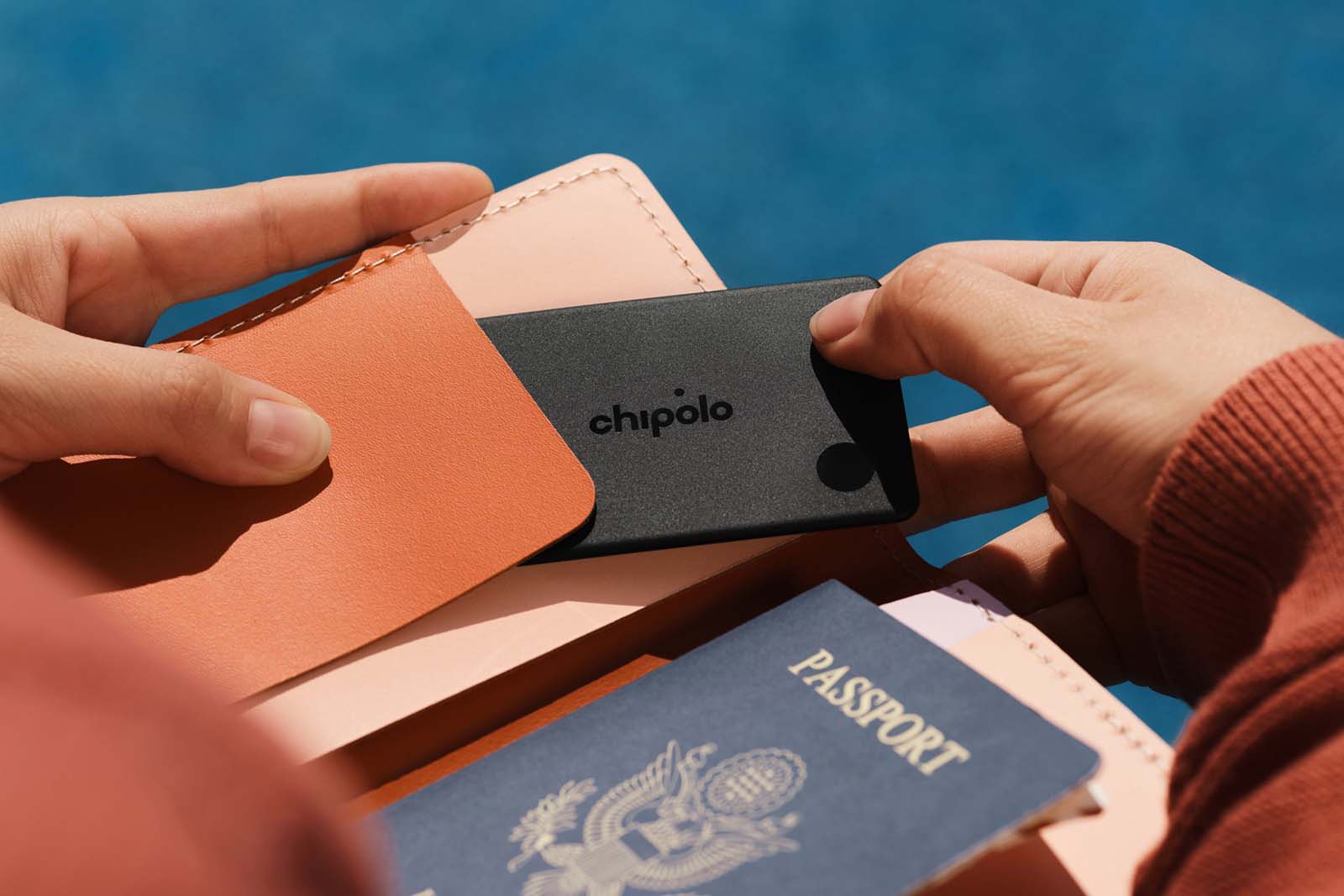 Chipolo Bluetooth trackers include a credit-card shaped wallet tracker to colorful round trackers that easily attach to luggage and key chains. Photo courtesy of Chipolo.
Chipolo Bluetooth trackers include a credit-card shaped wallet tracker to colorful round trackers that easily attach to luggage and key chains. Photo courtesy of Chipolo.
My travel buddy Rolando is the biggest source of my favorite travel gear. He just introduced me to Chipolo bluetooth trackers, a colorful version of an AirTag that’s easier to attach to items. I love the credit-card-shaped wallet tracker the most.
The other two products include the cheerful Chipolo POP and LOOP designs. These work with Apple’s Find My and Android’s Find Hub networks. I also love that these are made in Europe, not China.
Incense Matches
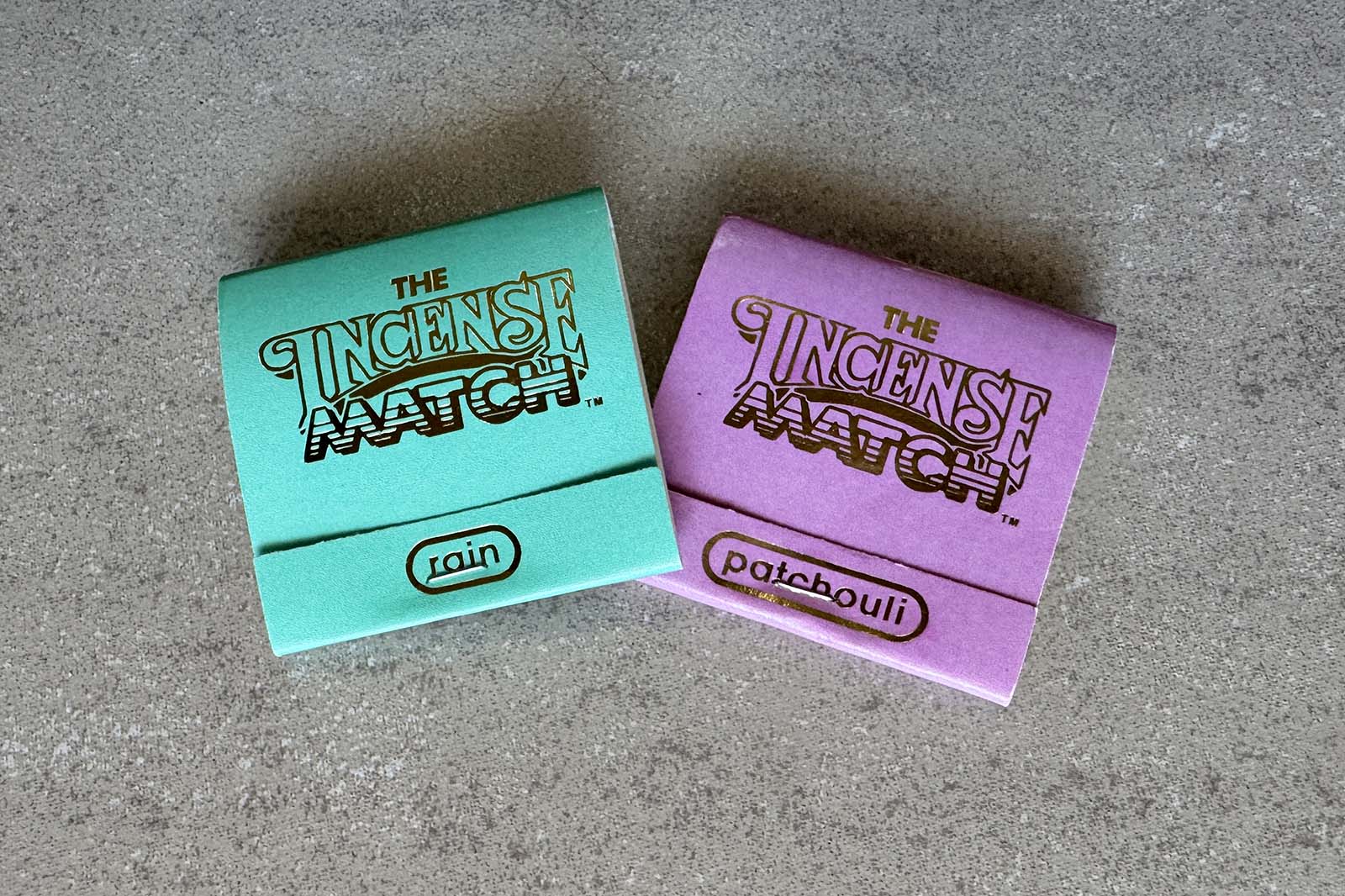 Incense matches come in a variety of scents to keep your travels smelling fresh.
Incense matches come in a variety of scents to keep your travels smelling fresh.
If you’re looking for a funny stocking stuffer, try Incense Matches for eliminating bathroom odors while traveling. These incense-infused matches have a two-to-four-minute burn time with a lasting scent. The matches are made by a family-run company based in the U.S. This is yet another great and hilarious find from Rolando.
Ridge Magnetic Power Banks
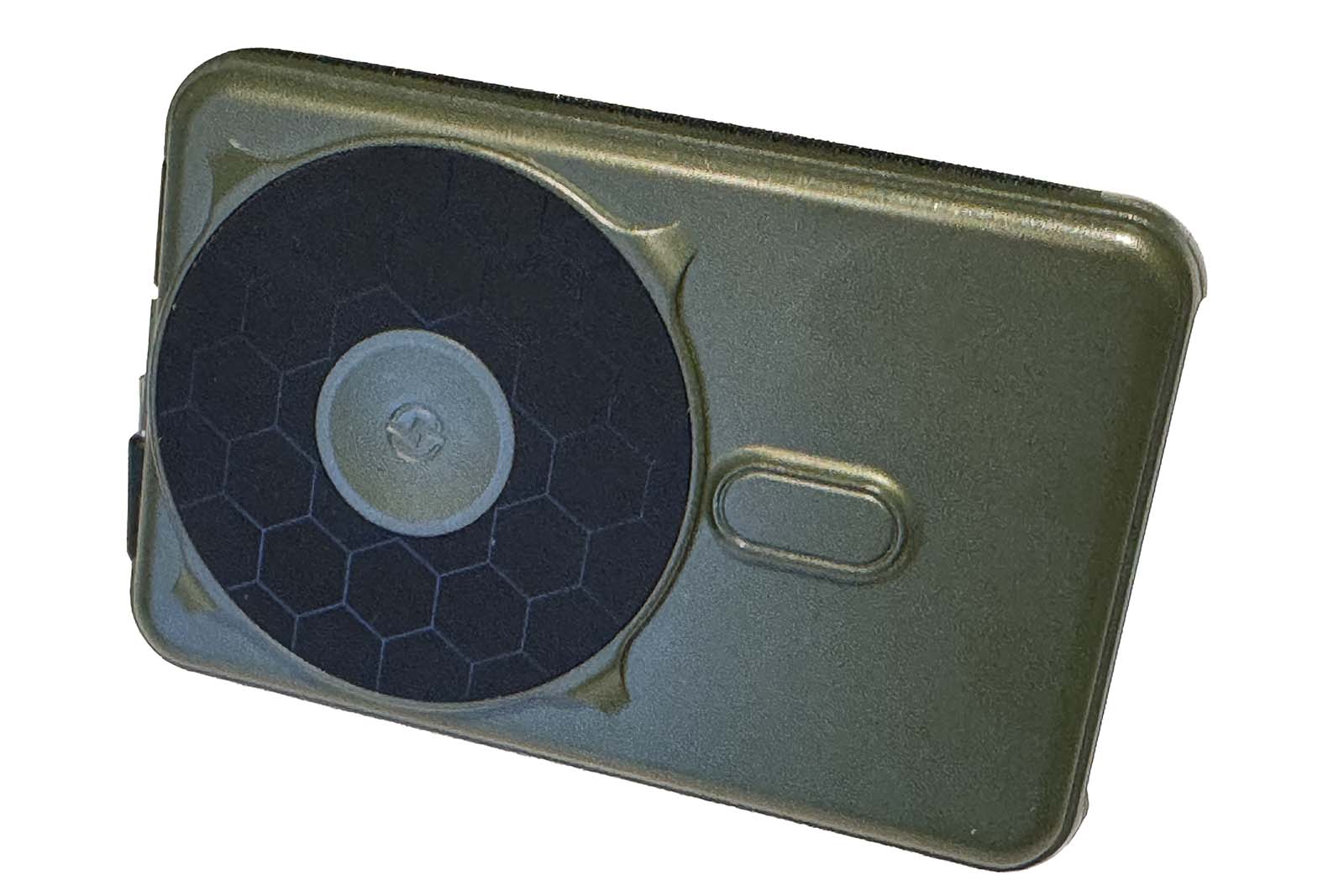 Ridge power banks have a built-in kickstand that’s perfect to use on long flights.
Ridge power banks have a built-in kickstand that’s perfect to use on long flights.
The sleek Ridge power bank is the Swiss Army knife of portable chargers with a 5-in-1 power solution. With 10 MAH, it offers three smartphone recharges and a fast 20W charge for USB-C. It’s also compatible with MagSafe® items, including the Apple Watch. The built-in kickstand is perfect for streaming shows on long flights.
Uniqlo AIRism
I’m a hardcore fan of Uniqlo, the Japanese clothing brand that has brick-and-mortar stores in large cities across the globe. (You can buy online in the U.S. easily if you don’t live near one.) I’m loving this AIRism tank ($15) I bought earlier this year—it’s cool moisture-wicking. It’s a great underlayer in the heat. Uniqlo has AIRism clothing from tanks to jackets in both men’s and women’s styles. It’s all very affordable.
Gymshark Athletic Wear
 GymShark’s cotton razorback sports bras are my favorite for travel.
GymShark’s cotton razorback sports bras are my favorite for travel.
All the girls at my Muay Thai gym in Chiang Mai have been wearing GymShark, the British athletic brand. (They sell both men’s and women’s apparel. You can buy things easily online in the U.S. with free shipping and returns.) I’m in love with their cotton razorback sports bras and tights. FYI—the bras run small, so I’ve had to buy a small or even a medium in some styles despite normally wearing an XS.
Sony 100-400 mm Lens
 I’m currently traveling with a Sony FE 100-400mm f/4.5-5.6 GM OSS lens and two Sony ar7v camera bodies.
I’m currently traveling with a Sony FE 100-400mm f/4.5-5.6 GM OSS lens and two Sony ar7v camera bodies.
I switched to Sony from Nikon just over a year ago, which was life-changing because Sony’s gear is lighter weight. (The weight of my gear has been my biggest struggle, and my back is so much happier now!) For this trip, I bought a used Sony FE 100-400mm f/4.5-5.6 GM OSS for wildlife photography. It’s now my favorite lens. While I love my 70-200 f/2.8, I love having the extra range of the 100-400.
I find I’m too shaky with heavier lenses to get my images as sharp as I’d like, so this lens is the happy medium. I’ll be sharing some of my favorite safari images next month in my annual post of my favorite images of the year!

Airalo Review for Country-Hopping in the Balkans: Staying Connected from Greece to Montenegro
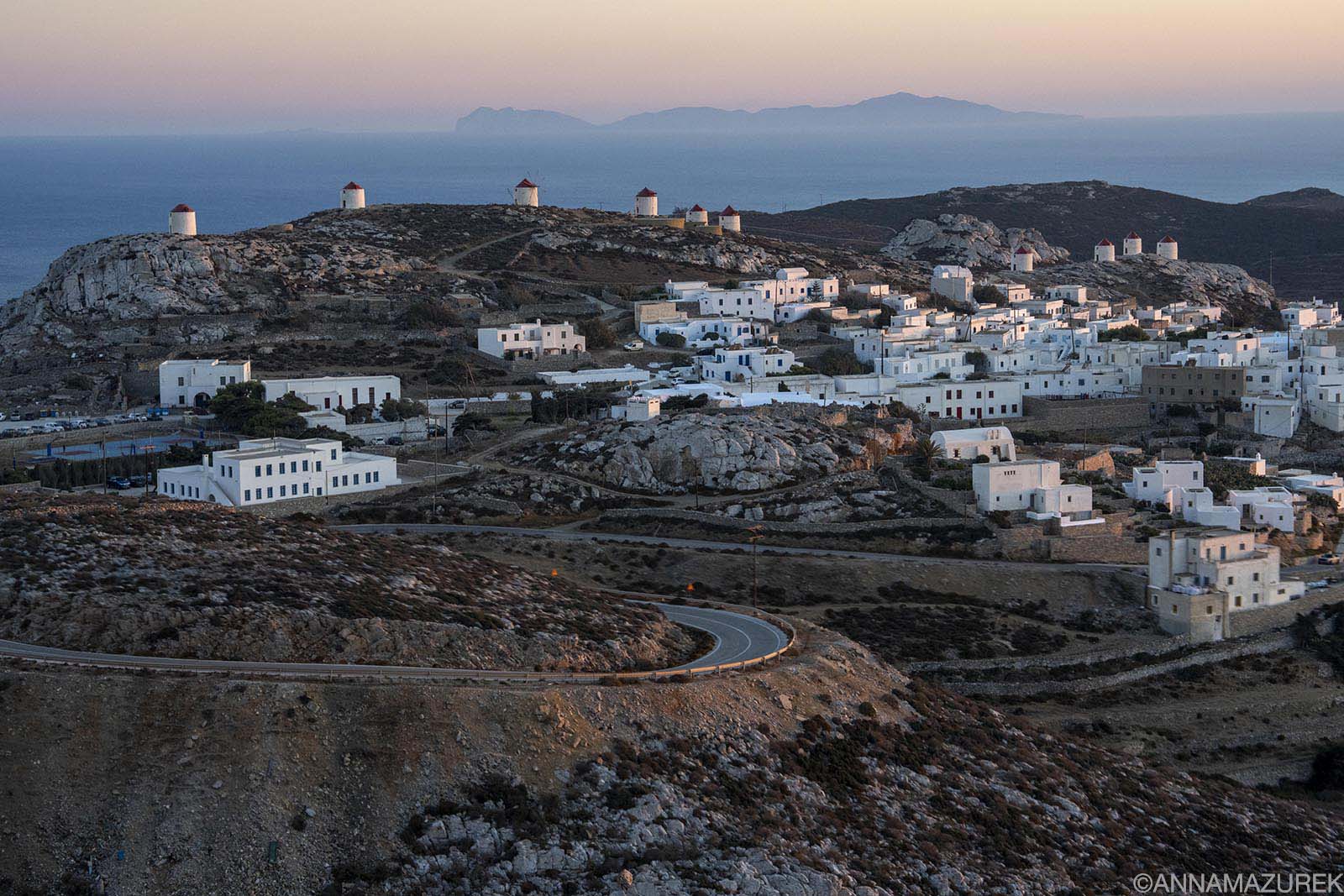 I spent two weeks on Amorgos, my favorite Greek island, with excellent cell service across the majority of the island.
I spent two weeks on Amorgos, my favorite Greek island, with excellent cell service across the majority of the island.
When I first switched to an eSIM-only iPhone, I was extremely hesitant because I travel full-time and need to be connected to be able to work. Now, eSIMs have made my life tremendously easier—I’ve even written about the pros and cons of eSIM cards.
While I’ve tried other brands, I tend to default to Canadian-based Airalo because they are the world’s oldest eSIM store, founded in 2019. (After Apple announced its eSIM-only phone in 2018, Airalo CEO Ahmet Bahadir Ozdemir jumped on the opportunity, drawing from his experience as a maritime industry supplier where he got continuous requests for SIM cards.)
I recently spent two months (Aug. 8 to Oct. 7, 2025) in Europe, hopping between E.U. and non-E.U. nations using Airalo eSIM cards. (I always use promo code AIRALOESIM10 to save 10% on every purchase. This, paired with Airalo’s cashback loyalty program, often makes it cheaper than other brands.)
One of my freelance gigs is working for a travel company for a couple of months each year. In the past, this meant buying new SIM cards in each place or buying an EU SIM card and not having service for a few days in non-EU countries. This was my first time working in this region only using eSIM cards, so I thought it was a perfect time to write an Europe Airalo review about my seamless experience country-hopping.
Countries Visited: Greece, Albania, Montenegro and Croatia
Usage: WhatsApp for texts, calls and audio messages, navigation apps, uploading video/photos to social media, and using the hotspot to connect to a computer.
Promo Codes: NEWTOAIRALO15 for 15% off your first purchase. Existing users can save 10% with AIRALOESIM10.
AFFILIATE DISCLOSURE: This is a sponsored post with affiliate links. All opinions are my own. If you make a purchase, I earn a small commission at no cost to you, which goes toward blog maintenance costs. I only recommend products and companies I truly love and use.
Airalo in Greece
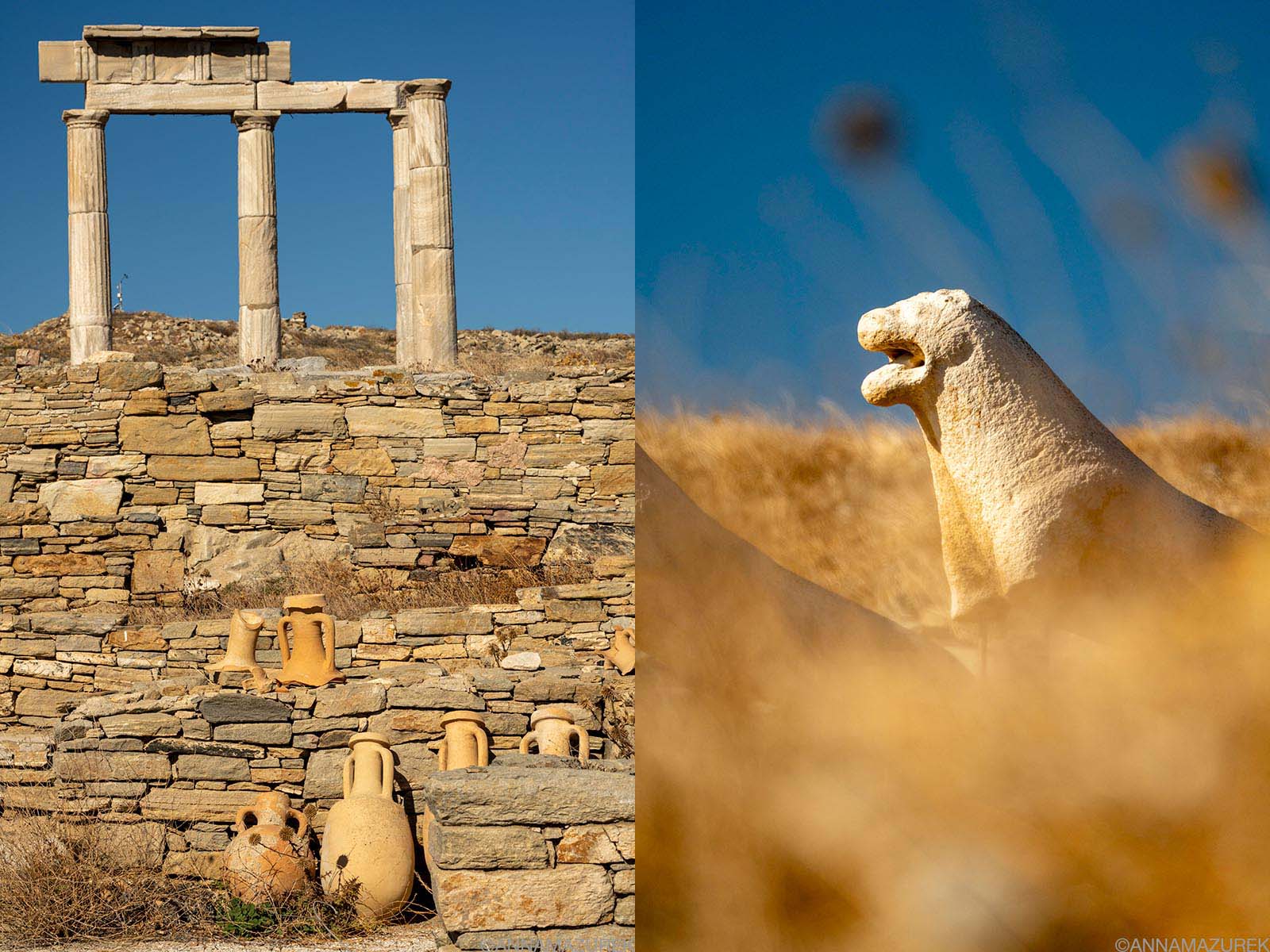 I had great cell service with Airalo on the uninhabited island of Delos, an expansive archeological site near Mykonos.
I had great cell service with Airalo on the uninhabited island of Delos, an expansive archeological site near Mykonos.
Locations Visited: Athens, Olympia, Corfu, Cyclades (Santorini, Naxos, Milos, Amorgos, Tinos, Sifnos, Delos)
Cellular Network: WIND HELLAS (Nova) 5G
Is 5G supported? Yes
eSIM Used: Eurolink 10 GB for 30 Days ($37) & Greece Meraki Mobile 10 GB for 30 days $20
I kicked off my trip in Athens in early August for a few nights before sailing around the Peloponnese peninsula to Olympia, then on to Vathy and Corfu before heading north to Albania. Then, I flew back to Athens in early September and stayed in Greece until early October. I started in Athens again, then sailed around the Cyclades for two weeks before taking a ferry to Amorgos, my favorite island, to relax for two weeks. After returning to Athens, I drove to Corinth to visit the ruins and Acrocornith on the eastern side of the Peloponnese peninsula.
I had 5G service in most places, even in portions of Amorgos, which was a bit shocking considering how remote the island is compared to others. My main uses were social media (Instagram, Facebook, etc.), email, driving navigation maps and communication via WhatsApp. I had a lot of long bus drives where I just browsed the internet and cleaned out my email account. I also used it to hotspot to my computer, so I could work. The connection was almost always faster than the local WIFI in most places I stayed.
The only place I had service issues was the tourist hub of Oia on the island of Santorini. I’ve had similar issues there in past years with physical SIM cards. I’ve always had spotty LTE service, which could be a combination of crowds and narrow streets between the buildings. (To be honest, skip Oia—it’s overrated and crowded.) The archeological site of Akrotiri, a village destroyed by volcanic ash 1,500 years before Pompeii, is the island’s best attraction and less crowded. There’s always been limited service inside the archeological site (even with regular SIM cards) due to the metal roofs and concrete walls.
On my seven-hour ferry back to Athens from Amorgos, we stopped at several different islands, so I started doing speed tests of the cell service using Google’s speed test option. (It tends to show slower speeds than using one of the speed test apps.) Keep in mind, I was sitting on the ferry as I ran these tests and had no issues browsing the web while in port.
Milos: 163 Mbps download, 7.76 Mbps upload
Serifos: 74 Mbps download, 25.5 Mbps upload
Folegandros: 91.7 Mbps download, 8.63 Mbps upload
Athens’ airport lounge: 147.8 Mbps download, 9.34 Mbps upload
The 10 GB Europe package lasted the entire month. For safety, I’d bought a 10 GB top-up package that I didn’t need. After a 20-minute chat with support, they refunded it because it was unused.
Airalo in Albania and Montenegro
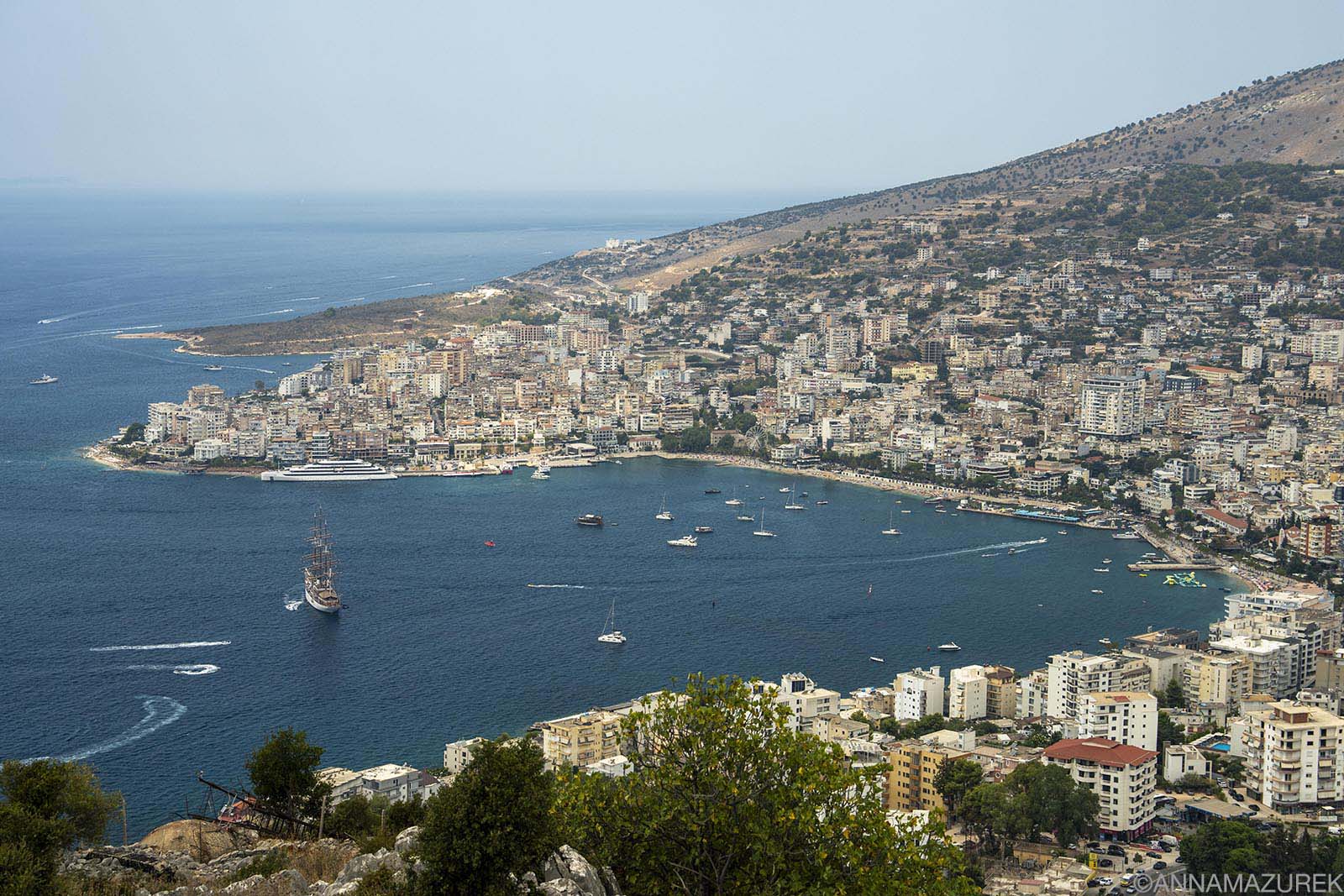 My Airalo eSIM Europe regional eSIMs worked seamlessly as I sailed from Greece to Sarandë, Albania (above).
My Airalo eSIM Europe regional eSIMs worked seamlessly as I sailed from Greece to Sarandë, Albania (above).
Locations Visited: Albania (Durrës, Sarandë, Butrint, Kruja); Montenegro (Kotor, Persat)
Cellular Network: Albania: Vodafone LTE; Montenegro: MTEL (LTE)
Is 5G supported? No.
eSIMs Used: Eurolink 10 GB for 30 Days ($37)
The best thing about the Airalo Europe regional eSIM is that it works in non-EU nations! (Kosovo was the only location in the Balkans that’s not covered.) In the past, my physical EU SIM cards would not work in Albania or Montenegro. This time, it was a completely seamless process; I had service instantly upon arrival. I was able to scroll social media and the web on bus rides between Sarandë and Butrint, and Durrës and Kruja with no issues. WhatsApp worked with no glitches, except for remote areas.
The only spot where I had coverage issues was in the remote UNESCO archeological site of Butrint, a former Greek and then Roman city. Certain parts of the site don’t have the best service. You should definitely visit—the site itself is fabulous!
Airalo in Croatia
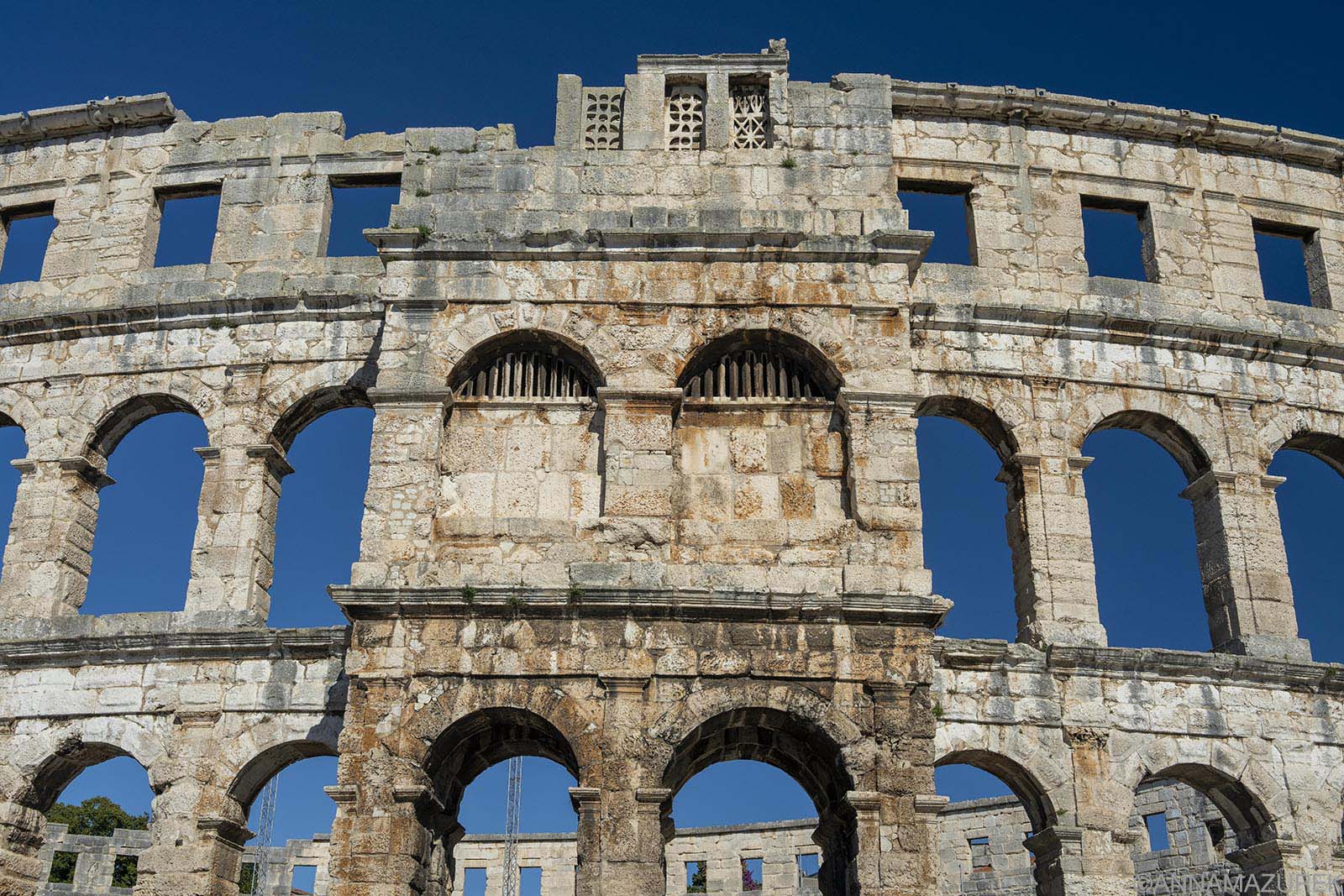 From Pula’s Roman amphitheater (above) to the beaches of Hvar, I had excellent cell service along the entirety of Croatia’s coast.
From Pula’s Roman amphitheater (above) to the beaches of Hvar, I had excellent cell service along the entirety of Croatia’s coast.
Locations Visited: Hvar, Korčula, Vis, Dubrovnik, Zadar, Pula, Rovinj
Cellular Network: Telemach/TM 5G & A1 Hrvatska LTE
Is 5G supported? Yes
eSIMs Used: Eurolink 10 GB for 30 Days ($37)
When I arrived in Croatia, I still had plenty of data left on my Europe regional eSIM, the Eurolink 10GB for 30 days. (It covers 42 countries and networks.) Initially, I’d planned to buy a cheaper Croatia-only eSIM when I arrived because I assumed I’d be out of data, but I was fine. Airalo makes it easy to check your data balance in the app. You can also set up notifications about low data. It’s very simple to top up in the app as well.
Sections of the old city of Dubrovnik are the only places I’ve had service issues over the years in Croatia, which is likely due to the thick walls. Service still works but just can be a bit spotty or lagged depending on your location. Often moving to another location or higher ground (climbing those steps!) fixes the issue. Otherwise, I had 5G in most locations.
Airalo in the United Kingdom (England)
Locations Visited: Heathrow Airport (Five-hour layover)
Cellular Network: EE 4G
Is 5G supported? No
eSIM Used: Uki Mobile with 1 GB for three days
When I have layovers in other countries, I always buy a 1 GB eSIM to ensure I have coverage for any potential travel delays or emergencies. (Airalo does offer regional Europe eSIMs that also cover the UK, but it was cheaper to buy a local plan instead for this short visit.) When I left Greece in early October, I was using a Greece-only eSIM, so I bought a United Kingdom-only eSIM, Uki Mobile, with 1 GB for three days, the shortest duration available.
I only had LTE in the airport. I ran the generic Google speed test on my phone, and it said UK 3 LTE network was 64.4 Mbps download, 3.42 Mbps upload. Since EE was supported by the eSIM, I manually changed the network to EE (my preferred network) and faster – 70.6 Mbps download, 3.79 Mbps upload. (Speeds were likely faster than this because I was simply testing in the lounge.) I had no issues with connectivity, even when after boarding, I could message friends and scroll the internet until we had to put our phones in airplane mode. When I’ve bought physical SIM cards in the UK in the past, I’ve always bought EE SIMs because the network has great coverage across England and Scotland.
Q&A: Airalo in Europe
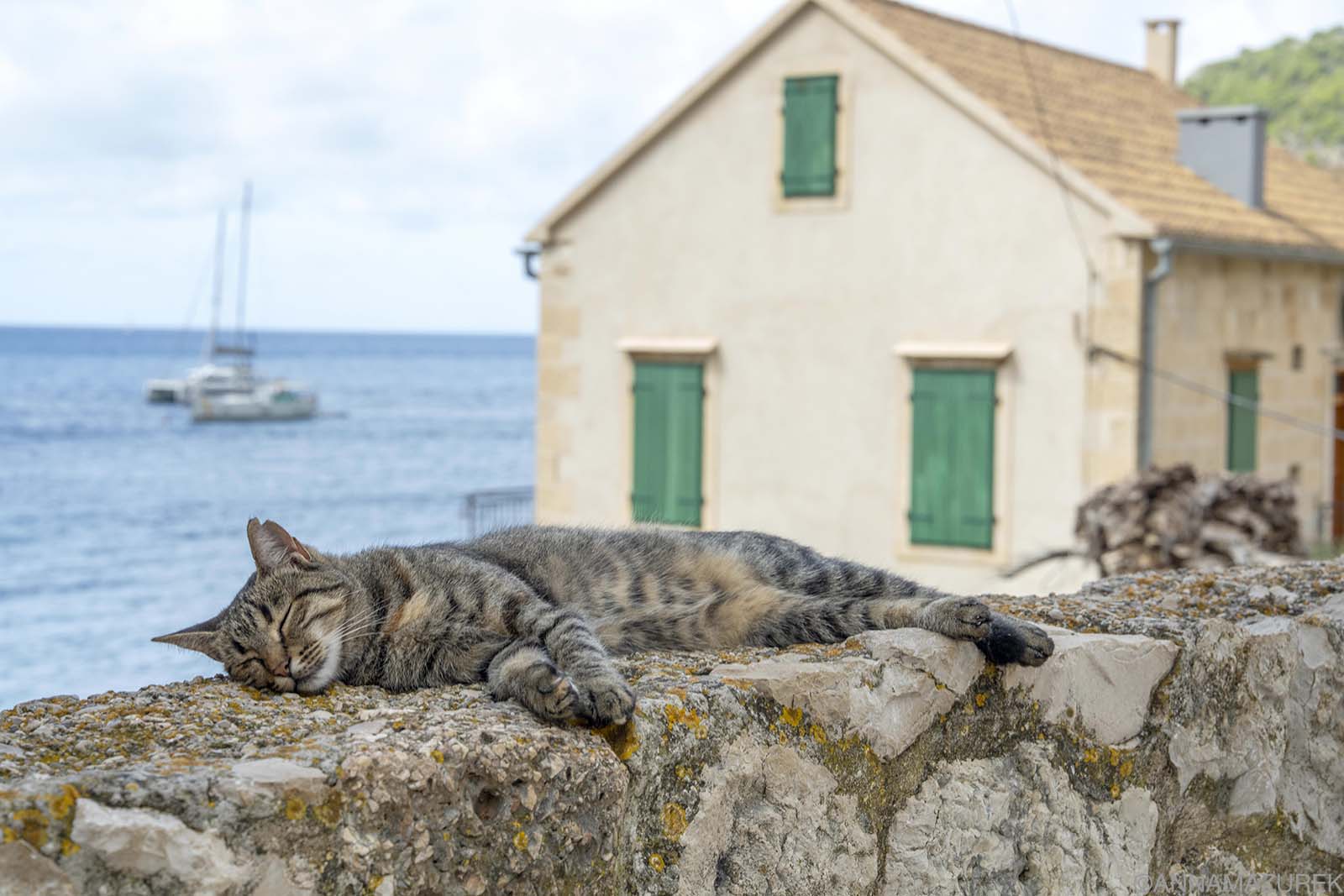 One of Croatia’s many photogenic cats on the island of Vis.
One of Croatia’s many photogenic cats on the island of Vis.
Is a local country-specific eSIM better than a regional eSIM?
Local country-specific eSIMs are almost always cheaper than a regional eSIM. I always do a cost comparison based on how long I’ll be in a country. If you’re country-hopping, then a regional eSIM is much easier. Plus, Airalo’s Europe eSIM covers 42 countries. It’s really important to make sure every single country you are visiting is covered before buying the eSIM. (I’ve made this mistake before by just assuming a place was covered.)
Does Airalo offer Unlimited Data?
Yes, Airalo offers unlimited data in Europe. With the Europe regional eSIM card, there’s a 10-day unlimited package. There is a wider variety of length options ranging from three to 30 days for country-specific eSIMs making it easy to customize your eSIM card choice to your trip. You can use the hotspot with unlimited plans easily. After 3 GB of data usage per day, the speed rate drops to 1 Mbps, which is standard across all eSIM brands. (The 3 GB limit applies to all data usage on the phone, including using the hotspot.)
Does Airalo offer plans that include data, calls and texts?
Yes, Airalo does offer plans that include calls and texts but not in all locations. Of the eSIMs I used, only the United Kingdom eSIM offers the option. It was not an option in the Europe regional eSIM or the local eSIM I used in Greece.
Airalo Review Summary
 The view from Acrocornith on the Peloponnese pennisula in Greece.
The view from Acrocornith on the Peloponnese pennisula in Greece.
At the end of the day, eSIM cards are only as good as the cellular network they partner with. My connection was seamless, country-hopping across Europe and the Balkans this summer. I was able to check email, upload to social media, use Google Maps for navigation and even hotspot to my computer to work with no major issues.
If you’re going to be traveling in a remote area, research the best cellular network and find the eSIM plan that uses that network. After this experience, I’d highly recommend using Airalo across Europe in both EU and non-EU nations. To save money, I always use the promo code AIRALOESIM10 to save 10% on every purchase. (To save 15% off your first purchase, use code NEWTOAIRALO15.)

I Used SafetyWing Travel Insurance in Southeast Asia—Here’s How It Went

From a ski trip in the French Alps to backpacking South America, travel insurance is one of the most important things to purchase for any trip. When it comes to insurance, you insure what you can’t afford to pay yourself. Unlike health insurance in the United States, travel insurance is very affordable. SafetyWing is currently my go-to company for flexible travel medical insurance, and I currently use their Essential plan. In this post, I share their insurance and coverage options along with my personal review of SafetyWing.
Affiliate links are used in this post. If you make a purchase, I earn a small commission at no cost to you, which goes toward blog maintenance costs. This post was originally published in February 2025 and has been updated with new plan information.
In This Post
Why do you need travel medical insurance?
SafetyWing Travel Insurance Options
What does SafetyWing Travel Medical Insurance cover?
Does SafetyWing cover adventure sports?
Does SafetyWing cover electronics theft?
What’s not covered by SafetyWing travel medical insurance?
How much does SafetyWing cost?
Purchasing Process with SafetyWing
My Review of SafetyWing Travel Medical Insurance
Why do you need travel medical insurance?
Travel insurance covers all the things that go wrong – the flight delay that left you stranded in Istanbul for the night or the bout of food poisoning that hits a few hours before your flight home from Mongolia. Both are true stories from my travel adventures and not fun memories. Both of these I claimed on travel insurance and were covered by my plan. I ALWAYS buy travel medical insurance for every trip, which usually runs roughly $56-100/month depending on your age.
Who is SafetyWing?
Founded in 2018, SafetyWing was a fully remote Norwegian startup based in California run by nomads and expats providing insurance for budget travelers and nomads. (You don’t have to be a nomad or a budget traveler to use their insurance. It’s available to everyone.)
SafetyWing Travel Insurance Options
SafteyWing Nomad Insurance has two options: Essential and Complete. Neither plan covers pre-existing conditions. (I’m currently on an Essential plan.)
In late 2025, SafetyWing launched Nomad Citizen—a beta membership offering global coverage for entrepreneurs, freelancers, and nomads who join Plumia’s Nomad Citizen or a sponsoring organization.
SafetyWing Nomad Essential
Best for short-term travel
Nomad Insurance Essential provides short-term coverage for unexpected medical issues and emergencies while traveling outside your home country. Additional add-ons include adventure sports, electronic theft and U.S. coverage for non-residents.
You can pay monthly or in full for policies. Longer policies can be set to auto-renew. When you cancel a policy anytime and get a pro-rated refund. There’s no minimum time limit for policies, so you can buy coverage for the exact dates you need.
SafetyWing Nomad Complete
Best for longterm travel
The Nomad Insurance Complete is long-term comprehensive coverage (12-month commitment) for unexpected and ongoing health concerns worldwide. These plans can be paid monthly or annually for a 10% discount. While adventure sports are included, additional add-ons include electronic theft and coverage in Hong Kong, Singapore and the U.S. (This policy is not available to U.S. residents.) Plans start at $150.50/month.
One of the best benefits of SafetyWing is that you can buy while you are abroad and get 24/7 customer support with a REAL human! (I can vouch that they are excellent at assisting and will follow up with you afterward!)
SafetyWing Nomad Citizen
Global coverage for entrepreneurs, freelancers, and nomads
SafetyWing’s newest insurance program, Nomad Citizen, (beta version) is for people under age 50 who live abroad six months a year and earn $4,000 USD per month for the last year. It provides premium worldwide healthcare, including emergency and preventative care along with coverage for maternity, mental health and massage, plus travel and income protection. Plans start at $400/month for ages 18-39 for members of Plumia or another association focused on borderless living. Join the waitlist for details.
What does SafetyWing Travel Medical Insurance cover?
While it’s important to always read the full insurance policy, the items below are covered by SafetyWing for the Essential and Complete plans:
SafetyWing Nomad Insurance Essential Plan
Each Essential policy has a $250,000 USD max limit and a $100,000 USD max limit for U.S. residents over 65.
- Emergency Accident & Sickness Expenses.
- Emergency Evacuation & Repatriation. (Evacuation to a better-equipped hospital when needed is included with a $100,000 USD lifetime max.)
- Trip Cancelation, Delay or Interruption. (Benefits kick in usually for delays after 12 hours. $100/day for two days)
- Baggage Delay & Damage. ($500/item with a $3,000 policy maximum)
- Injuries from leisure sports and activities.
- Motor Accidents. You must be properly licensed, not intoxicated and wearing safety equipment to be covered. ($250,000 US max limit)
- Continued coverage in your home country after 90 days abroad. (30 days for non-U.S. residents and 15 for U.S. residents.)
For more details, read the full policy on their website.
SafetyWing Nomad Insurance Complete Plan
This is an annual comprehensive plan with $1,500,000 overall limit for people aged 18-65.
- Emergency medical treatment and hospitalization (Including evacuation to better-equipped hospital and transport of remains)
- Routine check-ups and preventative care plus doctor and specialist visits
- Psychologist and psychiatrist visits along with wellness therapies (chiropractor, dietician, etc.)
- Trip Cancelation, delay or interruption. (Benefits kick in after three hours.)
- Lost checked luggage and stolen belongings
- Injuries from leisure sports and motor accidents
- Maternity Care (10-month waiting period)
- Cancer Tests and treatment
For more details, read the compete policy.
Does SafetyWing cover adventure sports?
SafetyWing now covers adventure sports with a policy add-on for the Essential plan. It is included in the Complete plan. From paragliding to scuba diving, check out the full list of covered sports here. Organized and professional sports are not covered.
Does SafetyWing cover electronics theft?
Yes, you can add electronics theft coverage to a SafetyWing Essential and Complete policy for an additional fee. It covers cameras, laptops and phones with a $1,000 USD limit per item and a yearly limit of $3,000 per policy. This benefit is only available as an add-on for policies over 28 days. Proof of ownership like a receipt is needed for claims. To read the fine print, check out this page with all the details.
What’s not covered by SafetyWing travel medical insurance?
SafetyWing doesn’t cover pre-existing conditions for either plan. The Essential plan does not cover cancer treatment, lost or stolen personal belongings (except for electronics if you purchase that policy add-on), or trips that were canceled before you left.
Where can you travel with SafetyWing Nomad Insurance?
You can travel anywhere in the world except for your home country and countries with U.S., U.K., EU or UN sanctions including Belarus, Cuba, Iran North Korea, Russia, Syria and Ukraine.
After being abroad for 90 days, you can get 30 days of home country coverage. (For U.S. residents, it’s 15 days.) This is only for the Essential plan.
Who is eligible?
Essential Plan: Anyone aged 69 and under. Their policies cover people from across the world while they are outside their home country. Plans can be purchased abroad. Over 180 countries are covered. One child under 10 can be added at no extra cost per adult.
Complete Plan: Ages 18-65 except for residents (people who live in the following places 6 months per year) of Belarus, Canada, Democratic Republic of the Congo, Ireland, Palau, Saudi Arabia, United Arab Emirates and the U.S. Please note that this policy doesn’t cover you in your primary residence.
Nomad Citizen (beta): Ages 18-50 who live abroad six months a year, earn $4,000 USD per month and members of Plumia or another association focused on borderless living.
How much does SafetyWing cost?
Plans cost just a few dollars a day and vary by age making SafetyWing one of the most affordable brands of travel medical insurance. Policy add-ons such as U.S. coverage, adventure sports and electronics theft are extra for the Essential plan.
Purchasing Process with SafetyWing
It just takes minutes to fill out the form online including your age, home address and countries you’ll be visiting. The chat box makes it easy to ask questions and talk to a real human 24/7. Customer service can easily answer any questions quickly. They are also great about following up when needed.
My Review of SafetyWing Travel Medical Insurance
This includes my experience with two claims in 2024 and 2025.
In early 2024, I was abroad for about four months in Asia. During my trip, I started having some knee pain, so I went to Bangkok Hospital in Chiang Mai. Since an x-ray wasn’t helpful for my issue, the doctor ordered an MRI. I came back the next day and got the MRI and got my results an hour later. The MRI ruled out major issues with my ACL and meniscus, which was a relief. The total cost was $331.
I filled out the form online for SafetyWing but missed the part where I needed to upload receipts. (That was totally my fault and delayed things. And, they’ve rolled out a new claims process since then that makes everything even easier! More on that below.) I reached out to their customer service to fix my mistake. They were so helpful and responsive. They routinely checked back with me and made it clear that they hadn’t forgotten me. The claim was approved, and I was paid the balance after my $250 deductible. (This deductible has since been removed!)
I had a second claim a few weeks later for a skin infection for only $32. I filled out the forms properly this time and the reimbursement was much swifter this time direct deposited for the full $32 because I’d already met my deductible. Both reimbursements were easy direct deposits to my bank account.
February 2025 Claim Update
For the past six months, I’ve been covered by SafetyWing while I’m in Southeast Asia. Thankfully, I didn’t have to use the plan until this week when I had to see a doctor in Cambodia after a bad bout of food poisoning. It was a small expense (less than $20), but I wanted to try out the new streamlined claims process as a test. It literally just took minutes to fill out the form and upload my two receipts (doctor and pharmacy). Honestly, it was the easiest claim I’ve ever made with any type of insurance in my life. Since there’s no policy deductible, the full claim was approved literally the next day and deposited the day after that. (It says five business days.) Now, this could be due to the small amount of the claim, but honestly, even the process of submitting the claim was so painless.
Overall, the process was smooth. It’s very important to have all your documentation together including the doctor’s report, payment receipts for the visit and any prescriptions. I would highly recommend using their plans.
Safe Travels!
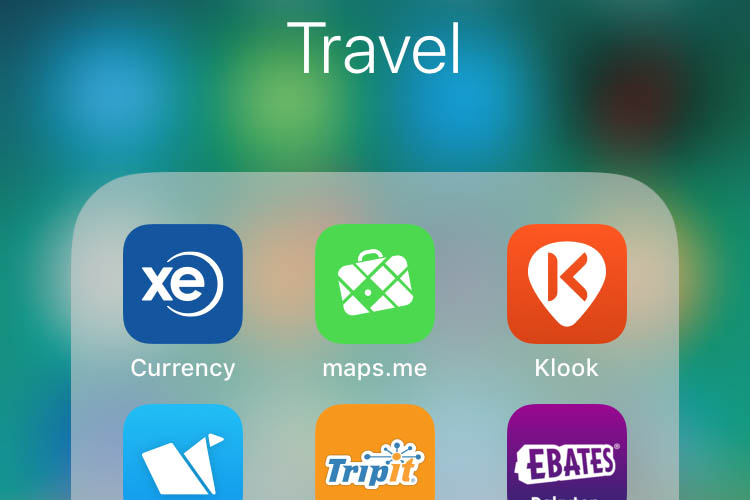
17 Essential Travel Apps to Download Before your Next Trip (2025 Guide)
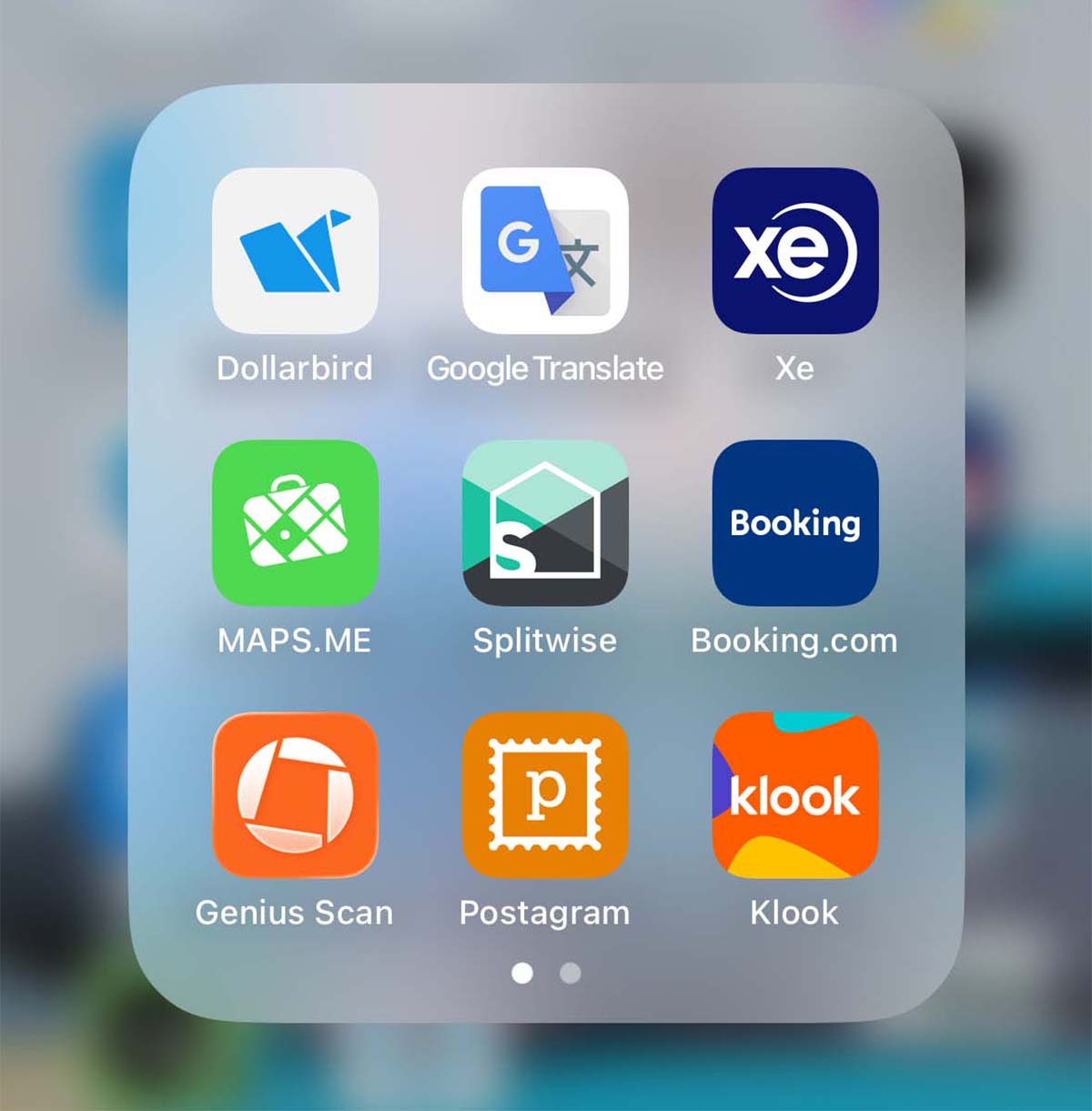
In 2002, I took my first trip overseas to study abroad in England. Smartphones didn’t exist. Texting wasn’t even a thing yet. While the nostalgic part of me misses the days of paper maps and film cameras, smartphones do make travel and life a lot easier.
I’m almost halfway through a seven-month trip abroad to three different continents, and I keep trying new apps to simplify my travels and life. Here’s a recap of the best travel apps from discount booking sites, currency converters, and making your own postcards. There are even apps for planning the perfect outdoor photoshoot and filing travel insurance claims. Most have free versions available on all phone platforms and many have web versions!
Affiliate links are used in this post. If you make a purchase, I earn a small commission at no cost to you, which goes toward the cost of maintaining this blog.
In this Article
The apps are organized in the following categories:
Expense Tracking & Currency Apps
Health, Safety & Logistics Apps
Photography & Entertainment Apps
Discount Travel Booking Apps
Klook (Free)
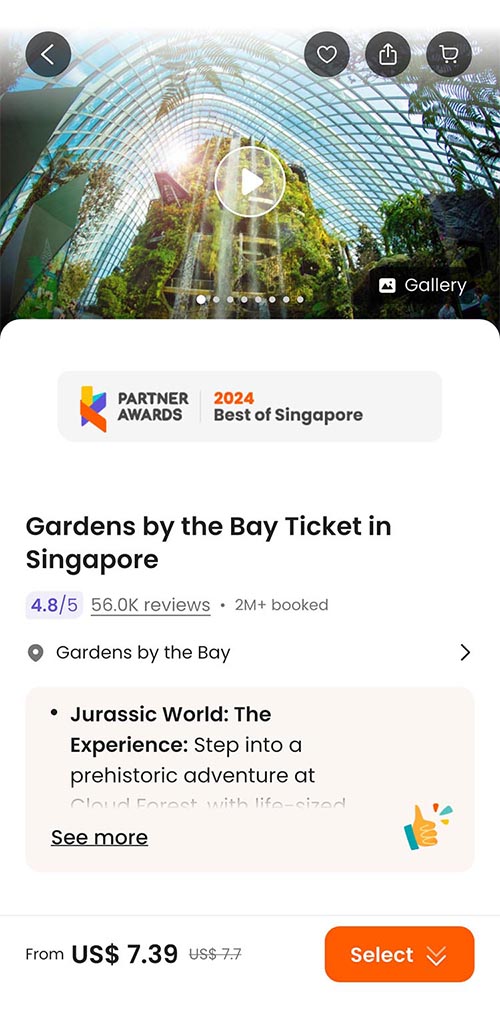 The Klook app allows me to skip ticket lines!
The Klook app allows me to skip ticket lines!
I’ve used Klook to buy discounted admission tickets and transportation online across the world. It saved me roughly $10 on entry to Gardens by the Bay in Singapore and $13 on the cable car to the big Buddha in Hong Kong. I’ve also used it for private transfers in Vietnam.
The best part of the app is the tiered Klook Rewards program, where users earn KlookCash to redeem on future purchases. Additional points can be earned by posting reviews. The free loyalty program includes member-only rates and exclusive perks. Overall, I’m a big fan because it saves me money, and I never have to stand in long queues. Book on the app or directly on the website.
Booking.com (Free)
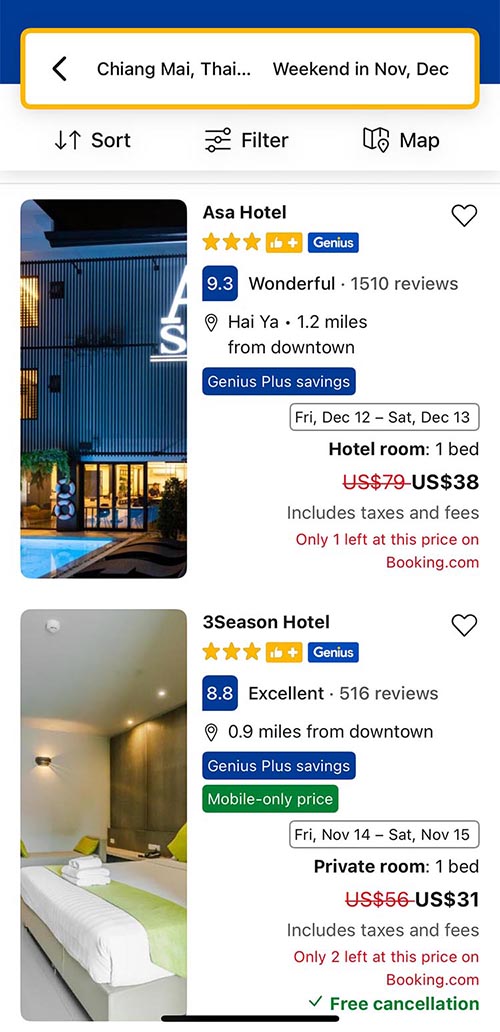
Take advantage of Booking.com’s cheaper mobile rates in the app.
The majority of the time, I find Booking.com has the lowest rates for accommodation, especially when booking on their mobile app where prices can be 15-30% cheaper than booking on their website. (I’ve written a deep dive into why mobile rates are cheaper.) Now that I’ve reached tier three of their Genius loyalty program, I get even more discounts. When pricing accommodation, cars and even flights, it’s worth doing a quick mobile search on Booking.com’s app to compare with other platforms.
Finance Apps
XE Currency Converter (Free)
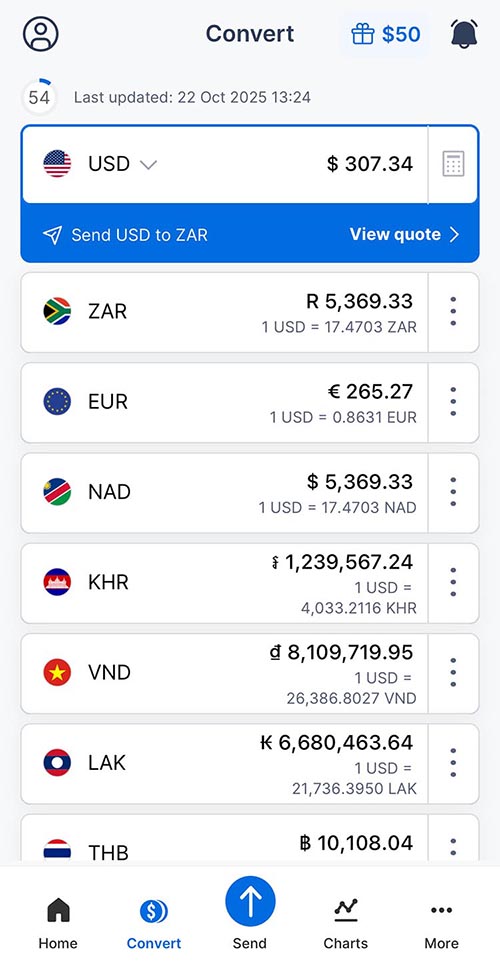 The free XE Currency Converter even works offline with the last updated rate.
The free XE Currency Converter even works offline with the last updated rate.
XE is my favorite currency app. It allows you to add up to 10 currencies and switch easily been them. The best part is that it even works offline using the last updated rate. I use this all the time to check the cost of things to make sure I’m not overspending.
TIP: If you have the option to pay in different currencies, check the rate for both to see which is cheaper. It’s almost always cheaper to pay in the local currency than in USD, which I dig into deeper in my travel banking post.
iPhone Calculator App Currency and Unit Conversion (Free)
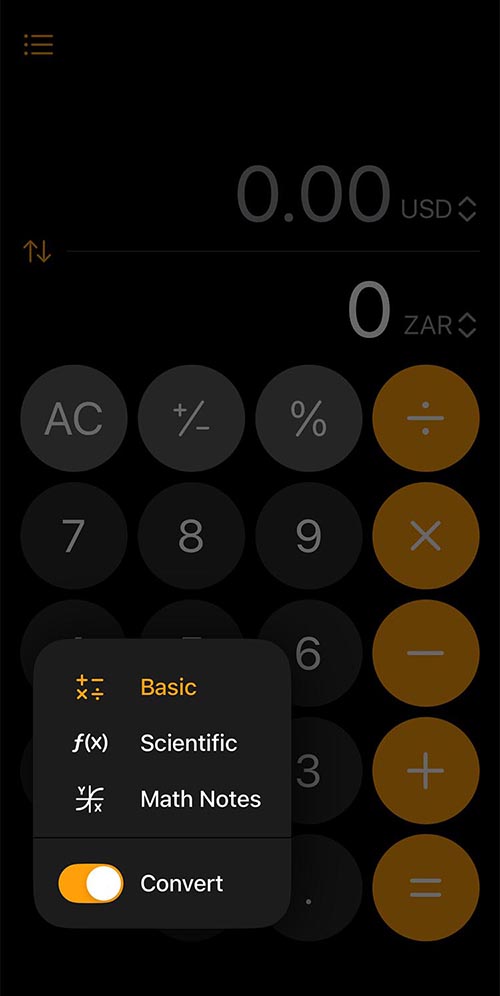
The iPhone calculator app has a feature that allows you to convert currency and units.
When Apple introduced iOS 18 in September 2024, it included a conversion function in the calculator that allows you to convert categories ranging from currencies to units (speed, time and weight). To access the feature, click on the calculator symbol to the left of the 0 button, then turn on Convert. Use the arrow to choose the unit or currencies to convert from.
Dollarbird (Paid)
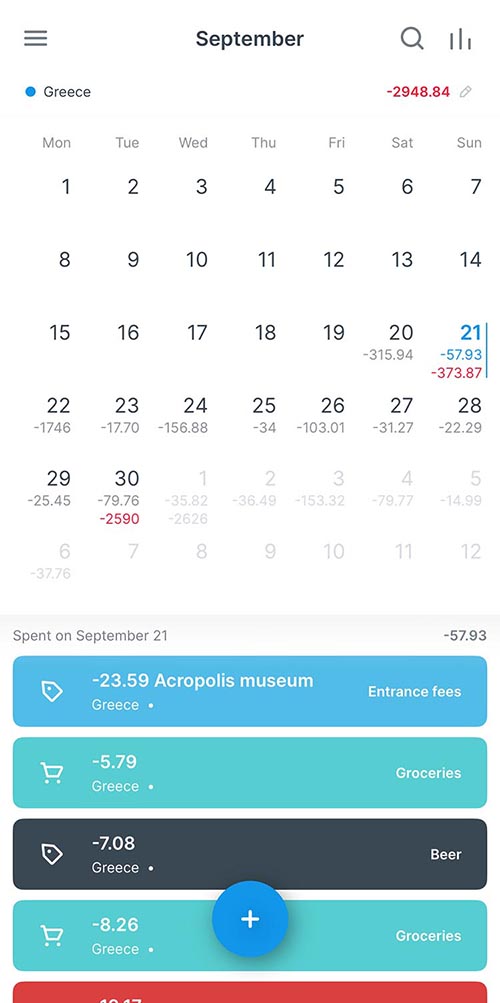 I’ve used Dollarbird for years to track my travel spending. I’m currently using it for my two-month Africa trip.
I’ve used Dollarbird for years to track my travel spending. I’m currently using it for my two-month Africa trip.
Dollarbird is a expense tracking app that I use to track my spending on my travels. (It’s $4.99/month or $39.99/year.) It can be used for your regular budgeting. I make custom categories and manually add my expenses. It provides a running balance summary and allows you to export the data to a spreadsheet. (I only use it to track expenses, not income.) I used it to create the charts in my previous blog post about the real cost of travel, where I tracked my expenses for a seven-month South America trip.
Splitwise (Free)
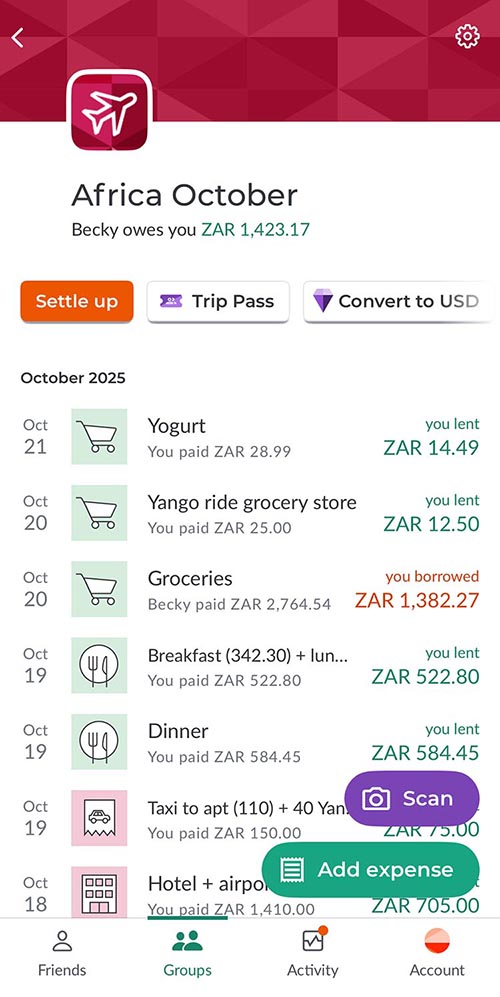 I’m currently using Splitwise to track my Africa travel expenses.
I’m currently using Splitwise to track my Africa travel expenses.
I wish I’d discovered this app sooner! This is the easiest way to split expenses with friends. You add items and can easily select the people and amount (full amount, half, percentage, etc.) you are owed. It keeps track and allows you to settle via PayPal or on your own. The only caveat is that if you add expenses in different currencies, it won’t convert them to a single currency for you. It will just give you a balance for each currency separately.
A few years ago, the app introduced a limit for free accounts to only three expenses per day per person. (You also have to watch a 10 second video.) When this happened, I was annoyed and tried all the free expense splitting apps. Turns out, Splitwise is still the best, and I now begrudgingly tolerate the three-expense limit. (If the app was a flat fee for life like $20, I’d just buy it, but I’m not paying an annual subscription just to use a few times a year.)
Genius Scan (Free)
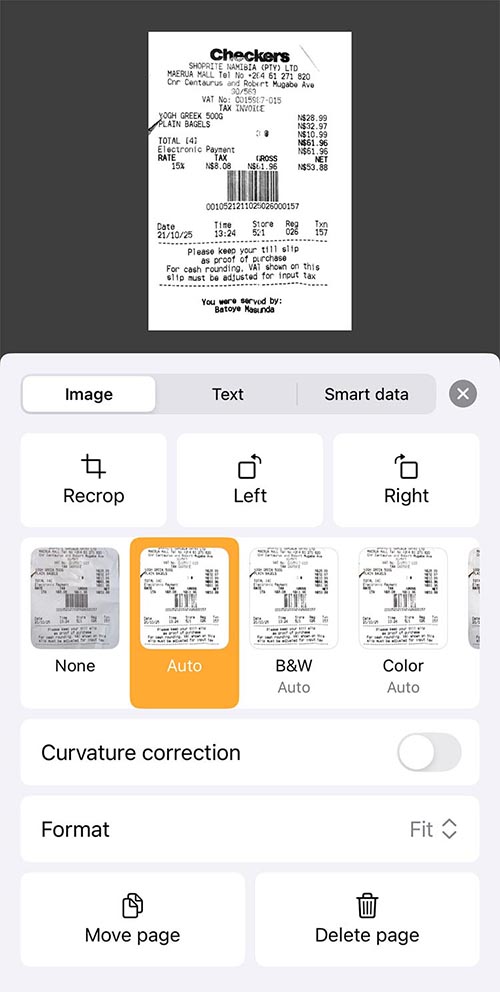 Genius Scan helps sort my receipts for taxes and work travel. I export the files to my Mac as a backup.
Genius Scan helps sort my receipts for taxes and work travel. I export the files to my Mac as a backup.
This PDF-scanner app is super helpful. It allows you to photograph anything – receipts, maps, brochures—and make a PDF file from the documents. It’s the best for tracking expenses for business travel. You can take photos through the app or import them from the camera roll on your phone. I find it useful for both tracking receipts when I travel and sending them to Dropbox. I also use it to photograph brochures to reduce my paper usage. The PDFs can be easily sent via email, AirDrop and messaging apps.
1Password (Paid)
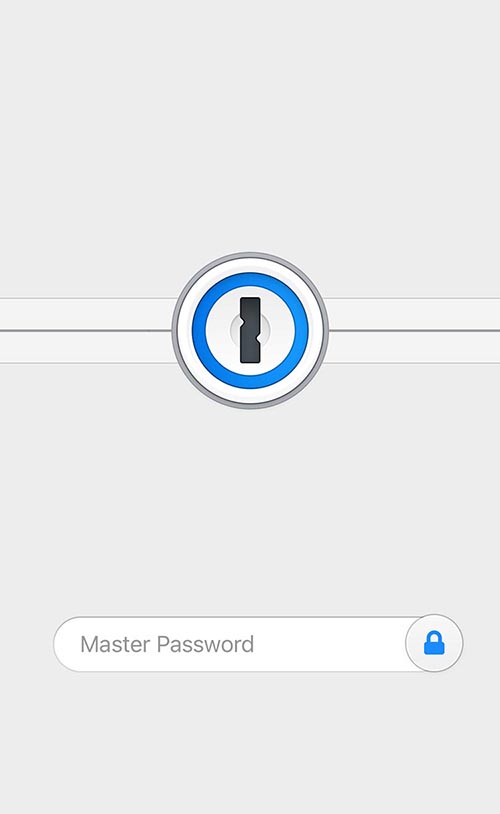 1Password helps manage passwords, bank accounts and loyalty programs. It’s secure and allows you to copy and paste numbers for online shopping.
1Password helps manage passwords, bank accounts and loyalty programs. It’s secure and allows you to copy and paste numbers for online shopping.
1Password is my favorite app of all time, even when I’m not traveling. The app securely stores and organizes all your passwords in one place. It’s easily searchable for what you need. I keep EVERYTHING in it – bank details, frequently flyer accounts and email passwords. It syncs across devices easily and is very secure. You use one password to open the app. (TIP: Use a password that you’ve never used elsewhere.) I use it to copy and paste my credit card number when shopping online.
While the app isn’t free, it’s inexpensive – $2.99/month or $4.99 for a family of 5. There’s a free 14-day trial. (Full disclosure: I got this app for free through an old job, so I don’t pay for it.) While Apple has introduced the free Passwords app, I find 1Password to have a better interface and organization system when it comes to credit cards and membership numbers, etc.
Communication Apps
Airalo (Free)
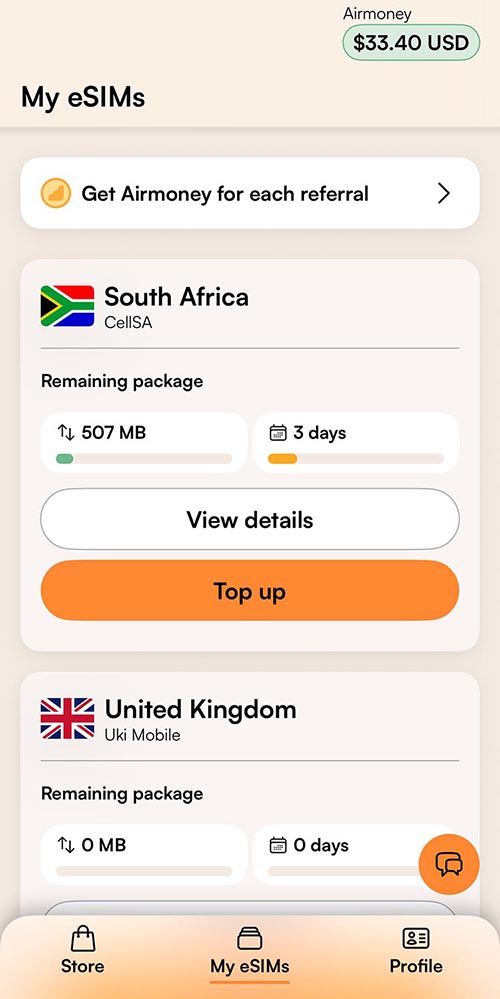
Airalo eSIMs make it easy and affordable to stay connected while traveling.
eSIM cards are an affordable way to stay connected abroad. The Airalo app makes it easy to purchase, install and monitor your balance while traveling across over 200 countries and regions. Airalo was the world’s first eSIM store and often has the best partner networks abroad.
Use promo code NEWTOAIRALO15 for 15% off your first purchase. Existing users can save 10% with AIRALOESIM10.
Google Voice (Free)

Google Voice is an easy way to call U.S.-numbers for free while abroad.
As someone who travels most of the year, two-step verification is the bane of my existence. Google Voice has changed this—I’ve started using it as my phone number for two-step verification. (If you have trouble with codes coming through on the app, log in on your computer.) Google Voice allows you to have a second phone number to use for calls, texts and voicemail. To set up, you need an existing Google account and phone number. U.S. and Canadian users can choose their phone numbers. Google Voice is also available in select European countries.
You can also call U.S. numbers for free so it’s easy for me to call family members or even airline customer service, etc. (Google Voice has been my replacement for the now-defunct Skype. RIP.)
Google Translate (Free)
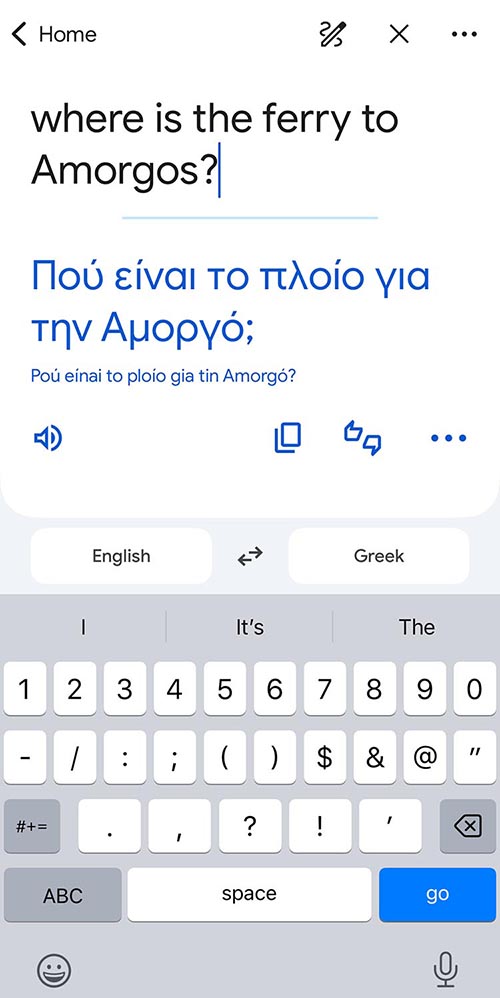 Google Translate offers both text and photo translations.
Google Translate offers both text and photo translations.
Google Translate has been a lifesaver. I simply type a phrase and show it to my taxi driver or anyone I need to communicate with. It also lets you save phrases to use later. There’s a camera option so you can translate labels, which is helpful if you’re trying to find lotion that doesn’t have whitening cream in it in Asia. (It’s nearly impossible in Vietnam.) My favorite app in Spanish speaking countries is SpanishDICT, it allows you to translate phrases and also provides conjugations.
WhatsApp (Free)
The chances are high that you are already using WhatsApp. If not, then you need to download this text and voice message app NOW. The app is owned by Meta and works across all phone platforms and locations. It’s a great way to connect with friends and even business when you are traveling. Outside of the U.S., it’s the primary means of personal and business communications, from booking dinner reservations to taxis. You’ll need a phone number to register.
Postagram (Free;$1.60-$2/postcard)
 This is a postcard I sent my Aunt with one of my own photos of my globetrotting gnome, Alfred. I’m a big fan of the Postagram app and how you can customize everything including delivery dates so I never miss a birthday!
This is a postcard I sent my Aunt with one of my own photos of my globetrotting gnome, Alfred. I’m a big fan of the Postagram app and how you can customize everything including delivery dates so I never miss a birthday!
Let’s be honest—everyone appreciates real mail! I’ve spent countless hours on trips writing postcards to friends and family, and even more time waiting in endless post office lines just to buy stamps! (I spent thirty minutes in Greece a few weeks ago waiting in line to buy postcard stamps, which were 2 Euros each!)
I’ve used the Postagram app for years to send printed postcards using my photos. The app allows you to customize the background design and colors. The most important feature is that it allows you to schedule a delivery date, so I never miss a birthday or holiday.
While I still send real postcards when I can, Postagram has been the next best option. International locations cost $3/card while U.S. addresses start at $2 but decrease in price if you buy in bulk. The printing quality is excellent. (Full disclosure: I did have an issue once when a postcard did not arrive, and they resent it for free.)
Health, Safety & Logistics Apps
Maps.me (Free)
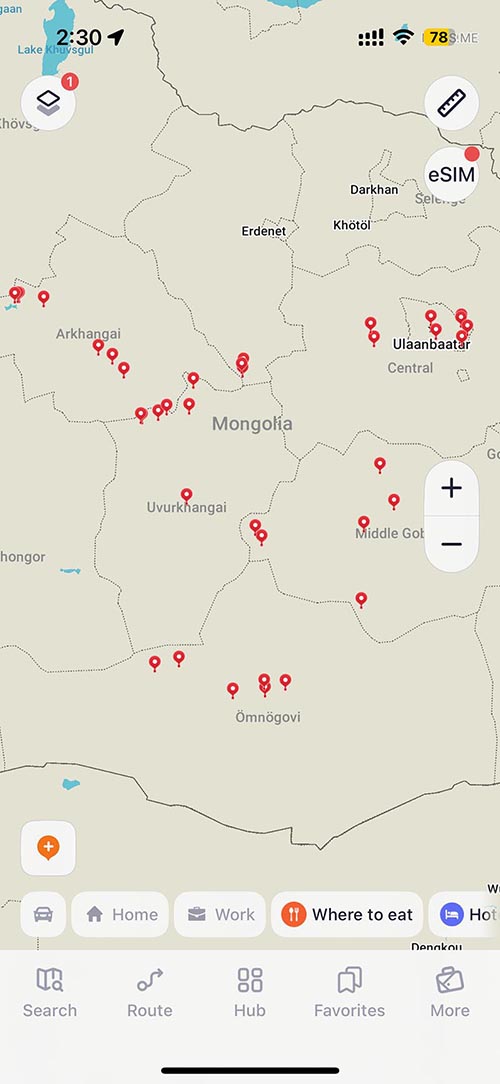
I used Maps.me to track all the places we stopped on my Mongolia trip. It’s a great, customizable offline map tool.
The offline GPS app Maps.me is a must-have for all hikers and anyone traveling to areas without phone service. Simply download a map of where you are going, and the app will help you navigate turn-by-turn efficiently without phone service. It allows you to create and edit routes, which many hikers share online. Read the app user guide before using it in remote locations. The app was initially completely free, but now, they’ve added in-app purchases and the ability to make travel bookings. The free version allows 10 downloaded maps at a time.
I loved using this for my Mongolia trip, which was 90% off-road, to label all the locations where we stopped. I’m road tripping around Namibia next month and will be using it again for that.
SafetyWing Travel Medical Insurance
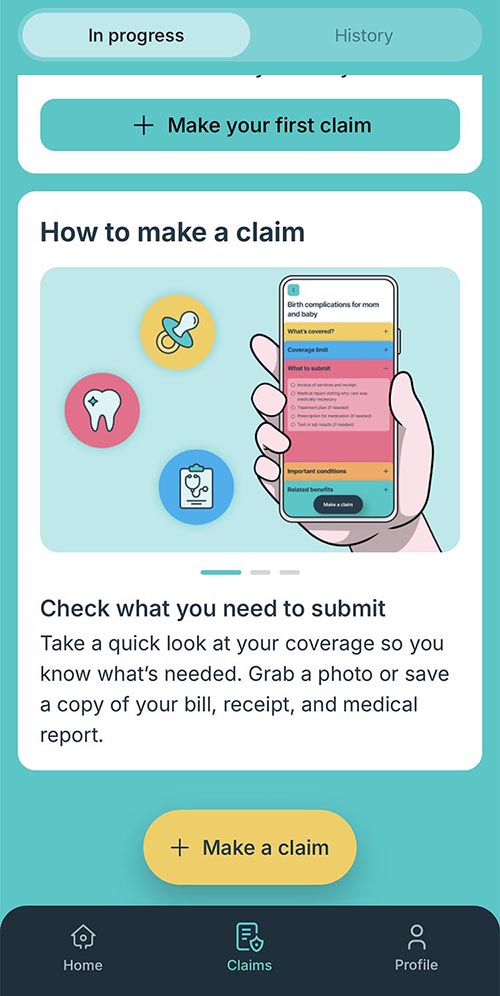
SafteyWing offers affordable travel medical insurance for 180+ countries.
SafetyWing is currently my go-to company for flexible travel medical insurance. They offer two plans: Essential and Complete. (I always use the Essential plan.) The new claims process can be done in the app in just five minutes. For more details, check out my SafetyWing review.
NordVPN (Paid)
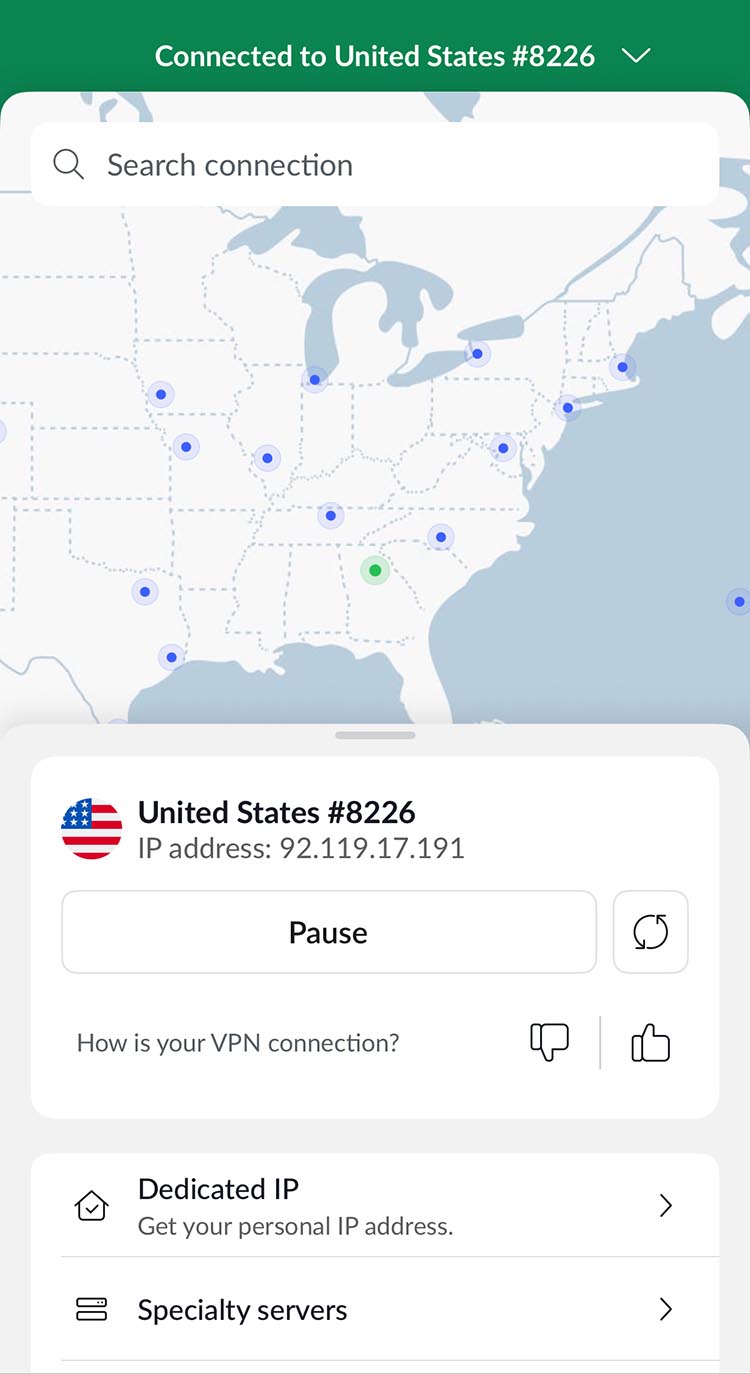 NordVPN makes it easy to safely browse the internet from any corner of the globe.
NordVPN makes it easy to safely browse the internet from any corner of the globe.
I started using NordVPN about four years ago to protect my data and identity online while traveling both in the U.S. and abroad. It just makes it safer to browse the internet, check up my banking and even to use streaming services, like Disney+, which sometimes are location dependent. I usually buy a two-year subscription that works on both my Mac and iPhone.
AirVisual (Free)
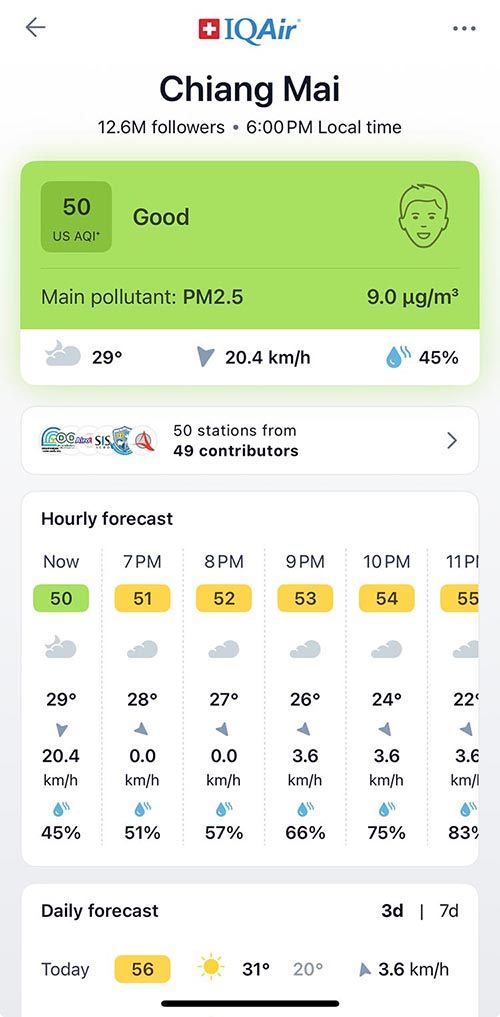 AirVisual makes it easy to track the air quality anywhere you are traveling.
AirVisual makes it easy to track the air quality anywhere you are traveling.
If you’re traveling anywhere in Asia, then I recommend the free AirVisual app to check the air quality. It uses sources from government agencies to tell you the current air quality. It’s really helpful in places with pollution (India) or burning seasons like Chiang Mai, where you might need to wear masks! It works worldwide.
Photography & Entertainment Apps
TPE Photo Ephemeris (one-time fee of $9.99)
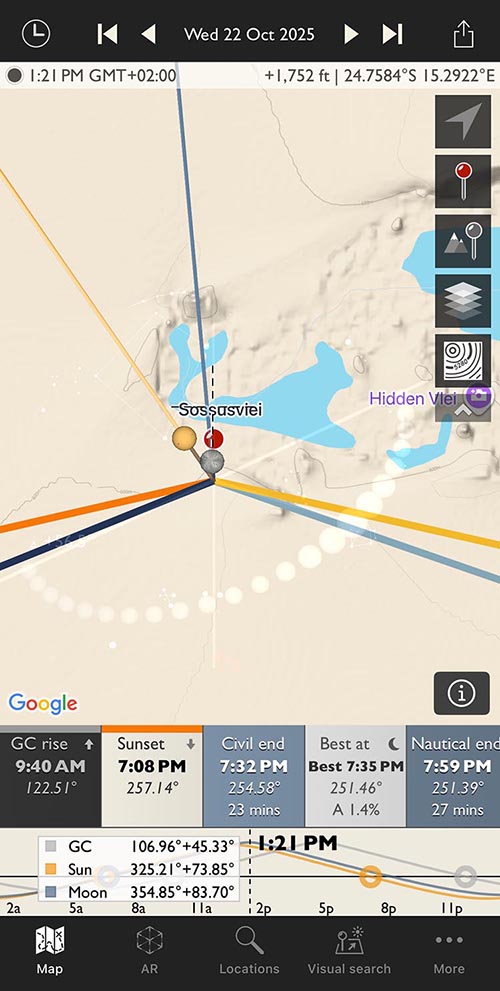 TPE is my go-to app for planning outdoor photo shoots based on the sun’s location.
TPE is my go-to app for planning outdoor photo shoots based on the sun’s location.
This photography app is life-changing for photographers because it allows you to plan outdoor shoots in natural light. TPE shows where the light will fall on any part of the globe both day and night. The AR feature lets you visualize a shoot by overlaying the features over your camera app in a location. The app has a one-time $9.99 fee and additional in-app purchases.
Hoopla (Free)
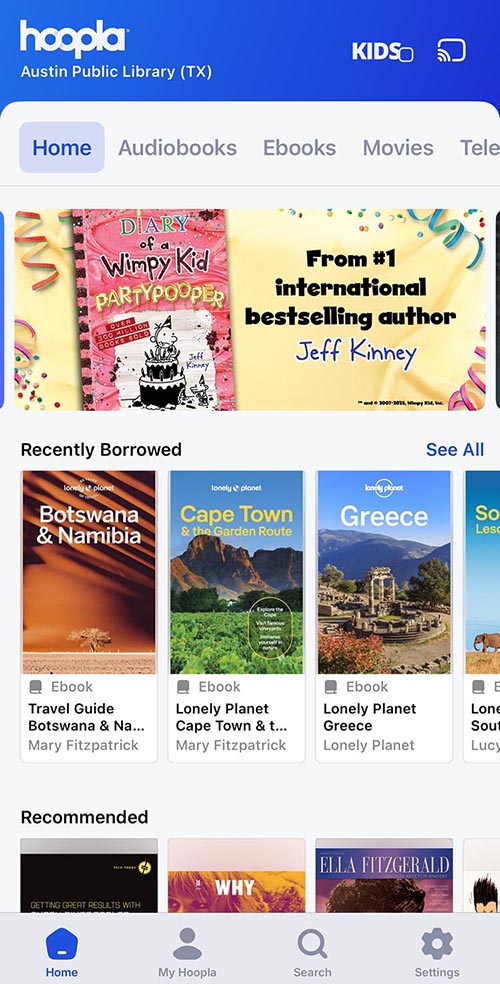 I read a lot more books thanks to the Hoopla app and my public library membership.
I read a lot more books thanks to the Hoopla app and my public library membership.
Hoopla is an online platform that allows you to read eBooks and listen to audiobooks for free with your public library membership across North America. It also works on web browsers. I use it a lot for travel guides and audiobooks when I travel. There’s a monthly limit for the number of books you can check out that varies based on your library membership. I get four per month from the library in Austin. This is also great to use when you aren’t traveling.
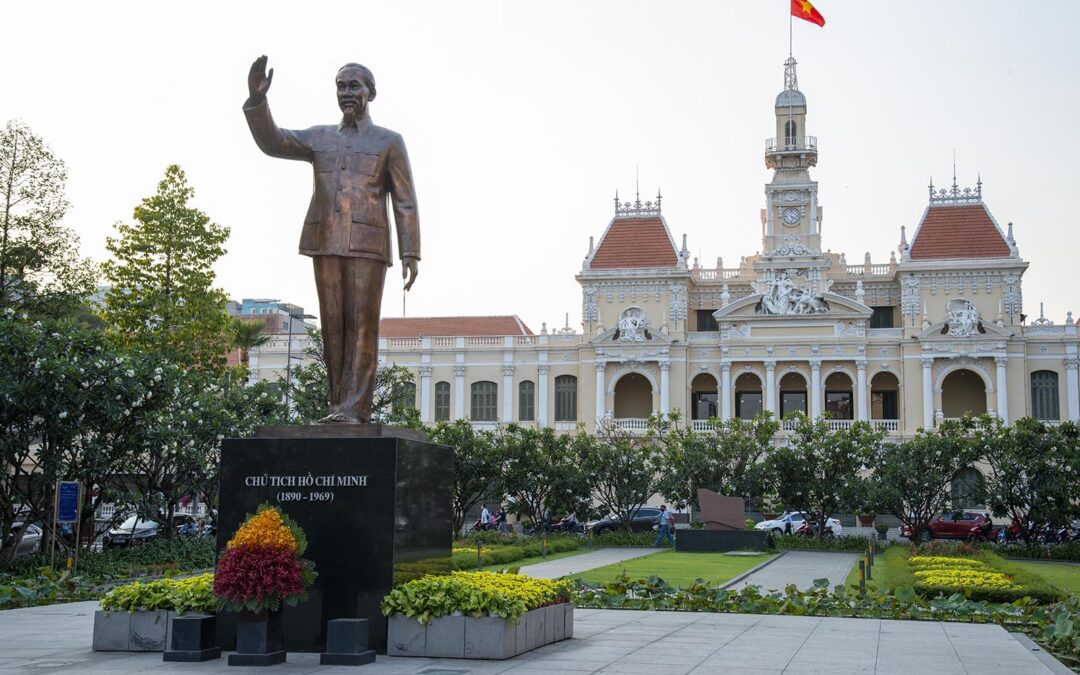
9 Things to do in Ho Chi Minh City (Saigon) that are Actually Worth Your Time
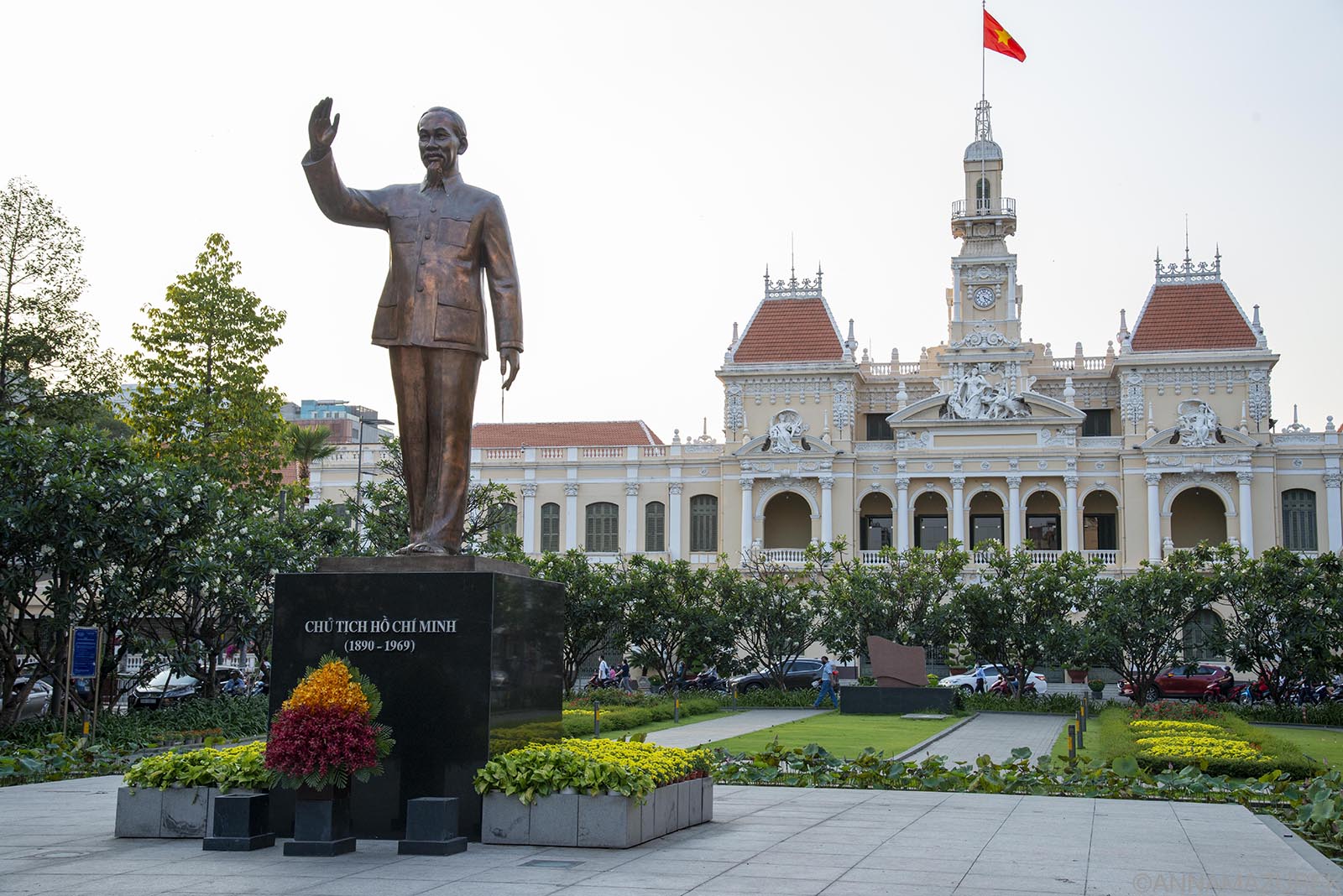 A statue of Ho Chi Minh sits outside the People’s Committee of Ho Chi Minh City building on Nguyen Hue Walking Street.
A statue of Ho Chi Minh sits outside the People’s Committee of Ho Chi Minh City building on Nguyen Hue Walking Street.
Ho Chi Minh City (Saigon) is the sleek modern paradox to Hanoi’s ancient streets. With a population of eight million, the city is flooded with motorbike traffic—crossing the street isn’t for the faint of heart—and towering skyscrapers. While most of the main sights in District 1 are war-related, the city has an unmistakable vibe that will make it hard to leave and some of the best craft beer in Asia.
These recommendations are based on my experience living and working for travel companies in Southeast Asia for the past decade. (I visit Vietnam at least once a year for work.) Ho Chi Minh City, known as HCMC, has a vibe that I just can’t shake—I love chilling here for a few days eating and hitting up the breweries.
Here are the best things to do in Ho Chi Minh (Saigon), along with the best time to visit and where to stay!
You can easily do all these things on your own, but if you’re short on time, consider a city tour.
Affiliate links are used in this post. If you make a purchase, I earn a small commission at no cost to you, which goes toward the cost of maintaining this blog.
Plan Your Trip
Currency: Vietnamese Dong (VND)
When to Go: November to April for dry weather.
Travel Insurance: Protect yourself with SafetyWing travel medical insurance to cover accidents and travel delays.
Mobile eSIM Card: Get seamless connectivity worldwide with Airalo minus the hassle of physical SIM card.
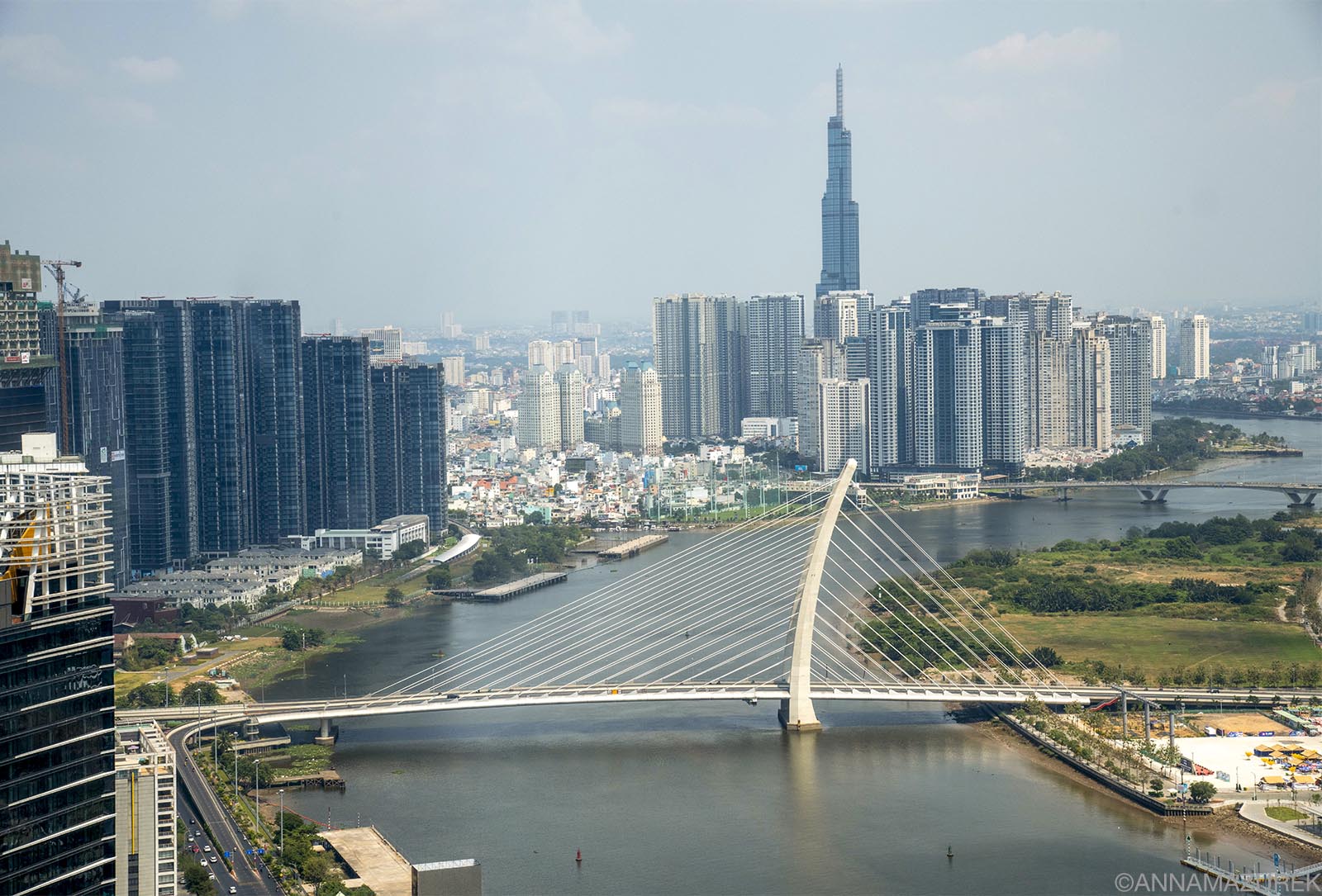 The view of the Landmark 81 building from the Bitexco Financial Tower.
The view of the Landmark 81 building from the Bitexco Financial Tower.
1. Bitexco Financial Tower
Nothing puts the massive size of the city into perspective like the view from the 49th floor of the Bitexco Financial Tower ($9 USD) in District 1. (I suggest buying tickets in advance through Klook for your preferred time slot because it’s the same price as buying in person without any lines.)
An alternative with a higher view and slightly steeper admission rate ($12 USD) is the Landmark 81—a nearby District 1 skyscraper that was the tallest building in Southeast Asia until 2024 when the Merdeka 118 Tower opened in Kuala Lumpur. Combo tickets can be bought on Klook to avoid the queue. (I haven’t found any other way to buy them online.)
2. War Remnants Museum
This powerful museum is devoted to showcasing the impact of the U.S. invasion of Vietnam on civilians from a Vietnamese perspective in eight thematic exhibitions with over 20,000 artifacts. (Please note the Vietnam War is often referred to as the American War across the country.) The images of the atrocities, horrific destruction and effects of Agent Orange are upsetting, so prepare yourself emotionally before visiting. While it’s a deeply moving experience, visiting the museum is essential for gaining a larger understanding of the conflict and modern-day Vietnam.
The upstairs Requiem Exhibition showcases the work of photographers on both sides killed during the conflict, including Robert Capa. The grounds display a series of U.S. armored vehicles, weapons and bombs. Allow an hour or two to visit. Tickets can be bought in advance on Klook ($1.85 USD).
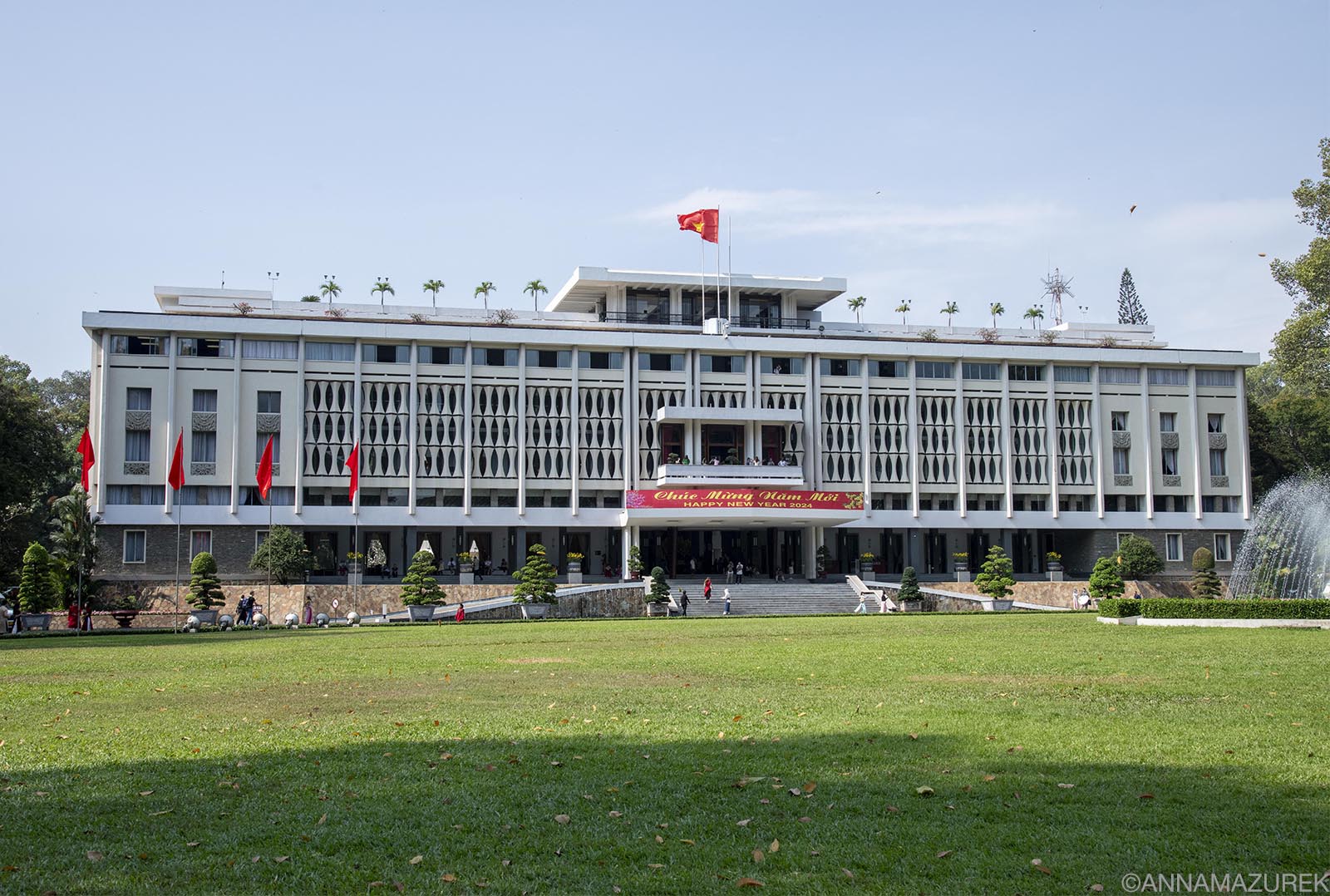 The Reunification Palace was the home and office of the president of South Vietnam.
The Reunification Palace was the home and office of the president of South Vietnam.
3. Reunification Palace
Once you’ve wrapped your head around the size of the city, start digging into the history. This airy 1960s government building is a landmark—Communist tanks rolled through the gates on April 30, 1975, marking the fall of Saigon during the Vietnam War. The building, also known as the Independence Palace, was formerly home to the South Vietnamese president and originally the site of the 1868 French governor-general of Cochin-China. The interior features lavish reception rooms and the president’s living quarters. The most interesting part is the basement war room and telecommunications center featuring a photogenic collection of vintage rotary phones. Tickets are $1.89 USD and can be bought in advance on Klook.
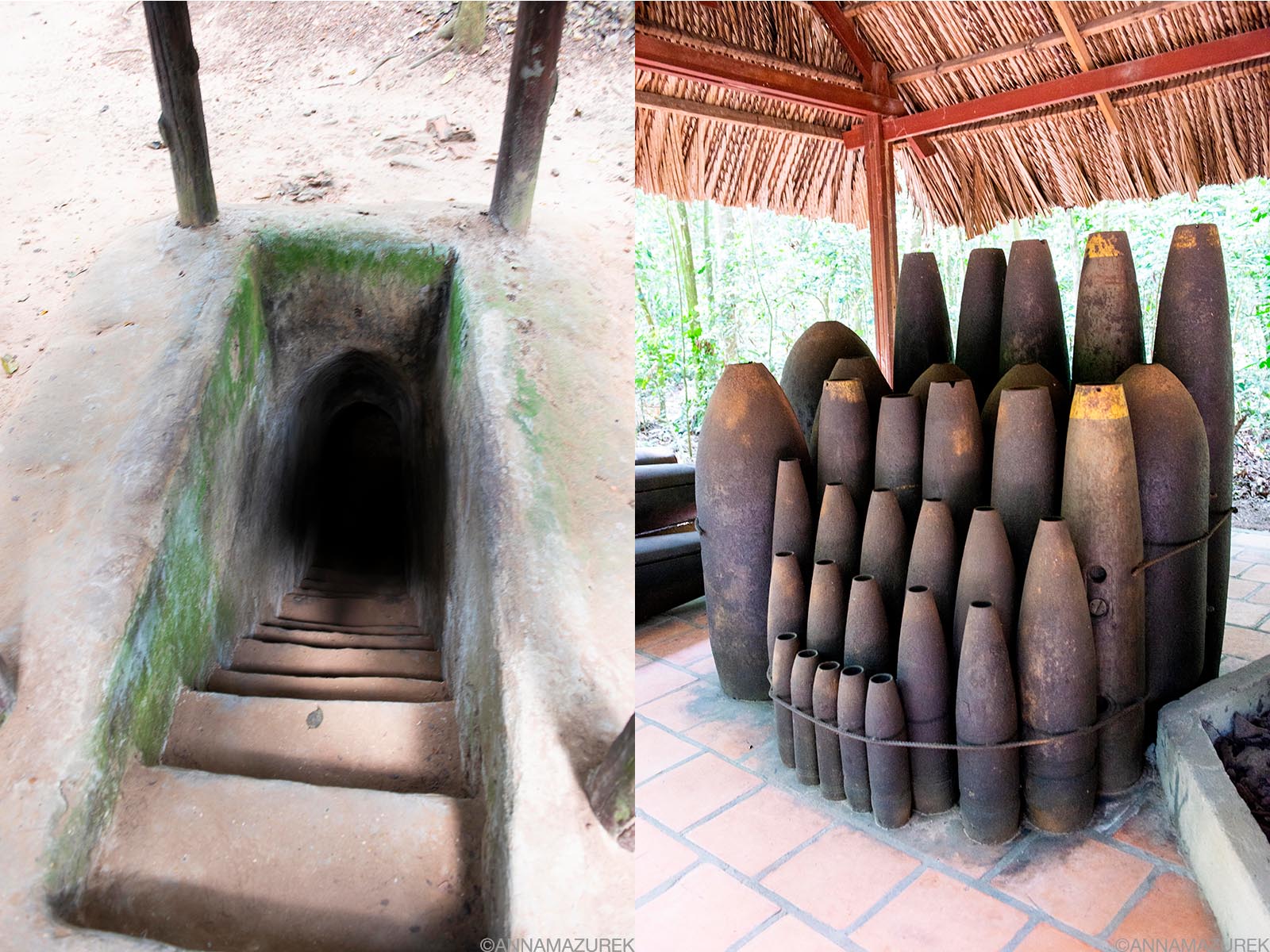 Left: The entrance to one of the Ben Douc tunnels, part of the Cu Chi Tunnels. Right: Artillery left over after the Vietnam War.
Left: The entrance to one of the Ben Douc tunnels, part of the Cu Chi Tunnels. Right: Artillery left over after the Vietnam War.
4. Chu Chi Tunnels
No trip to Saigon is complete without a visit to the spiderweb of narrow tunnels used by the Viet Cong in the 1960s.There are two sets of tunnels, Ben Dinh and Ben Duoc, located 30 to 40 kilometers from the city. Ben Dinh is the most touristy one because it’s more easily accessible by a scenic boat ride or a day tour.
I’ve been to both and prefer Ben Duoc because it’s not as touristy—there was only a handful of people when I went. (I went by public bus from District 1 in Saigon, which I highly recommend—it’s one of my favorite experiences in Vietnam. For details, I wrote a post about how to get to the Ben Douc tunnels by public bus.) You need a full day to go by bus to Ben Duoc. If you have less time, consider booking a half-day tour to Ben Dinh from Klook.
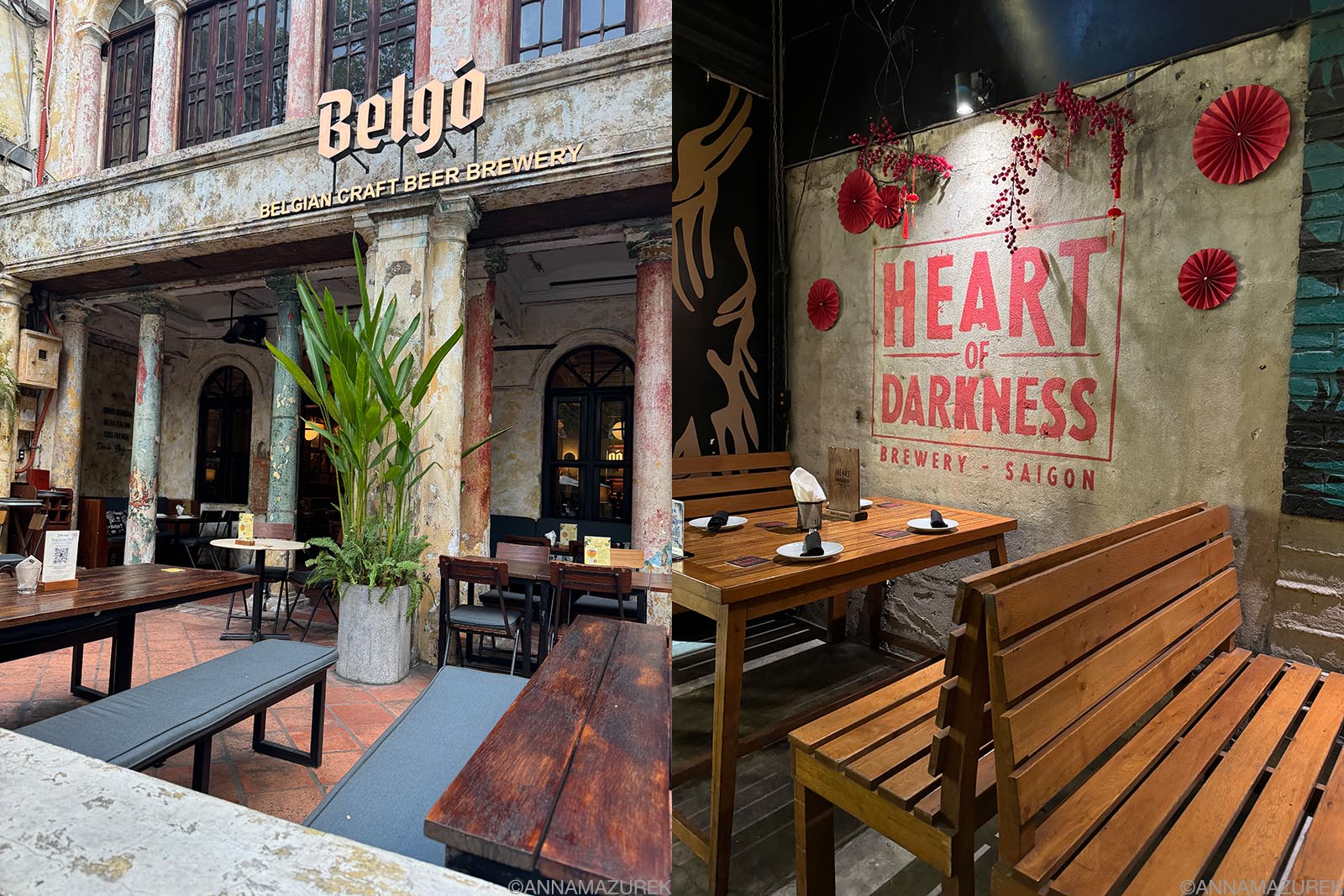 Belgo (left) and Heart of Darkness (right) are two craft breweries with great patios.
Belgo (left) and Heart of Darkness (right) are two craft breweries with great patios.
5. Sample Saigon’s Craft Beer Scene
One of my favorite things to do is brewery hop around HCMC—the craft beer capital of Southeast Asia. Pasteur Street Brewing ignited the trend in 2015 and has multiple taprooms (all serve food) spread across the city (and one in Hanoi). I love the vibe of their original location on Pasteur Street. (The flagship Jasmine IPA and Pomelo IPA are my favorite brews.)
The Heart of Darkness taproom is always hopping on weekends and serves up some tasty hazy IPAs. (I’m an IPA girl if you can’t tell.) A new addition to the scene— Belgo, a Belgian brewery—is quickly becoming a favorite because the patio, beer and food are fantastic. BiaCraft is also a great spot.
 The Nguyen Hue Walking Street decorated for Lunar New Year (TET) in HCMC.
The Nguyen Hue Walking Street decorated for Lunar New Year (TET) in HCMC.
6. Nguyen Hue Walking Street
This pedestrian-only walking street stretches 900 meters from the photogenic People’s Committee of Ho Chi Minh City building to the Saigon River. It comes alive on weekend nights with street performers and food stalls. During special occasions like Lunar New Year, it’s heavily decorated. This is one of my favorite parts of the city. It’s the perfect place for people watching and a sunset walk.
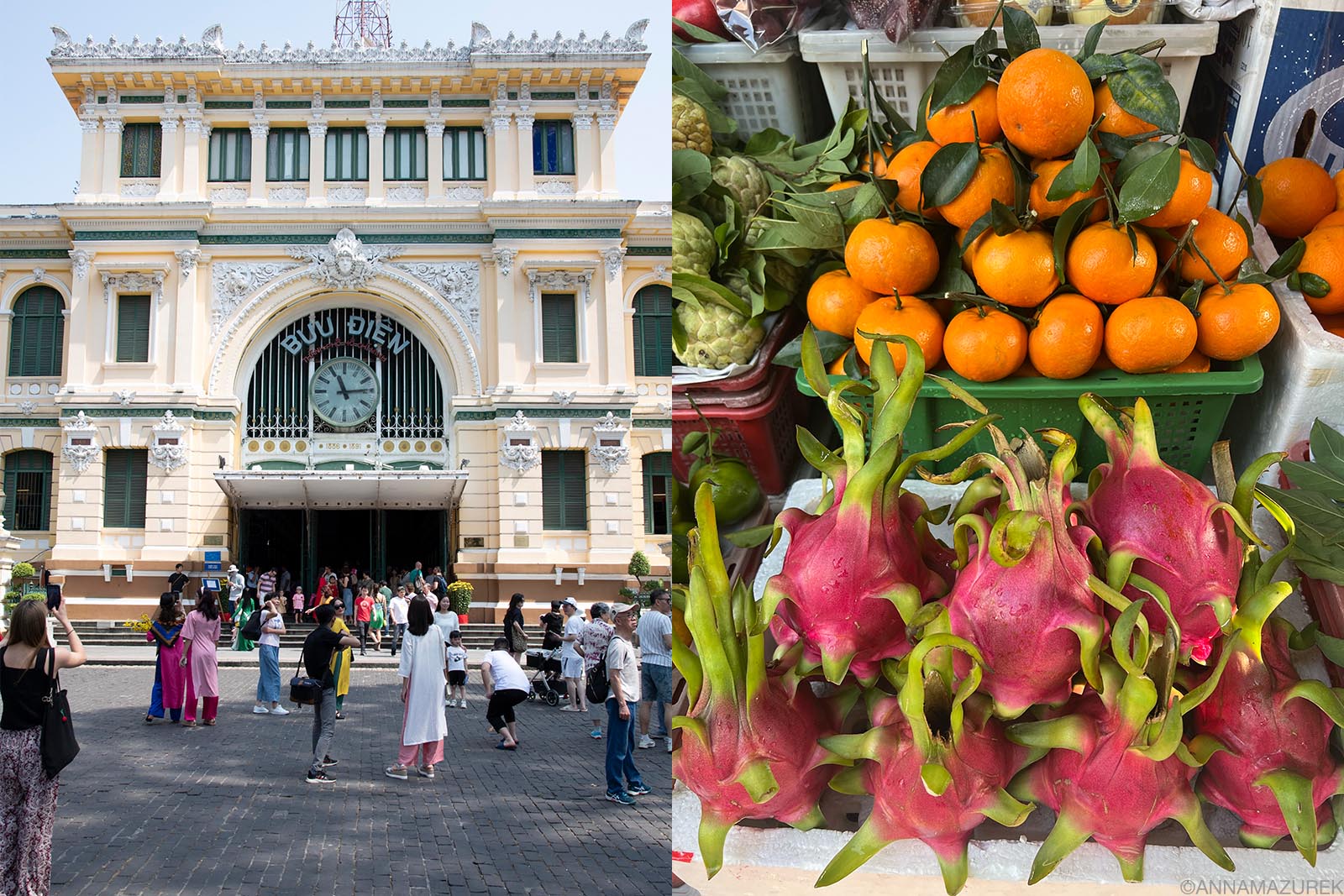 Left: The Central Post Office. Right: Fruits for sale at the Ben Thanh Market.
Left: The Central Post Office. Right: Fruits for sale at the Ben Thanh Market.
7. Take an Architecture Walk
Go for a stroll to visit some of the city’s late 19th-century French colonial buildings. The 1897 Opera House exterior is stunning. For a view of the interior, you’ll have to attend a show—one of the frequent AO Show performances combining acrobatics, music and dance, or a production of the Ho Chi Minh Ballet Symphony and Opera.
You can’t miss the yellow and green façade of the French-era Central Post Office. The interior is a working post office with side hallways filled with stalls hawking tourist trinkets that distract from the tiled floors and Ho Chi Minh mosaic. Across the street is the Notre Dame Cathedral, which has been flanked by restoration scaffolding since 2017. The interior is only open during mass times until the restoration is completed in 2027.
Built before WWI, the sprawling Ben Thanh Market is always buzzing with crammed stalls selling souvenirs, clothing, produce and local street food. (Personally, I find the market too touristy and filled with junk.)
 Vietnamese water puppet shows are a fun-filled attraction for all ages.
Vietnamese water puppet shows are a fun-filled attraction for all ages.
8. Water Puppet Show
Water puppetry, a century-old form of Vietnamese theater, is a great insight into local culture. The colorful puppets depict scenes of local life in a waist-deep pool accompanied by traditional folk music. While the show is entirely in Vietnamese, it’s easy to follow along with the action and laughs. (I go to one water puppet show every year for work, and it’s really fun to experience at least once.)
The Golden Dragon Water Puppet Theater (nightly at 6:30 p.m.) and the Museum of Vietnamese History have regular performances. (You can buy tickets in person or in advance on Klook for the same price.) All water puppet shows across Vietnam have similar storylines, so no need to see shows in multiple cities.
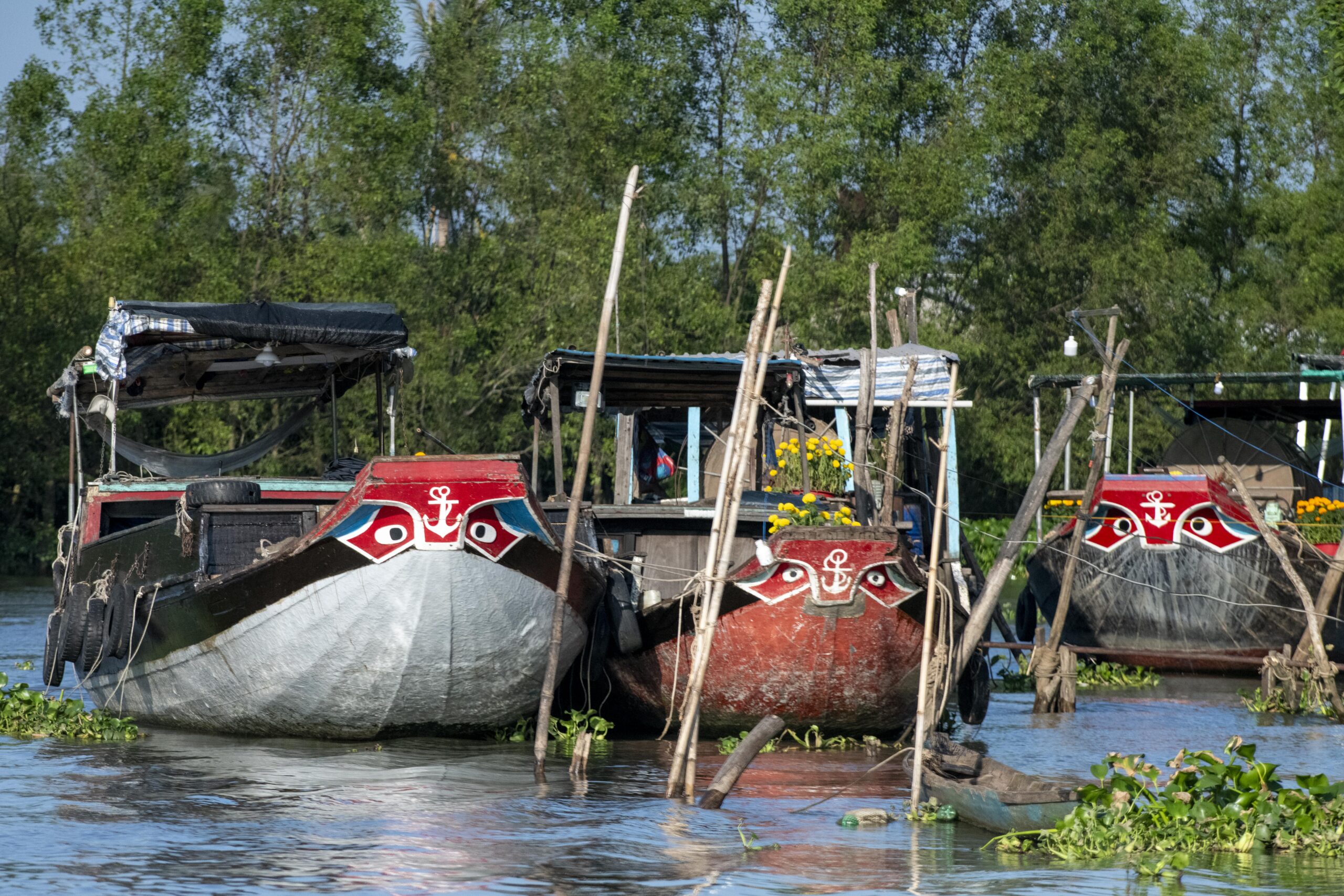 Boats along the Mekong Delta have eyes painted on the bow to ward off evil spirits.
Boats along the Mekong Delta have eyes painted on the bow to ward off evil spirits.
9. Visit the Mekong Delta
The Mekong Delta is a must-visit if you’re already in HCMC. Ideally, it’s best to spend a few days exploring the water world of bustling markets, scenic boat trips and beaches. Can Tho is the hub of all the excitement, but I love the wet market at Chau Doc. Keep an eye out for the large ships with eyes painted on the front to ward off evil spirits and sea monsters. If your time is limited, Klook and GetYourGuide offer great day and multi-day trip options.
Where to Eat in Ho Chi Minh City
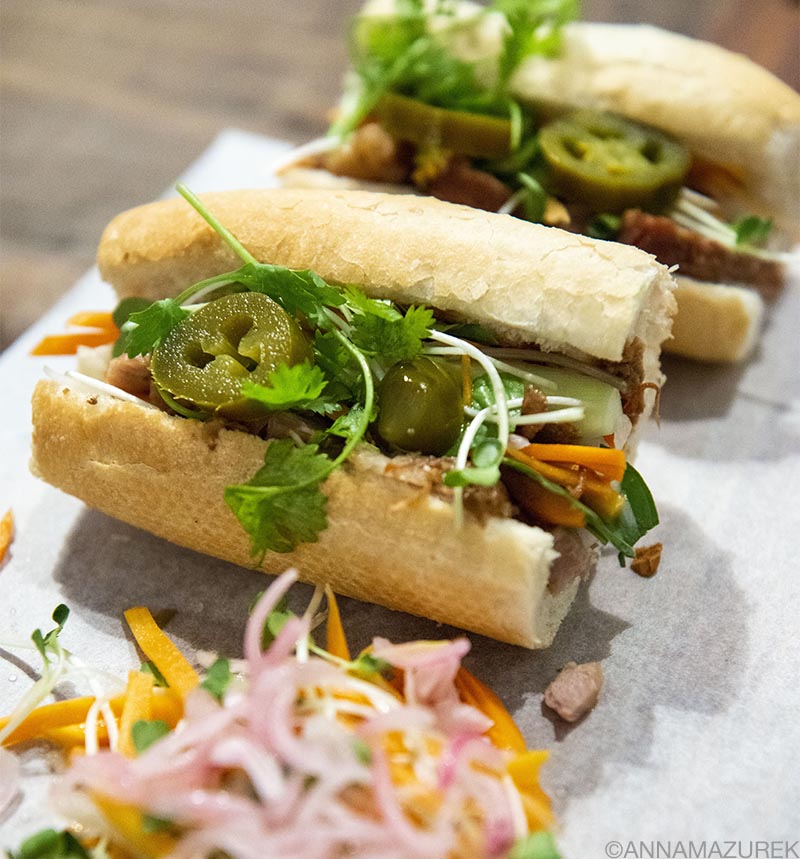 A banh mi from L’Usine.
A banh mi from L’Usine.
My favorite cafes and sandwich spots to eat are The Old Compass, L’Usine, The Vintage Emporium, and Banh Mi 3362. ABC Bakery Café was a great spot to grab a fast and cheap breakfast to go! If you are looking to splurge, the Park Hyatt’s breakfast buffet is worth the $40 because it includes all-you-can-drink Prosecco and ordering items off the menu—the banh mi and French toast are fabulous.
All the craft breweries have tasty food, but Belgo is my favorite brewery food.
Where to Stay in Ho Chi Minh City (Saigon)
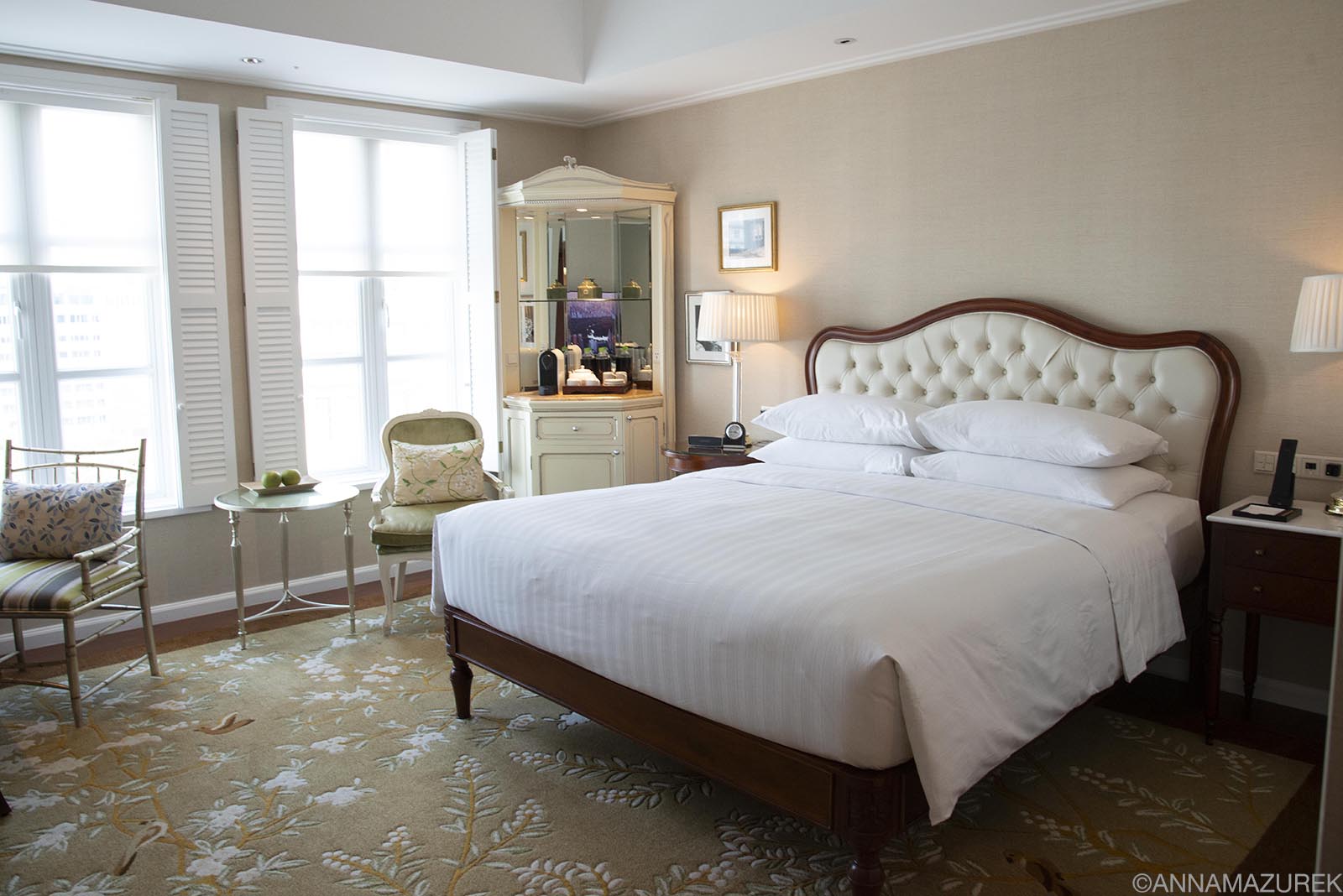 If you’ve got some credit card miles to cash in, the Park Hyatt Saigon is a great place to treat yourself.
If you’ve got some credit card miles to cash in, the Park Hyatt Saigon is a great place to treat yourself.
All of the accommodation options below are centered around District 1 where most of the main attractions are located.
Hotels: Au Lac Charner ($73/night plus taxes) is my favorite hotel with a rooftop pool in Ho Chi Minh City. It also has free breakfast (and afternoon tea!) and is located around the corner from the Bitexco Financial Tower.
Hostels: The majority of District 1 hostels are concentrated around Pham Ngu Lao and Bui Vien. While most have lackluster reviews, the conveniently located Loan Võ Hostel shines with a 9.1 rating for clean dorms and private rooms. The sleek design and bunks with curtains make The Common Room another great choice.
Splurge: If you’re looking to splurge, the Park Hyatt Saigon ($289) is the nicest hotel in town with an amazing pool, gym and a mind-blowing breakfast! (I stay at the Park Hyatt for work but at the Au Lac Charner otherwise.)
How to get to Ho Chi Minh City
Ho Chi Minh is home to the busiest airport in Vietnam and the main transport hub. (I always fly through Ho Chi Minh when I’m flying back to the U.S. from Southeast Asia because I can connect in Japan. This really helped me successfully hack my way to elite status on American Airlines.) You can take buses, vans and the train anywhere in Vietnam from there. Keep in mind that Hanoi and Ho Chi Minh are on opposite ends of the country and a 30-hour train ride apart.
I recommend booking transfers on Klook for convenience and using 12go.asia for bus and train tickets if it’s too much hassle to go to the station. Please read reviews before booking.
The Best Time to go to Ho Chi Minh City (Saigon)
HCMC has two seasons: the dry season and the monsoon. The dry season from November to April is the best time to visit. The monsoon season brings high humidity (83%!) and brief but powerful storms along with occasional flooding. (I always visit in January and February.) The air quality is often better during the rainy season because the rain cleans pollutants from the air. Consider a visit just after the rainy season for the best air quality and while all the plant life is still lush.
Vietnam FAQ
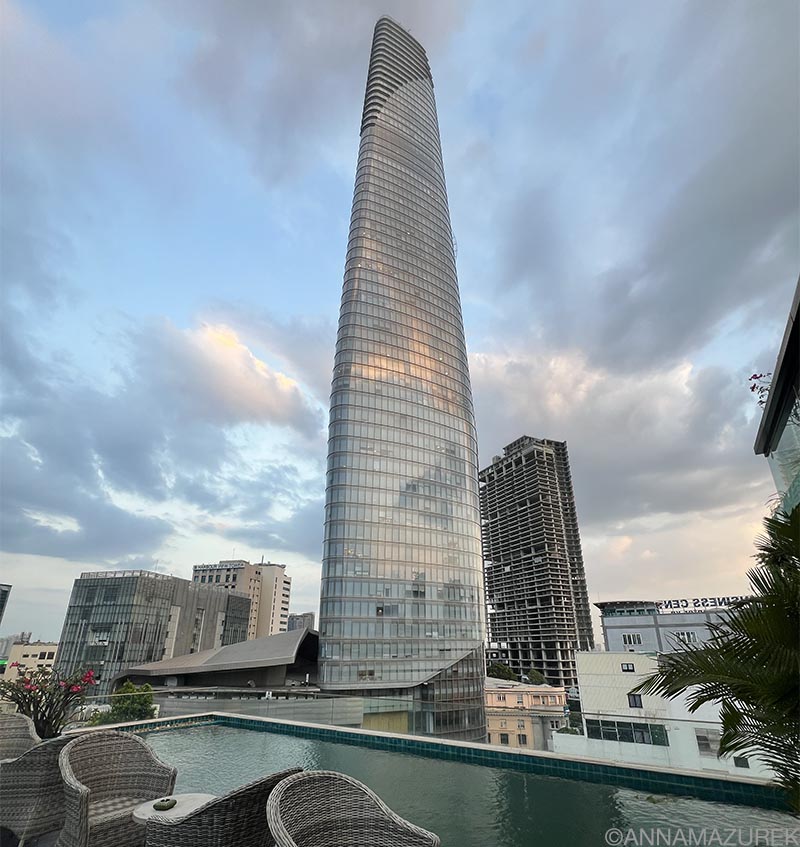 A view of the Bitexco Tower from the Au Lac Charner hotel.
A view of the Bitexco Tower from the Au Lac Charner hotel.
Where’s the best place to buy a SIM card in Vietnam?
The easiest thing to do is buy a Vietnam-specific eSIM card from Airalo that will work instantly when you arrive. (Airalo partners with Viettel, the fastest network in Vietnam.) For more details, read my review of Airalo eSIM cards in Southeast Asia.
Promo Codes: New customers save 15% off with NEWTOAIRALO15 and existing users save 10% with AIRALOESIM10.
If you are traveling to multiple countries in Southeast Asia on a short trip, then consider one of their Asia Regional eSIM cards. (Both the country-specific and regional eSIMs have worked wonderfully for me and even have a mobile hotspot option that’s critical because I’m always working remotely.) Keep in mind it’s always cheaper to buy a country-specific eSIM than a regional one.
Do you need travel medical insurance for Vietnam?
Yes, travel medical insurance is one of the most important things to purchase for any trip abroad, especially Vietnam. It covers all the things that could go wrong, from injuries to travel delays, so that you don’t have to worry and can focus on traveling!
SafetyWing’s Nomad Insurance offers $0 deductible travel medical insurance coverage for over 180 countries for people aged 69 and under when traveling outside their home country. The best part is that it only costs a few dollars a day! If you get sick or injured abroad, you can visit any hospital or doctor. I’ve found SafetyWing to be the best option for me.
Other benefits of Nomad Insurance include coverage for lost checked luggage, travel delays over 12 hours, motor accidents (if properly licensed, wearing all safety equipment and not intoxicated) and injuries from sports or leisure activities. You can even add adventure sports, electronics theft and U.S. coverage (for non-residents) to your policy.
One of the best things about SafetyWing is that you can buy policies abroad and speak to a REAL human from the 24/7 customer support team if you have questions! (I can vouch that they are excellent at assisting and will follow up with you afterward.) Pay in full or choose an auto-renewing plan that can be canceled anytime.
For more details, read my review of using SafetyWing in Southeast Asia.
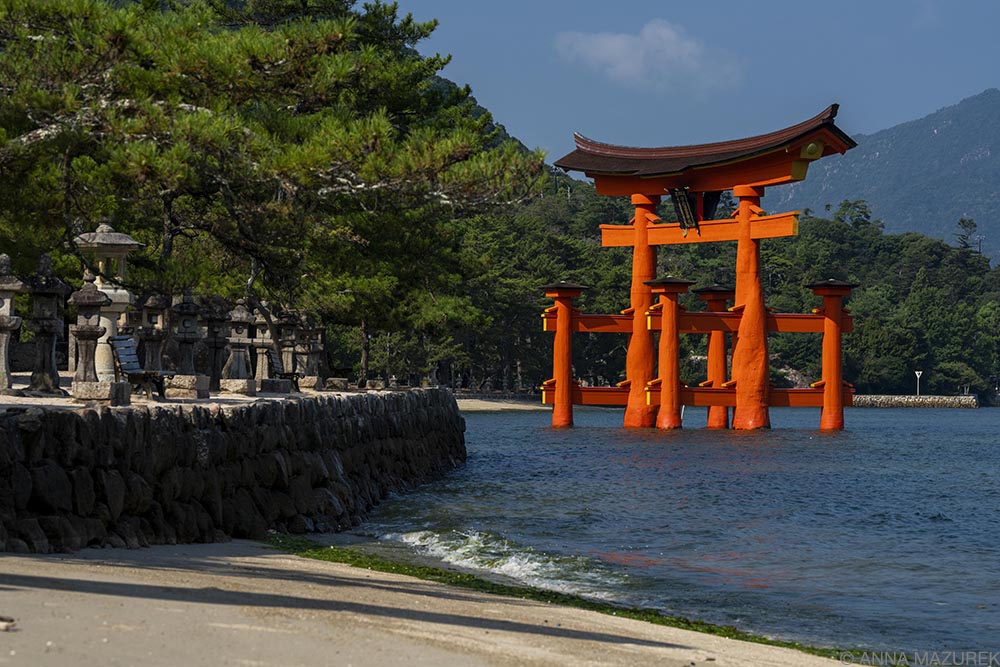
Airalo International eSim Review for iPhone
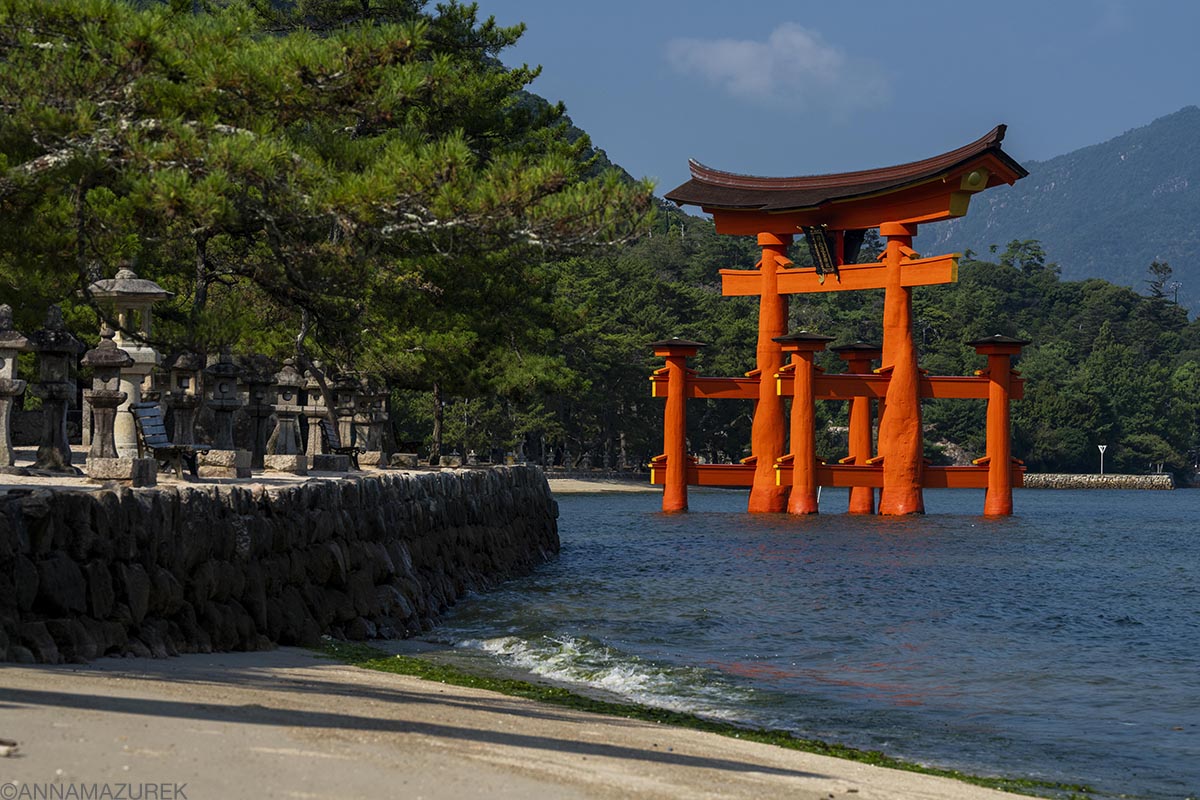 Miyajima, Japan // On my recent trip to Japan and Southeast Asia, I used Airalo’s eSIM cards for my iPhone 15 Pro and it worked perfectly with no issues.
Miyajima, Japan // On my recent trip to Japan and Southeast Asia, I used Airalo’s eSIM cards for my iPhone 15 Pro and it worked perfectly with no issues.
Since I spend most of the year abroad working remotely, having cell service with mobile hotspot capacity is crucial for me. For years, I just bought local SIM cards because they were inexpensive and worked instantly. Then, Apple nixed the SIM tray on their new iPhone models creating quite a conundrum for me because I spend a lot of time in Southeast Asia where the WIFI is often too slow for Zoom, so I need cellular data to be able to work. Cellular data has always been my backup plan.
I recently tried out Airalo’s regional and country-specific eSIMs and have been impressed. Airalo is a great international eSIM for iPhones. While I talk about the pros and cons of eSIMs in another post, this post is simply my Airalo eSIM review for a trip in Asia with an iPhone.
AFFILIATE DISCLOSURE: This is a sponsored post with affiliate links. All opinions are my own. If you make a purchase, I earn a small commission at no cost to you, which goes toward blog maintenance costs. I only recommend products and companies I truly love and use.
First of all, what is an eSIM card?
It’s essentially a digital version of a SIM card that connects your phone to the cellular network. It’s more convenient since people no longer have to buy a physical SIM card and find a tool or paper clip to open the SIM tray! It’s also easier to switch your service off if your phone gets lost or stolen.
What type of eSIMs does Airalo sell?
Airalo sells local (country-specific), regional and global eSIMs. Keep in mind that country-specific eSIM cards are always cheaper than regional or global ones. And, all three are cheaper than paying $10/day for Verizon or other U.S. carrier fees to have international service. Most eSIM cards are data only. If you want to call from abroad, use Google Voice. I talk about this in my post on traveling and two-step verification. (If you decide to use Airalo, use promo code NEWTOAIRALO15 for 15% off your first purchase! Existing users can save 10% with AIRALOESIM10.)
Airalo eSIM Card Review for Asia Travel
I’ve included two mini reviews below of my experience using Airalo eSIMs in different parts of Asia.
Japan, Thailand, Indonesia and Malaysia
I reluctantly upgraded to an iPhone 15 Pro last year but still travel with my old iPhone 13 Pro as a backup for SIM card reasons. Airalo had worked previously with my iPhone 13 Pro, but I had some issues initially using eSIMs that I had to call Verizon to solve. My iPhone 15 Pro worked instantly with no issues.
eSIM cards are sold with a set amount of data for a set time frame, which doesn’t start until you activate the eSIM. You can install it and activate it in the future. (I like to buy them in advance in case I don’t have WIFI when I arrive in a new place or as a safety net in case one eSIM expires then I can simply switch to the other.)
In August 2024, I was on a work trip to four countries in Southeast Asia (Thailand, Indonesia, Malaysia and Singapore) so I bought an Airalo regional eSIM card for Asia that was 10GB of data for 30 days for $37. Again, country-specific eSIMs are a better value. For example, my 30-day Japan eSIM was only $24.15 for 30 days for 20GB, which is a much better value for a lower price than my regional Asia eSIM.
When I left Singapore, I flew to Japan for a month-long trip and used up the leftover data on my regional Asia eSIM before switching to a Japan-only eSIM. I spent part of my work trip in Japan on a ship traveling around Japan and knew we were going to Busan, Korea for one day so I bought a 5GB regional Asia eSIM ($18.55 for 30 days) to use there. (They also offer cheaper 7-day plans with less data, but I always need to maximize my data so I usually buy the 30-day ones.)
iPhones allow two eSIMs to be activated at once. I bought and installed all the eSIMs in advance but didn’t activate them until I needed them. I had 5G in most places and didn’t have any service issues despite being in some rural spots. The personal hotspot worked like a dream. (For safety, I turned off cellular data for Instagram because I’m guilty of using too much data on it.)
Cambodia, Laos and Vietnam eSIMs
In early 2025, I traveled to Laos, Cambodia and Vietnam using Airalo using country-specific eSIM cards for each place, but they are all covered on Airalo’s regional Asia eSIM plans. First of all, Airalo is the only eSIM company with coverage in Laos from my research. You can buy a Laos-only eSIM (limited options and pricey—$9.50 for 1 GB), and it’s included in the regional Asia eSIM (better value).
In Cambodia, Airalo partners with the Metfone network, which has better coverage in rural areas compared to using the Smart network. (All networks work in big cities.) It even worked well enough to do voice-calls on the remote island of Koh Rong Sanloem, which is a bit of a cellular dead zone. I was able to hotspot to my computer with no issues when the WIFI was dragging. (I used the Cambodia eSIM with 5GB for 30 days for $13 USD.)
In Vietnam, Airalo is the only option that I’ve found that partners with Viettel, the fastest network in Vietnam. I’ve tried other networks, and they only get LTE, even in Hanoi and Ho Chi Minh. This is the fastest data in Vietnam by far. If you need to do Zoom calls or work, don’t risk it with any other network. (Since I just had a short two-night layover, I did the 1GB for 7 days plan for $4.50 USD.)
The Airalo app makes it easy to check your data usage and eSIM expiration date. You can even set the eSIMs to auto-renew! Airalo will send a notification when you get low on data or when it’s about to expire.
Overall, Airalo is fast and convenient. I recommend downloading the eSIMs before you travel so you can simply switch it on the instant your flight lands. It’s cheaper than paying for international service on your U.S. plan (unless you get it for free with your plan) and a no-brainer if you are country hopping on a short trip.
For me, it’s my go-to if I’m not staying in a country long term and don’t have time to buy an eSIM from a storefront in the city. I really like the cashback feature of their loyalty program, too. Again, country-specific eSIMs are much better value than regional ones. (Use promo code NEWTOAIRALO15 for 15% off your first purchase or existing users can save 10% with AIRALOESIM10.)
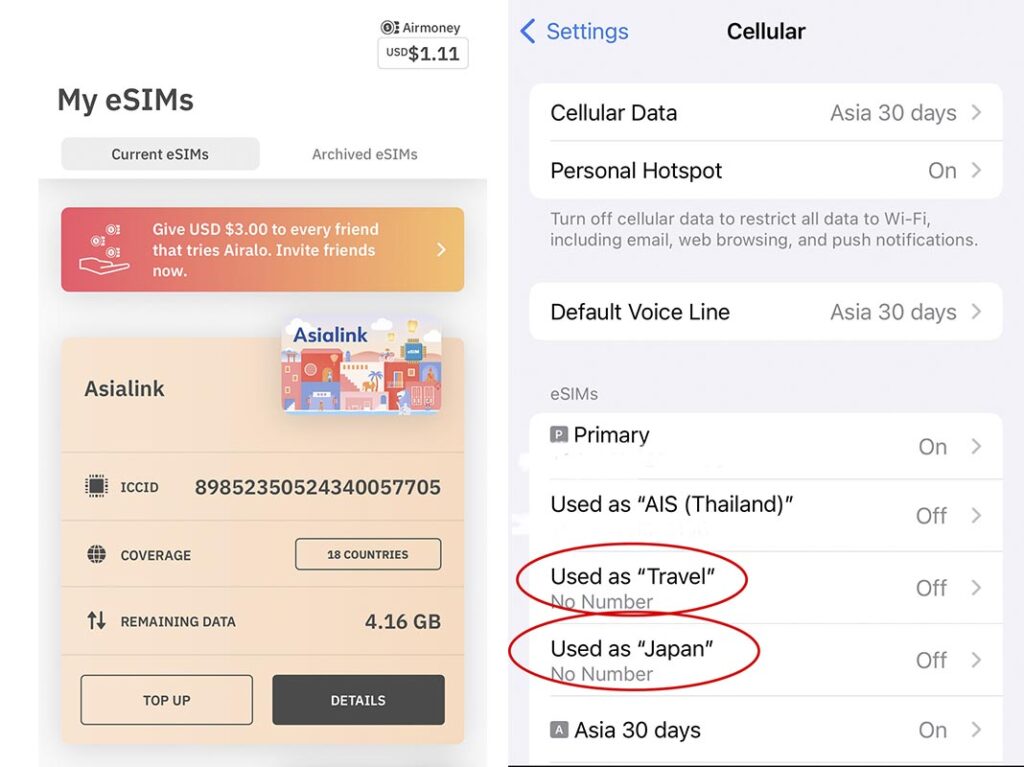 Left: The Airalo app makes it easy to check your data balance of your eSIM cards. Right: If you’re buying multiple eSIM cards, be sure to label them so they are easy to differeniate and only turn on the ones you want to use. (This menu is under Setting > Cellular on the iPhone.)
Left: The Airalo app makes it easy to check your data balance of your eSIM cards. Right: If you’re buying multiple eSIM cards, be sure to label them so they are easy to differeniate and only turn on the ones you want to use. (This menu is under Setting > Cellular on the iPhone.)
How does Airalo’s Loyalty Program work?
For every new eSIM purchase, Airalo gives you cashback as part of their Airmoney Rewards Program that can be redeemed on your next purchase.
Here are the tiers:
-
- Traveler: New users get 5% Airmoney Rewards.
- Silver Traveler: After spending $20 USD, the reward increases to 6%.
- Gold Traveler: After spending $70 USD, the reward increases to 7%.
- Platinum Traveler: After spending $200 USD, the reward increases to 10%.
Important Note: You can’t redeem your rewards AND use a promo discount code. You can only do one or the other. I normally see what is cheaper—redeeming my rewards or saving 10% with code AIRALOESIM10.
How to Install Airalo on your Phone:
Airalo makes it easy to install—simply follow the on-screen instructions in the Airalo app.
Tap on My eSIMS in the app, tap the Details button on the eSIM you want to use, tap “View Instructions, tap “Direct” and then, tap “Install eSIM” and follow the on-screen guide. For step-by-step instructions with screenshots, check out this page.
Afterward, a screen will appear saying it’s activated then you can name your eSIM anything you’d like. If you have multiple ones, I recommend labeling them so it’s easy to differentiate between them. In your cellular settings on your phone, make sure the ones you aren’t using are turned off.
How to know if an eSIM work with your phone?
Airalo will tell you before the purchasing process whether or not an eSIM will work with your phone, so you aren’t wasting money, which I really respect. This happened to me when I first tried to set one up on my old iPhone 13 Pro. I ended up having to call Verizon to get a few things sorted because I have a pre-paid plan. Afterward, it worked fine, and I’ve had no issues on my iPhone 15 Pro.
For more about the pros and cons of eSIM cards, check out this post.
 Banteay Kdei is a lesser known temple in Angkor, Cambodia near the famous Ta Prohm.
Banteay Kdei is a lesser known temple in Angkor, Cambodia near the famous Ta Prohm.
Two Things to Make Airalo Better
I’ve used Airalo on four continents at this point, and these are the two issues that annoy me the most. I’ve seen others complain about network connectivity, but I find they are often the ones partnered with the fastest networks from my travels, especially Viettel in Vietnam.
1. Simplified eSIM Installation & Plan Management
Every Airalo eSIM purchase involves installing a separate eSIM card, which needs to be individually labeled and then manually deleted later. (As a frequent eSIM user, I label mine by location or plan such as “Thailand” or “Europe” to ensure I have the correct eSIM activated.) It would be much simpler to only install the eSIM card profile once then add plans for different countries or regions to the same profile. I’ve tested other brands of eSIM cards that do this and prefer this.
2. Faster, Streamlined Support
I tend to error on the side of caution and top up eSIM cards in advance because I can’t risk running out of data while traveling in remote areas. If I don’t use the top up, I ask for a refund, which Airalo Support has been wonderful about refunding with no questions since the data was not used.
When I submit my question in the Airalo app chat, the AI-powered Chatbot acts like it can help but constantly asks me to sign in even though I’m already signed in. I get stuck in a loop, so I finally just ask for a person. I get connected instantly to a human, and my issue is resolved quickly. It would be nice if the chatbot could just handle it for me to save time. Plus, I often must email support in addition to chatting to verify my identity to get the refund processed. While I appreciate the 24/7 support, it would be great if this could all be done in the app for simplicity.
How to Fix Common Airalo Issues on Your iPhone
1. Install Your eSIM Before Leaving for Your Trip.
I buy and install my eSIM before boarding my flight to ensure it’s ready to go the minute the plane touches down. Before you make a purchase, Airalo makes it very clear whether your phone is compatible with the eSIM in the app. During installation, be sure to clearly label the eSIM in your phone so it’s easy to locate
2. Make sure the eSIM is turned on and selected for cellular data.
In Settings, go to Cellular Data and make sure the correct eSIM card is selected under the Cellular Data setting.
3. Turn on Data Roaming.
Some eSIMs require data roaming to be turned on, which is listed in the activation instructions and in the How to Connect section under each eSIM in the Airalo app.
4. Toggle Airplane Mode Off and ON.
This usually resolves most of my issues when my eSIM doesn’t connect instantly. Restarting your phone can also help.
5. Network Settings Problems.
If the eSIM is activated but not working, try these steps:
- Manually select the network. Often eSIMs can connect to more than one network. Make sure it’s connecting to the network listed on your eSIM profile. If not, turn off automatic network selection and manually choose the correct carrier.
- Turn off limit IP address tracking.
- Change Network Mode. In the eSIM settings, go to Voice & Data and choose the correct setting listed on the eSIM. If it only supports 4G, select that instead of the 5G options.
- Check the APN configuration. While the Access Point Name is usually configured automatically, some eSIMs require a specific APN that will be listed in the installation instructions. It can also be found under View Details, then scroll down to “How to Connect.” Airalo Support can also provide correct setting.
- Turn off other eSIMs and restart the device. If these quick fixes don’t resolve your problem, reach out to Airalo’s 24/7 multilanguage support on What’s App or new chatbot in 53 languages, including English, French, Spanish, German and Arabic.
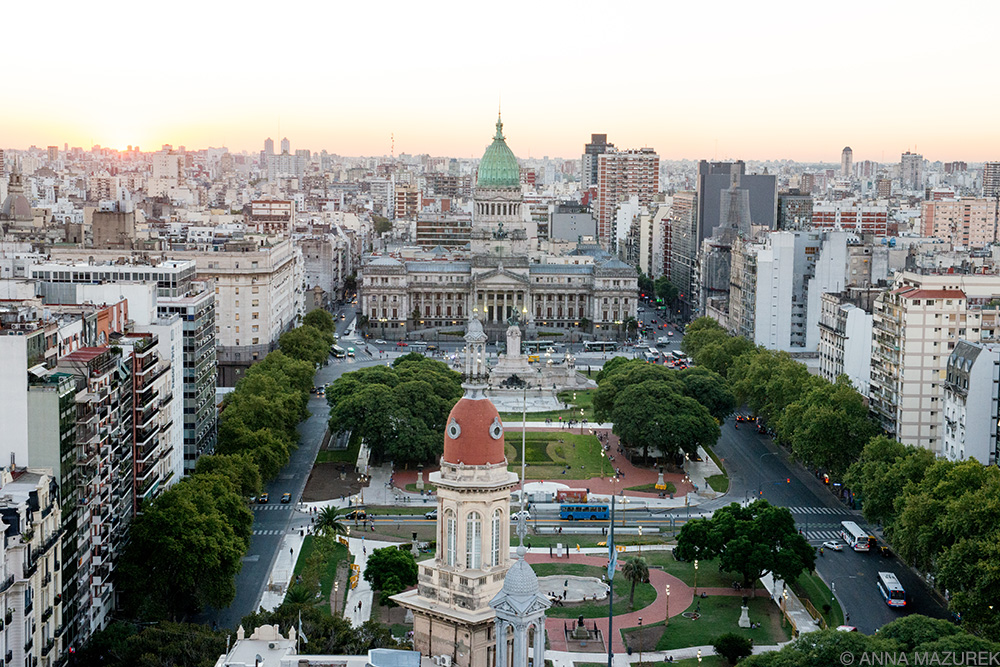
The Ultimate Guide to Buenos Aires: What to Eat, See & Explore
 The view of Plaza del Congresso and the Argentine parliament building from Palacio Barolo, one of the city’s most beautiful buildings.
The view of Plaza del Congresso and the Argentine parliament building from Palacio Barolo, one of the city’s most beautiful buildings.
There is no city in the world as seductive as Buenos Aires. While the skyline isn’t sexy, the city itself is intoxicating. The streets are lined with grand European palaces, cozy cafes and endless parks. The stables of life are steak, wine and ice cream. Dinner never starts before 9 p.m. and most places close daily for an afternoon siesta. After dinner, everyone dances tango until almost sunrise.
I fell in love with this city on my first visit in 2015 and have been back many times to live during the U.S. winter. I even wrote about my love affair with Buenos Aires for a travel story for the Washington Post, which digs into the history and beauty of the city. In addition to that story, I made a more detailed guide of the best places to visit, eat and tango in Buenos Aires.
From eSIM cards to travel medical insurance, keep reading for all the details about where to go in Buenos Aires and how to best prepare for your trip!
Affiliate links are used in this post. If you make a purchase, I earn a small commission at no cost to you, which goes toward the cost of maintaining this blog.
Plan Your Trip
Currency: Argentinian Peso (ARS)
When to Go: Spring (September to November) & Spring (March to May)
Travel Insurance: Protect yourself with SafetyWing travel medical insurance to cover accidents and travel delays.
Mobile eSIM Card: Get seamless connectivity worldwide with Airalo minus the hassle of physical SIM card. (Save 10% with code AIRALOESIM10!)
When to Go To Buenos Aires
Peak season for tourism is their summer—December to February, which is when I prefer to go because I love the heat. Temperatures range in the 80s most of time, but start to cool off to high 70s in February. The shoulder season of November and March are also nice. November is when the famous jacaranda tree purple flowers bloom, but weather will be chilly enough where you’ll still need a light jacket.
 El Ateneo Grand Splendid bookstore (left) and Buenos Aires Botanical Gardens (right) are both gorgeous and free!
El Ateneo Grand Splendid bookstore (left) and Buenos Aires Botanical Gardens (right) are both gorgeous and free!
The Best Things to Do in Buenos Aires
-
Palacio Barolo is the best spot for a scenic view of the skyline and the parliament building. The building was inspired by Dante’s Divine Comedy and has 22 floors that match the content of the poem directly. The palace now consists of many offices, but they have daily tours that take you into the lighthouse at the top of the building.
-
Le Recoleta Cemetery. One of the most notable graves in La Recoleta Cemetery belongs to Eva Perón. The 14-acre grounds are hauntingly beautiful – elaborate above-ground marble mausoleums and statues cover a sprawling grid of four city blocks lined with large walkways. Be sure to check out the weekend market in the adjacent park. Free Entry.
-
Attend a Boca Juniors or River Plate football game for one of the cites most exciting experiences Tickets for games must be booked through travel agents, GetYourGuide or Viator. If you can’t attend a game, a stadium and museum tour is your best option for both River Plate and La Boca. Read reviews before booking. (Keep an eye on your belongings in the La Boca area and avoid it at night.)
 The stunning chandeliers in Teatro Colon in Buenos Aires.
The stunning chandeliers in Teatro Colon in Buenos Aires.
-
Teatro Colón is not only one of the finest opera houses in the world but one of the most beautiful buildings in the city. Built in 1908, the seven-story theater covers an entire city block and features ballet, opera and concert performances. Many of the lavish building materials – Venetian mosaics, French stained glass and three kinds of Italian marble—were all imported from Europe. If you can’t catch a performance, take one of the hourly guided tours. Tours run every 15 minutes from 9 a.m. to 5 p.m. daily in both English and Spanish.
-
El Ateneo Grand Splendid Bookstore has a story just as interesting as the décor. The building opened in 1919 as a theater called the Teatro Gran Splendid before converting into a cinema, which showed the first sound films in the country. The theater-turned-cinema was then converted into a bookstore in the early 2000s. Much of the interior, including the ornate carvings, remain intact. Bookshelves replaced the rows of seats, and the theater boxes were left for customers to curl up with a book. Dark red curtains frame the stage, which is now home to a quaint café. Free entry.
- National Museum of Decorative Arts is housed in a 1917 beaux-arts mansion that was originally the home of Chilean aristocrat Matías Errázuriz and his wife, Josefina de Alvear. When Alvear died in 1935, the family donated the house and its extensive collection of European and Asian art to the Argentine government under the condition it be used as a museum. The elaborate décor features a ballroom with hand-carved ceilings and artwork by Manet and Rodin. It is the only French mansion built at the beginning of the 20th century open to the public in Buenos Aires. There are also rotating art exhibits in the main floor and basement galleries. Entry is free.
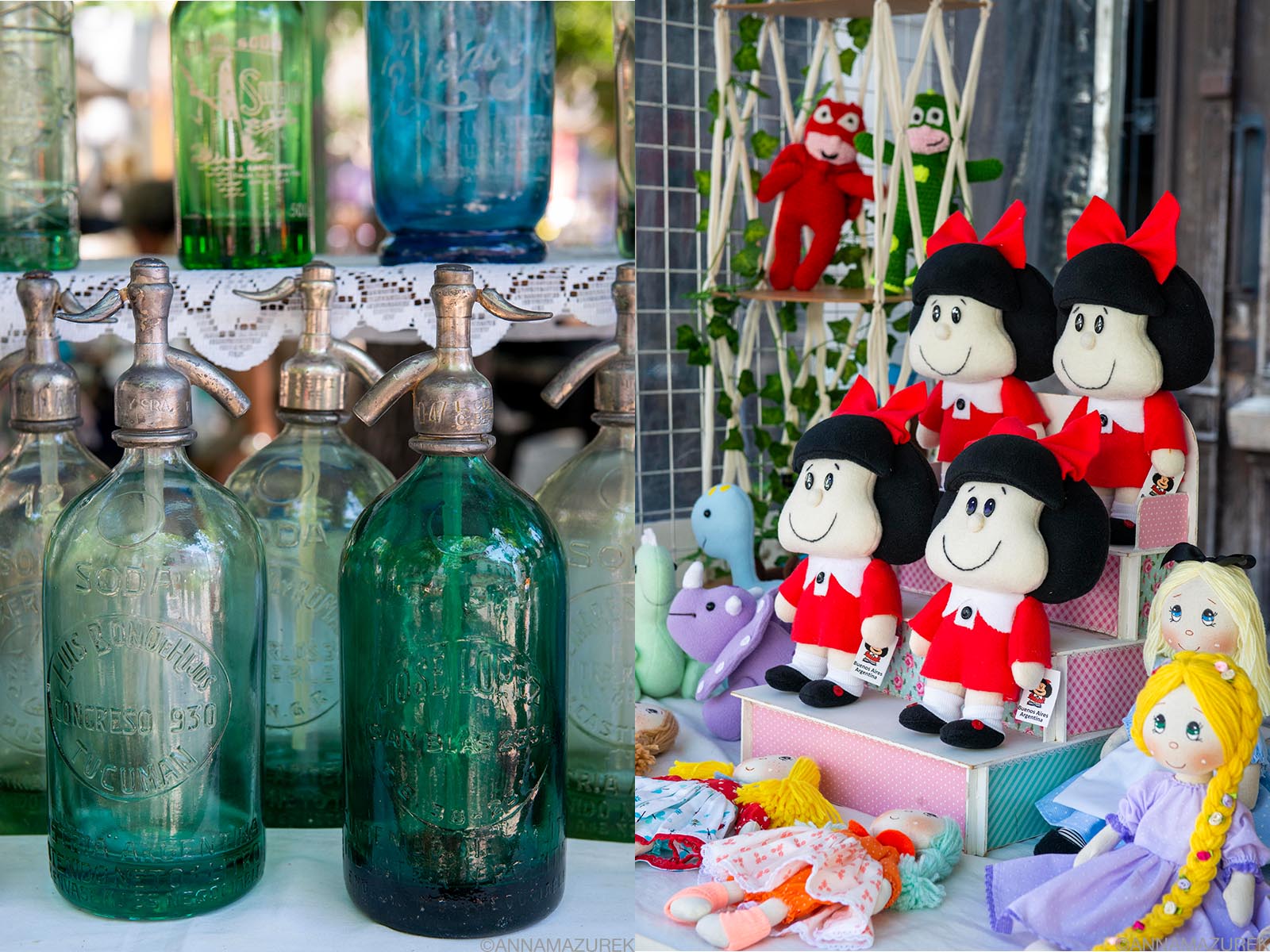 The San Telmo Sunday Market is filled with glass seltzer bottles and souvenirs of Mafalda, a famous Argentine comic strip.
The San Telmo Sunday Market is filled with glass seltzer bottles and souvenirs of Mafalda, a famous Argentine comic strip.
-
San Telmo Street Fair is the place to be on Sunday. Plaza Dorrego, the heart of the market, is focused more on antiques including a row of vendors selling vintage glass seltzer bottles. The stalls stretch out into the adjacent streets and eventually, it turns into more of a flea market with vendors selling leather belts, fresh-squeezed juice and merchandise centered around Mafalda, a famous Argentinean cartoon character. Sundays 10 a.m. – 5 p.m.; Free entry.
-
Parque Tres de Febrero is the biggest public park in the city. It includes a giant lake and a rose garden surrounded by a pedestrian track filled with runners and rollerbladers. It’s my favorite place to run in the city. On weekends, there are stalls renting bikes, pedal carts and skates. The park used to be the private grounds of a dictator and was named after the date he fell from power. Rose garden is open 8 a.m. – 8 p.m. daily.
-
Galileo Galilei planetarium has a nightly light show that you can’t miss. The planet-shaped building changes colors while the fountains in the adjacent lake perform a mini-show on the hour mark. While the museum is open during the day, there is free telescope viewing on weekend nights until 10 p.m. Av. Sarmiento, Light show is free.
- Museo Nacional de Bellas Artes is an art museum with a stunning collection of European master’s including Degas, Monet and Rodin, along with Argentinean artists. Entry is free
- A street art walking tour is a great way to explore Buenos Aires endless neighborhoods from La Boca to Palermo Hollywood. Graffitimundo offers tours, but you must email to book in advance. For shorter notice, book a tour from GetYourGuide or Viator.
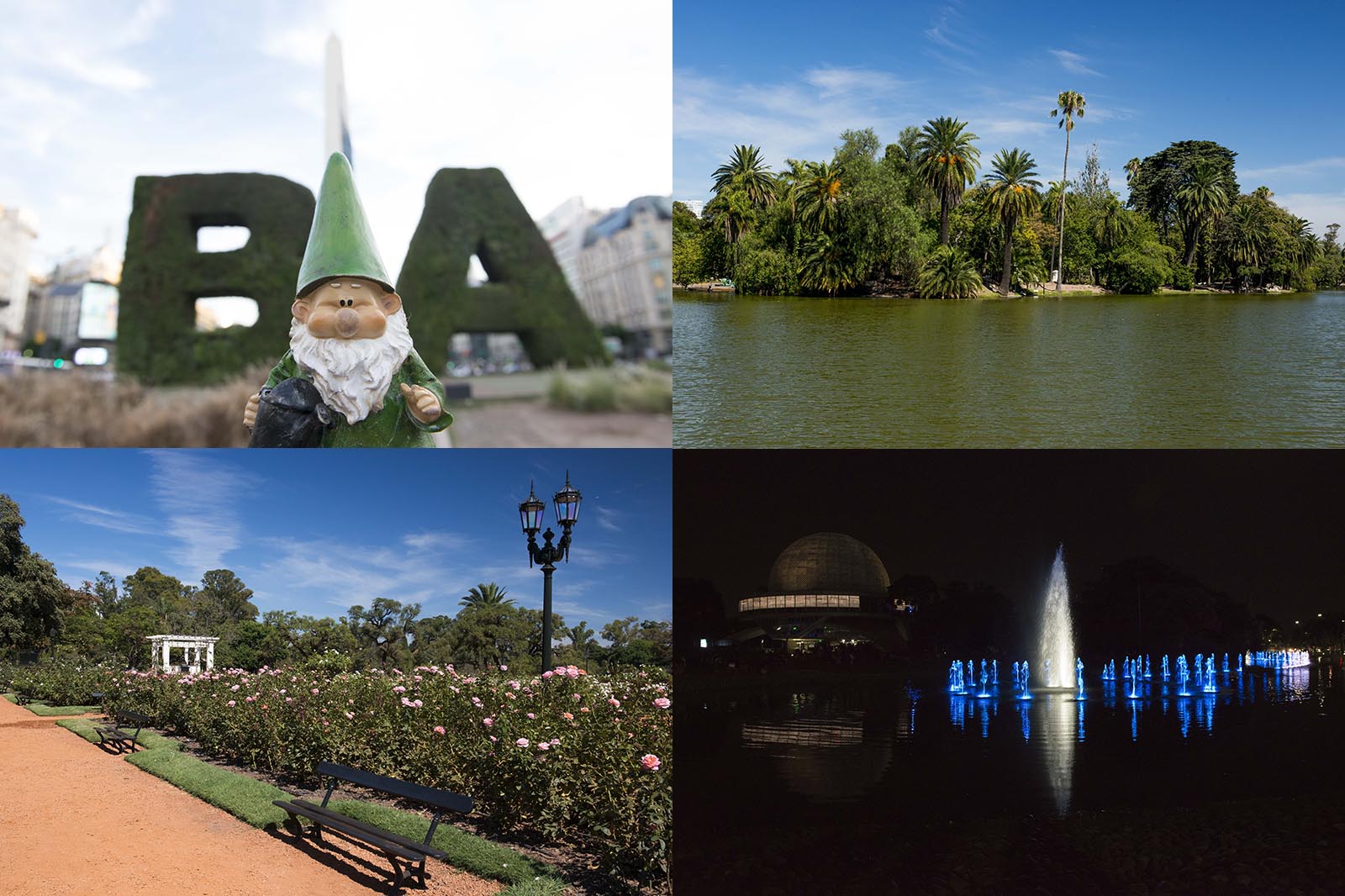 Clockwise from top left: Obelisco de Buenos Aires, Bosque de Palermo, Galileo Galilei planetarium at night and Paseo del Rosedal in Palermo.
Clockwise from top left: Obelisco de Buenos Aires, Bosque de Palermo, Galileo Galilei planetarium at night and Paseo del Rosedal in Palermo.
-
Museo de Arte Latino Americano (MALBA) focuses on Latin American art from the early 20th Century to the present. Highlights include Diego Rivera, Fernando Botero and Frida Kahlo. Be sure to visit on a Wednesday when admission is discounted and free for student and teachers. I got in free with my teacher’s ID from Texas.
-
Obelisco de Buenos Aires is one of the icons of the Buenos Aires. The monument was built in 1936 in honor of the 400th anniversary of the city’s founding. Located at the foot of the monument in Plaza de la República is the giant BA sign that’s Instagram-worthy!
-
Floralis Generica is a metal flower sculpture by Argentine architect Eduardo Catalano in Plaza de las Naciones Unidas. It also has purple lights that appear at night. It’s a fun picnic spot. FIGUEROA ALCORTA, PRES. AV. 2301, Free entry.
-
Jardín Botánico Carlos Thays (botanical gardens) is a peaceful escape from the city. Built by French landscape architect Carlos Thays, the green space includes over 1,500 plant species, Roman-style statues and a glass-domed greenhouse. Thays is also responsible for creating, remodeling and expanding 69 public spaces in the city.
-
Buenos Aires Ecological Reserve is the largest green space in the city. It’s a great place to rent a bike and explore. The 865-acre reserve lies east of Puerto Medaro on the bank of the Rio de la Plata. It’s packed with locals on weekends and a market by the south entrance. Free entry.
-
The Buenos Aires Metropolitan Cathedral is the main Catholic Church in the city center. Pope Francis used to perform mass here until he became Pope in 2013. It also houses a Pope Francis Museum. Entry to the cathedral is free.
-
Stroll La Caminito, a colorful pedestrian street in the La Boca neighborhood surrounded with houses built of brightly painted wood and sheet metal. Explore the museums and shops during the day. Petty theft is an issue in La Boca, and it’s dangerous at night.
- Free Walking Tour. There are several companies that offer free walking tours, and the guides work for tips only. This is a great way to get an idea of the city to start your trip.
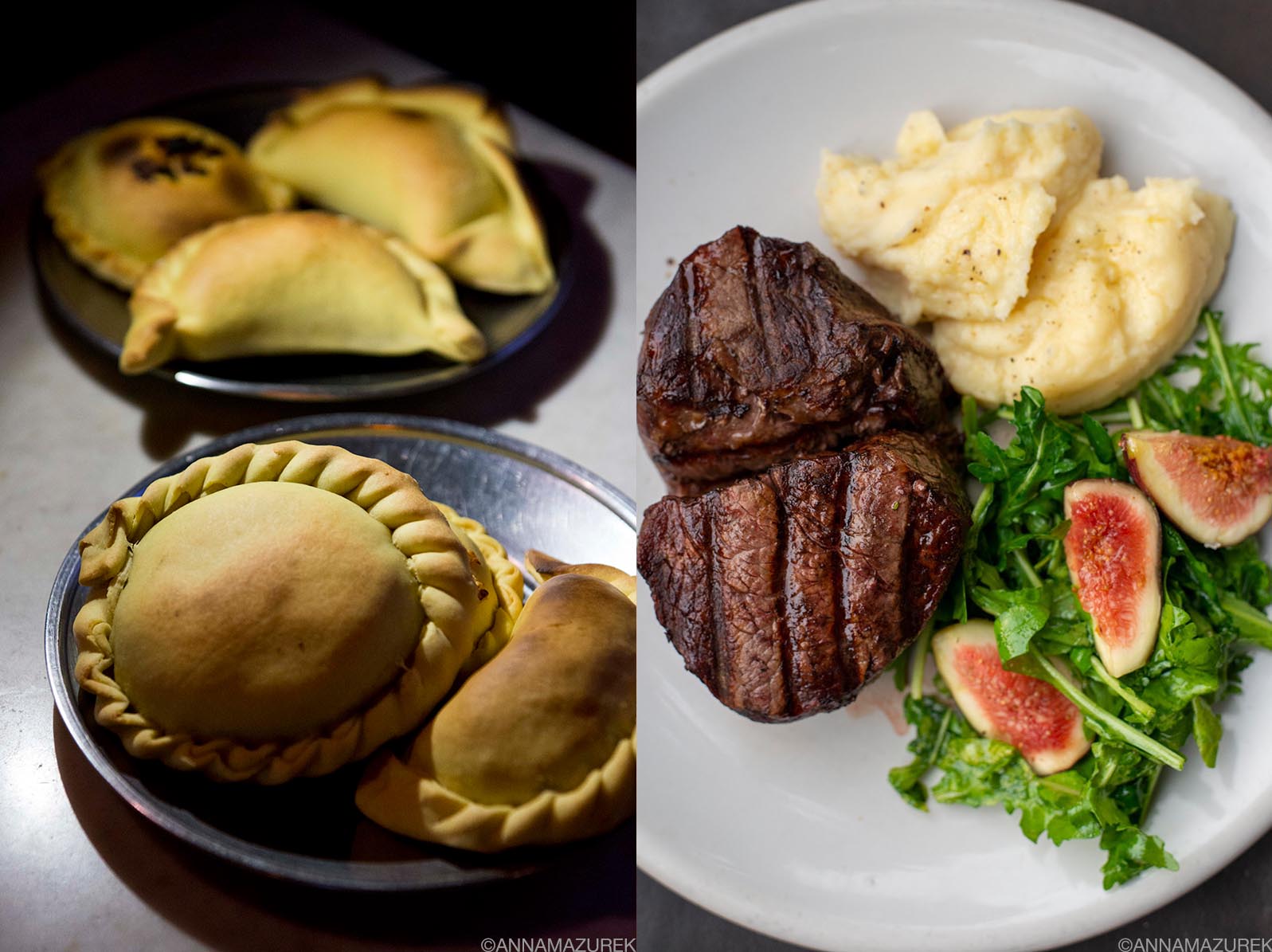 Left: Empanadas from La Cocina are the best in the city! Right: Steak from Don Julio, which was voted the best restaurant in Latin America in 2020 and 2024.
Left: Empanadas from La Cocina are the best in the city! Right: Steak from Don Julio, which was voted the best restaurant in Latin America in 2020 and 2024.
The Best Places to Eat in Buenos Aires
- Don Julio was voted the best restaurant in Latin America in 2024. The traditional Argentine steakhouse is the best steak in town. Reservations recommended.
- El Preferido de Palermo is a great dinner spot owned by the team behind Don Julio. Their milanesas (breaded meat cutlets) are delicious. Reservations recommended.
- La Cabrera is a Palermo parrilla (steakhouse) with a nightly happy hour from 6:30 to 8 p.m. Everything (steak, salad and even wine) is 40% off. The only catch is that you must be out before 8 p.m. when they start seating parties with reservations. Juicy steaks are served with an array of small sides ranging from pickles to purees.
- Casa Cavia is a lovely restaurant located in an old mansion with a leafy courtyard patio. It’s been my go-to brunch spot, but it’s also open for dinner. The homemade scones with dulce de leche are fantastic.
- Pain et Vin is my favorite wine shop/bar in Palermo. They serve light cheese plates but not proper meals.
- Usina and GOIN! are two Recoleta cafes I like for breakfast, lunch and an early dinner. (They close around 8 or 9 p.m., which is early for Argentine standards.)
- La Cocina has the best empanadas in town! This tiny hole in the wall has only 14 seats and plays classic rock music. I recommend the carne picante (beef), the pikachu (onion, cheese and red pepper flakes) and choclo (corn).
- L’Orangerie is located in the swanky Alvear Palace Hotel in Recoleta. This restaurant serves afternoon tea featuring a selection of miniature sandwiches, pastries and scones.
 Left: Alfajores (dulce de leche with cornmeal cookies are available across the city); Right: Strawberry cheesecake from L’Orangerie at the Alvear Palace Hotel.
Left: Alfajores (dulce de leche with cornmeal cookies are available across the city); Right: Strawberry cheesecake from L’Orangerie at the Alvear Palace Hotel.
-
La Fachada has the best selection of empanada flavors in town including pumpkin (my favorite), pineapple (my second favorite) and Caprese. Their pizza also looks delicious. They have two locations so check their website for details and times.
-
Narda Comedor is a healthy eatery run by famous Argentine chef Narda Lepes, who was trained in France. There’s a nice patio and they spread the tables out into the park across the road during the daytime. Their mains are large portions and the panna cotta is delicious.
-
Croque Madame Café has a delicious array of cakes and quiches. There are multiple locations but the most scenic is the garden location at the Museum of Decorative Arts.
-
Lucciano’s is a family-owned ice cream chain that’s one of my favorite ice cream spots. The pomelo is my favorite flavor.
- For San Telmo, El Blanco Rojo, Bar Chin-Chin and Virrey Cocina Urbana were my go-to spots in 2018. They are still around, but I didn’t spend much time in San Telmo this trip.
The Best Craft Beer in Buenos Aires
Craft beer is slowly infiltrating the city. Many breweries have daily happy hours.
-
Buller Brewing is a brewery with an amazing rooftop patio overlooking Recoleta cemetery. Their beer, burgers and onion rings are fantastic.
-
Rabieta is probably my favorite microbrewery with nine of their own beers and other local brews on tap. You can’t beat the location on the horse racing track. Their patio is expansive, and they also serve bar food.
-
1516 Cerveceria in Palermo has a giant patio. On Tap serves 20 beers from local microbreweries and has several locations.
- Jugetes Perdidos never makes the same beer twice. You can find their beer in bars in town, but they don’t have a taproom. The brewery offers tours in their taproom every Saturday. Make reservations by calling or via Facebook Messenger. Tours are in Spanish, but they speak English if you have questions. Tour is free, but you pay for a beer and a complimentary glass. Bolivia 3342.
The Best Coffee in Buenos Aires
Since I don’t drink caffeine, I’m passing along recommendations from my coffee-loving friends. Santa Café is run by a Colombian couple so you know the coffee is good. It’s across from the Intercontinental Hotel. Everyone raves about their flat white. LAB is a great coffee spot with bar-style seating in Palermo that also has bagels. Coffee Town is a popular spot in San Telmo.
Where to Dance Tango in Buenos Aires
Taking at least one tango lesson is a requirement for any visit to Argentina. Aside from lessons, attend a milonga, a term that describes a type of music but is a common reference for a tango show. Many milongas have professional dancers perform throughout the night but have the dance floor open to the public otherwise. Here are a few regular spots that are still open:
- On Sunday nights, there’s usually outdoor tango at La Gloretia, a gazebo in Barrancas de Belgrano park.
- La Cathedral is the dive-bar equivalent of a milonga with the dance floor surrounded by mix-matched chairs that look like they came from a consignment shop. They offer lessons during the day have a milonga every night. It’s a great spot to go out on weekends and has a great vibe. The professional dancers are always amazing. They traditionally have two-for-one entry before 10 p.m. every night deal.
- Other options include La Viruta and Salon Canning, which is a more traditional venue with more of a dress code than other venues.
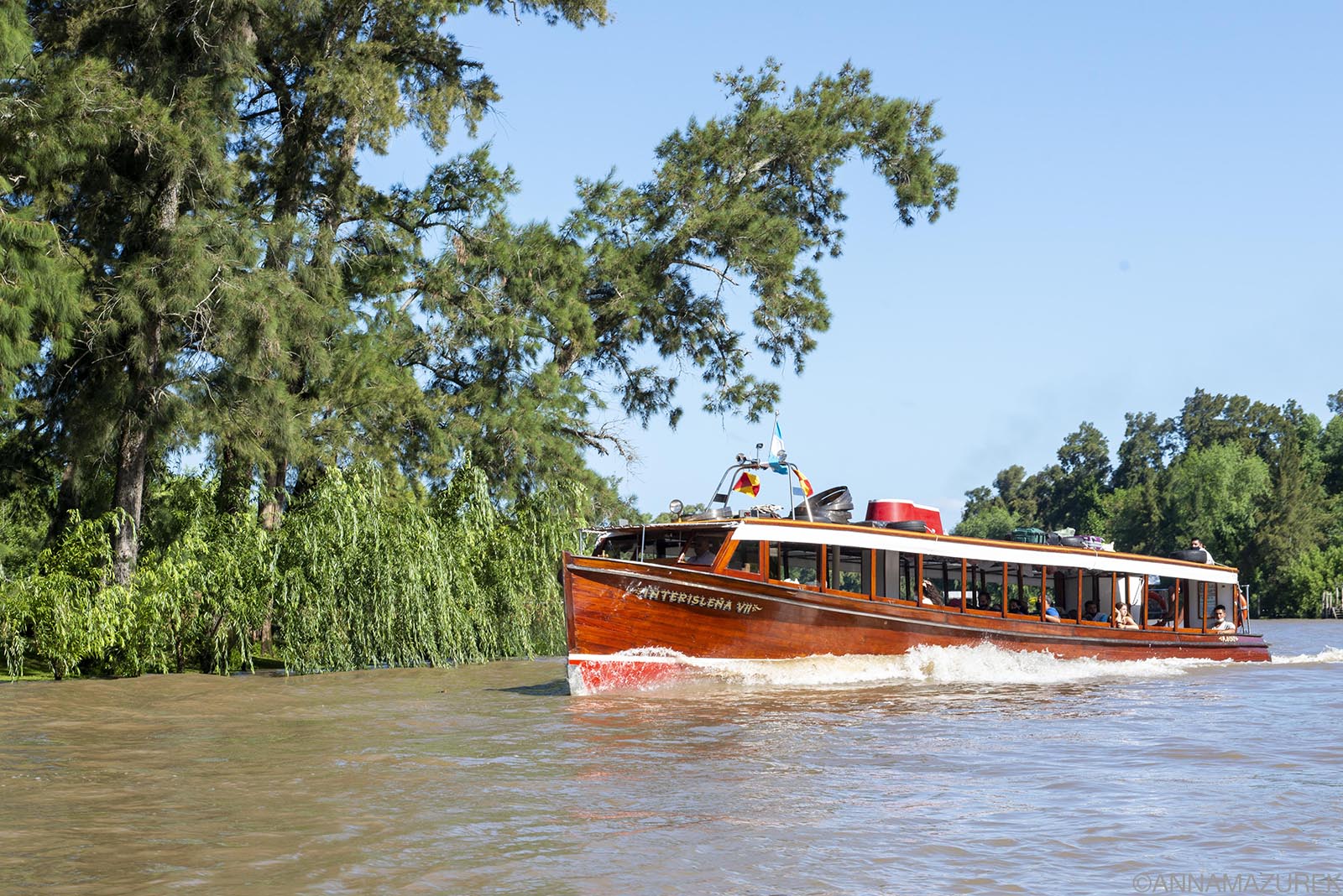 The waterways of Tigré, the gateway to the Paraná Delta located 18 miles north of the city, are a great day or weekend trip. Be sure to take a one-hour boat tour through the canals and residential parts of the delta.
The waterways of Tigré, the gateway to the Paraná Delta located 18 miles north of the city, are a great day or weekend trip. Be sure to take a one-hour boat tour through the canals and residential parts of the delta.
Day Trips from Buenos Aires
If you are looking to escape the city, there are several great day trips. You can do these on your own or book a group tour through GetYourGuide or Viator.
- Tigre is a series of scenic canals lined with vacation cottages that’s popular with locals. It is also known for its museums: Museo de Mate (famous loose leaf tea) and Museo de Arte de Tigre, an art museum dedicated to Argentine artists housed in a 1912 social club. It’s easily accessible by train from Retiro station. I recommend the more scenic Tren de la Costa and stopping at other stations along the way to explore the coast. It’s also easy to book day tours that take you by van and include the cost of the boat tour.
- La Plata is South America’s first completely planned city built on an elaborate grid famous for the towering neo-Gothic Cathedral and a natural history museum that’s touted as Argentina’s best museum. There is a direct train from Constitución station.
- San Antonio de Areco is a picturesque small town in the Pampas (lowlands area) known for gaucho (local skilled horseman) traditions.
- Colonia del Sacramento: Take the one-hour ferry to Uruguay to visit this peaceful postcard-perfect colonial town in Uruguay. Check out my guide to Colonia, here. (Uruguay is so amazing that you’ll fall in love instantly and want to stay for more than a weekend.) You can easily buy ferry tickets online.
Public Transport in Buenos Aires
-
Public transport. Buenos Aires has an extensive network of subway trains (Subte) and buses (Sube) that are both efficient and budget-friendly. You need a reusable Subte card, which you can buy at the stations.
-
Eco Bici The city offers a system of rental bikes around the city, which you can check out for an hour at a time. Tourists can sign up for the program and upload a copy of their passport and entry stamp.
- Ubers & Taxi. Uber exists in Buenos Aires, but it’s much slower than just grabbing a taxi off the street. Be sure to set your payment method to cash if taking an Uber. I find the regular taxis to be cheaper. I normally only use Uber when I don’t know how to explain in Spanish where I want to go. I normally give taxis cross streets to drop me off.
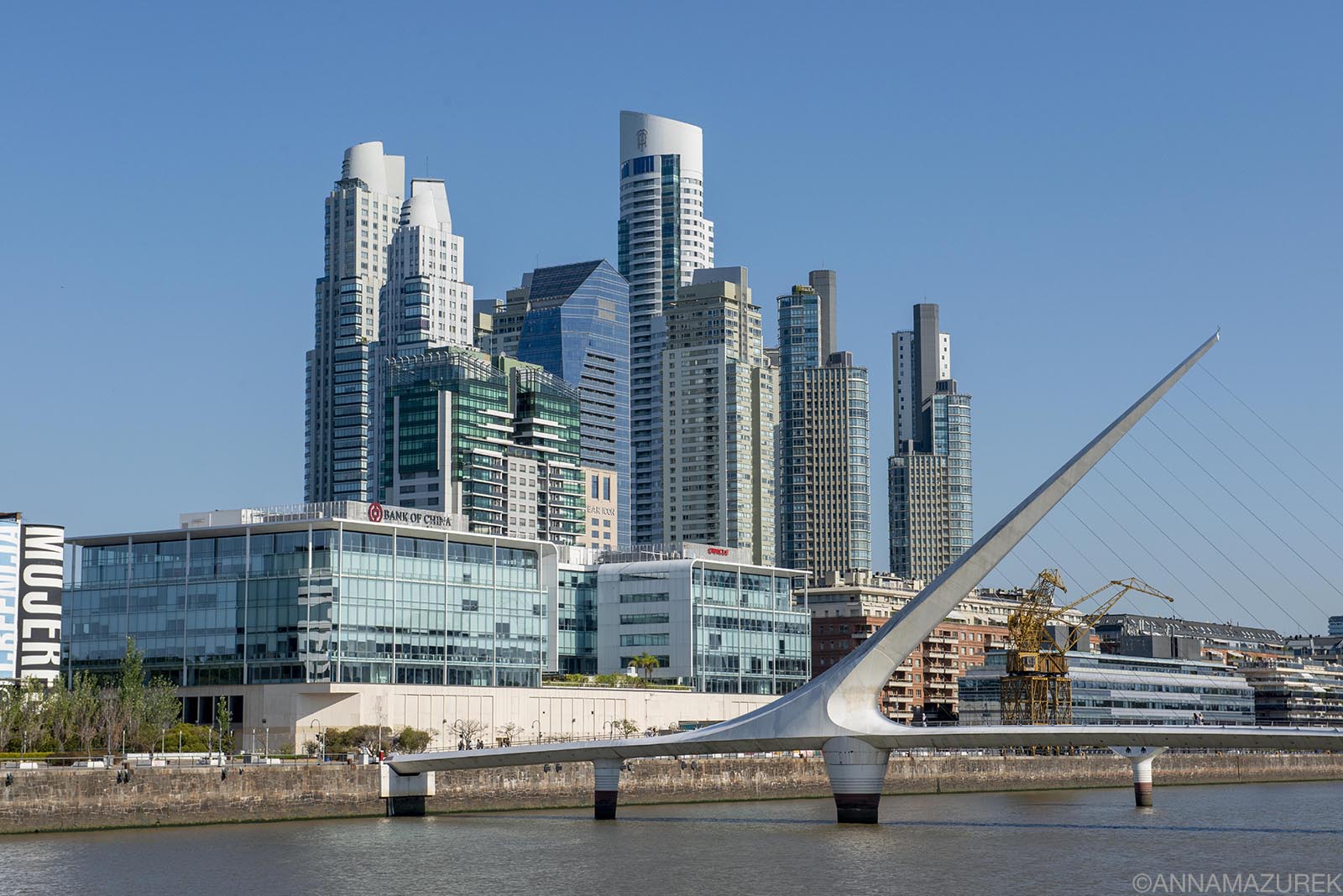 The sleek skyscrapers of the city’s revitalized portside at Puerto Madero. The white bridge is El Puente de la Mujer (Women’s Bridge) is by Valencian architect Santiago Calatrava and it is one of the most famous landmarks in the area.
The sleek skyscrapers of the city’s revitalized portside at Puerto Madero. The white bridge is El Puente de la Mujer (Women’s Bridge) is by Valencian architect Santiago Calatrava and it is one of the most famous landmarks in the area.
Exchange Rates in Argentina: Is Buenos Aires a cheap place to travel?
Inflation has plagued the country for decades and is one of the highest in the world. In December 2023, it peaked at 25% but slowed to around 3.9% in August 2024. Annual inflation remains over 200 percent according to the Associated Press.
In the past, traveling with stacks of U.S. dollars to exchange was the only way to travel in Argentina. The country has long had a two-rate system—an official bank rate and an unofficial rate, known as the blue dollar. Over the years, the rates have fluctuated to being close to even to being drastically different. When the gap between the rates closes, it gets more expensive for anyone traveling with dollars.
As of November 2024, the official rate for U.S. dollars was 973 and the unofficial rate, known as blue dollar, was 1,140. (To give you an example of the inflation rates: In February 2022, it was 106 for the official rate and 209 for the blue dollar, which meant everything was half price for anyone traveling on dollars. When I was there in 2018, both the bank and blue dollar rate were almost even so I just used ATMs for cash.)
Can you use credit cards in Argentina and Buenos Aires?
Yes, travelers can now use credit cards in Argentina and get a “tourist dollar” rate that’s higher than the official bank rate. In December 2022, the country implemented a “foreign tourist dollar” program to give the MEP rate, (Mercado Electrónico de Pagos, which is the rate for investors buying in pesos and selling dollars) to travelers using credit cards (Mastercard and Visa only. ) This means you don’t have to travel around with giant stacks of cash like a drug dealer. Plus, this makes it easier to earn credit parts toward airline status. The MEP rate is not the same as the blue dollar rate but is higher than the official rate. (This website shows both rates, and The Buenos Aires Herald has a great story breaking down the different Argentinean dollar exchange rates.)
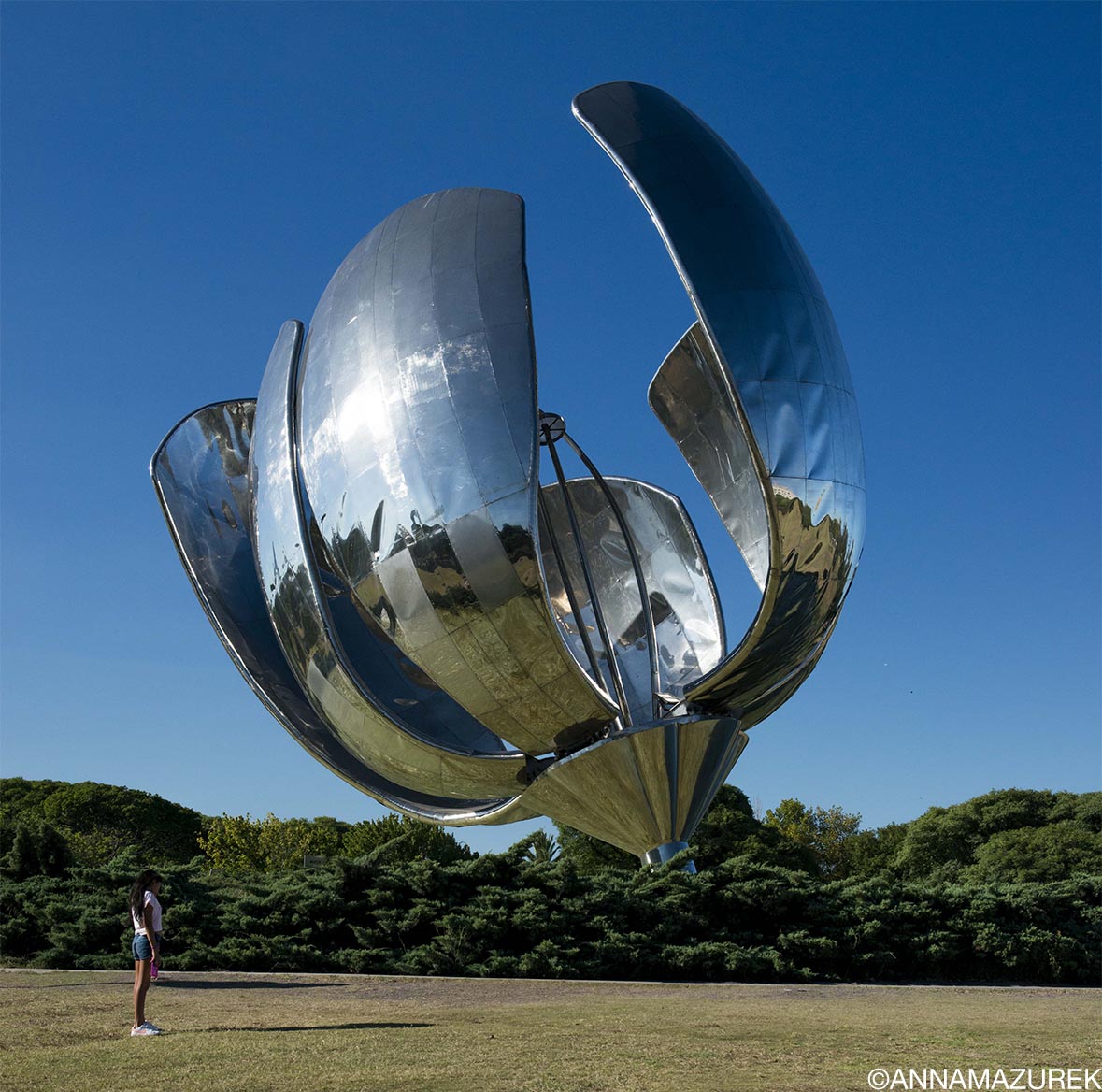 Floralis Genérica is an 18-ton alumiunum sculpture by Eduardo Catalano located in Plaza de las Naciones Unidas.
Floralis Genérica is an 18-ton alumiunum sculpture by Eduardo Catalano located in Plaza de las Naciones Unidas.
Where can you exchange money on the blue dollar rate in Buenos Aires?
If you are bringing U.S. dollars to exchange, make sure you have pristine (no marks or tears) $100 bills. In the past, I’ve used Enviarg Money Transfer, which has a location in Palermo Soho and two in Recoleta. I’ve never had to show a passport or ID to exchange money. I’ve only exchanged a max of $500 at one time. Since rates and regulations are constantly changing, be sure to ask the rate before any transaction.
Otherwise, there’s always Western Union. It’s best to send yourself money through their app (there are fees) because not every location exchanges cash. (This is a great option if you aren’t traveling with a ton of cash.)
Also, it can be tricky to find a Western Union branch that has the amount of money you need so you might be walking around for a while trying different branches. If you go this route, consider doing no more than $200.
While I’ve heard that counterfeits were an issue in the past, I’ve not had any issues. The only people who really look at the bills are store clerks.
Is it cheap to travel in Argentina now?
Argentina is still an affordable place to travel—especially if you are traveling on U.S. dollars—but more expensive than in previous years. This is due to inflation, austerity measures and the removal of public transport subsidies. The locals are the ones hurting the most with the high cost of living. (In early 2022, everything was half price because the blue dollar was so high. Long gone are the days of $37 steak dinners at the famous Don Julio!)
To make the most of your money, check rates before your trip to decide what’s best for you. It can’t hurt to have dollars with you.
Consider using cash to negotiate rates when you can. I’ve always paid cash for my apartments in Buenos Aires, which has enabled me to negotiate rates. The last time, I was able to get the price cut down by almost 30% from $1,400 USD to $950 USD for a spot in Recoleta!
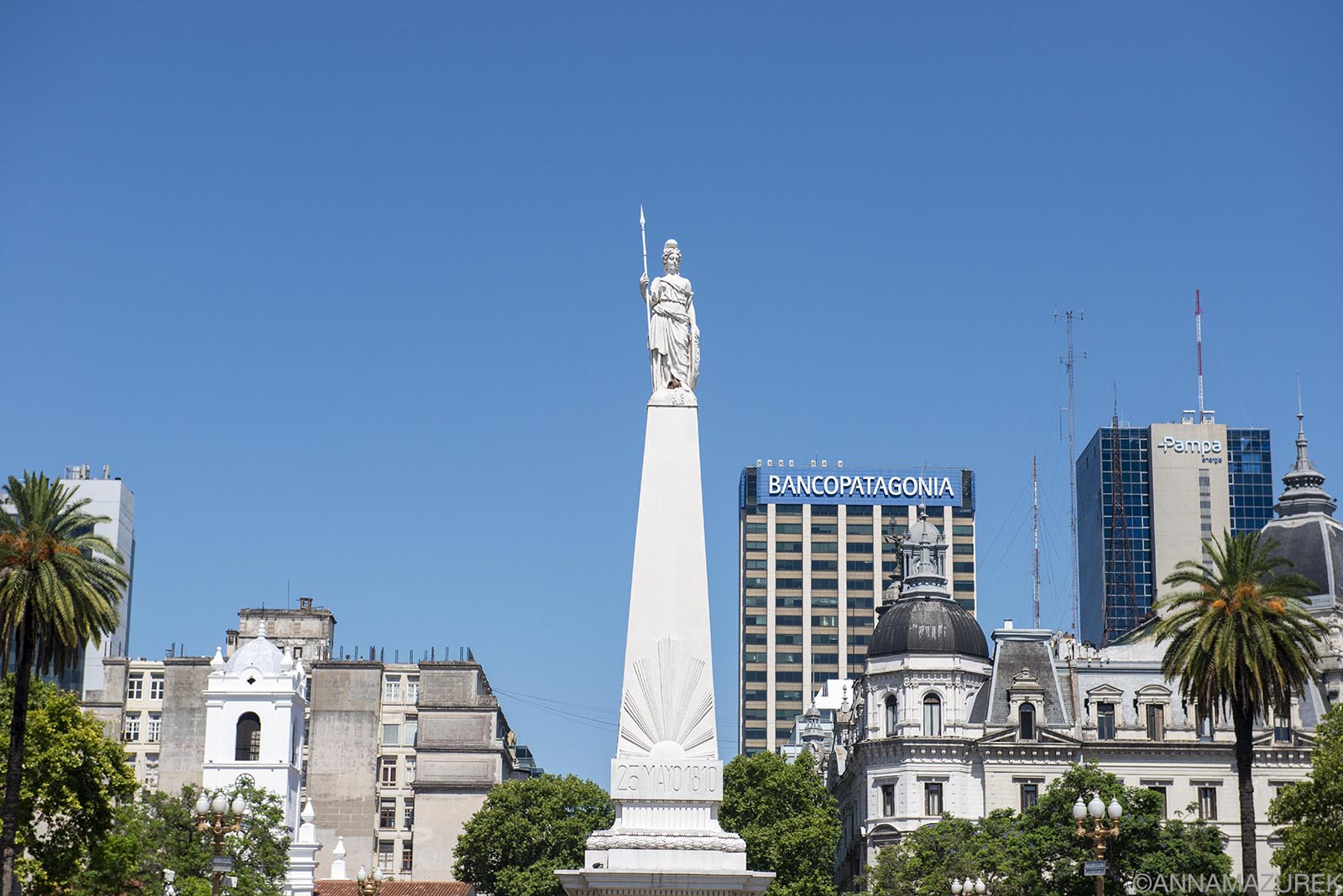 The white obelisk, Pirámide de Mayo, located in Plaza De Mayo, Buenos Aires’ oldest public square, was built to mark the first anniversary from Spain.[/caption]The white obelisk, Pirámide de Mayo, located in Plaza De Mayo, Buenos Aires’ oldest public square, was built to mark the first anniversary from Spain.
The white obelisk, Pirámide de Mayo, located in Plaza De Mayo, Buenos Aires’ oldest public square, was built to mark the first anniversary from Spain.[/caption]The white obelisk, Pirámide de Mayo, located in Plaza De Mayo, Buenos Aires’ oldest public square, was built to mark the first anniversary from Spain.
Is Buenos Aires Safe?
While the inflation is great for those with U.S. dollars, it’s a struggle for those without access. There are more homeless people and people trying to sell you socks and other random things while you are at dinner than there were on my previous trips. (To put it into perspective, the homeless situation in Austin, Texas is tremendously worse than what I’ve seen here lately.)
Petty theft is an issue in Buenos Aires. Watch your bags at all times. I always leave my purse strapped across my body at restaurants. I never put down bags either. (A friend of a friend had their backpack with their laptop swiped from a pub last week.) I don’t feel comfortable working at an outdoor café with my laptop. In 2015, someone tried to pick-pocket my phone out of my purse on the train, but I caught him and got my phone back. (I cornered him on the train and yelled at him until he dropped my phone. Otherwise, I would have jumped on him like a spider monkey.) I would avoid wearing fancy jewelry and Apple Watches.
I keep my passport and money locked in a safe in my apartment. I only take out the money that I need for the day. I also just work from my apartment, so I’m not taking my laptop out in public. When I have my camera, I keep it in my backpack most of the time and never walk around with it strung across my body. The La Boca area is one of the more dangerous ones for petty theft so be careful there. Also, be careful in San Telmo at night and Palermo really late at night.
Do you need travel medical insurance for Buenos Aires?
Yes, travel medical insurance is one of the most important things to purchase for any trip abroad, especially Thailand. It covers all the things that could go wrong from injuries to travel delays so that you don’t have to worry and can focus on traveling!
I use SafetyWing’s Nomad Insurance, which offers $0 deductible travel medical insurance coverage for over 180 countries for people aged 69 and under when traveling outside their home country. The best part is that it only costs a few dollars a day! If you get sick or injured abroad, you can visit any hospital or doctor.
Other benefits of Nomad Insurance include coverage for lost checked luggage, travel delays over 12 hours, motor accidents (if properly licensed, wearing all safety equipment and not intoxicated) and injuries from sports or leisure activities. You can even add adventure sports, electronics theft and U.S. coverage (for non-residents) to your policy.
If you’re abroad for 90 days, you can get 30 days of home-country coverage. (For the U.S. residents, it’s 15 days.) For more details about my experience using SafetyWing in Southeast Asia, read my SafetyWing Review.
Where’s the best place to buy a SIM card in Buenos Aires?
Buying a local SIM card in Argentina is tedious and time consuming because you have to buy it at a phone shop then add credit at a specific type of convenience store, which is hard to find. The easiest thing to do is buy an Argentina specific eSIM card from Airalo that will work instantly when you arrive. To save money, use these promo codes: New customers save 15% off with NEWTOAIRALO15 and existing users save 10% with AIRALOESIM10.
If you are traveling to multiple countries in South America on a short trip, then consider one of their Latin America Regional eSIM cards. Keep in mind it’s always cheaper to buy a country specific eSIM than a regional one.
Be sure to join the free Airalo Loyalty Program to earn 5% cash back for every purchase, which can be redeemed on future purchases! For more about eSIM cards, check out this post on the pros and cons of eSIMs!
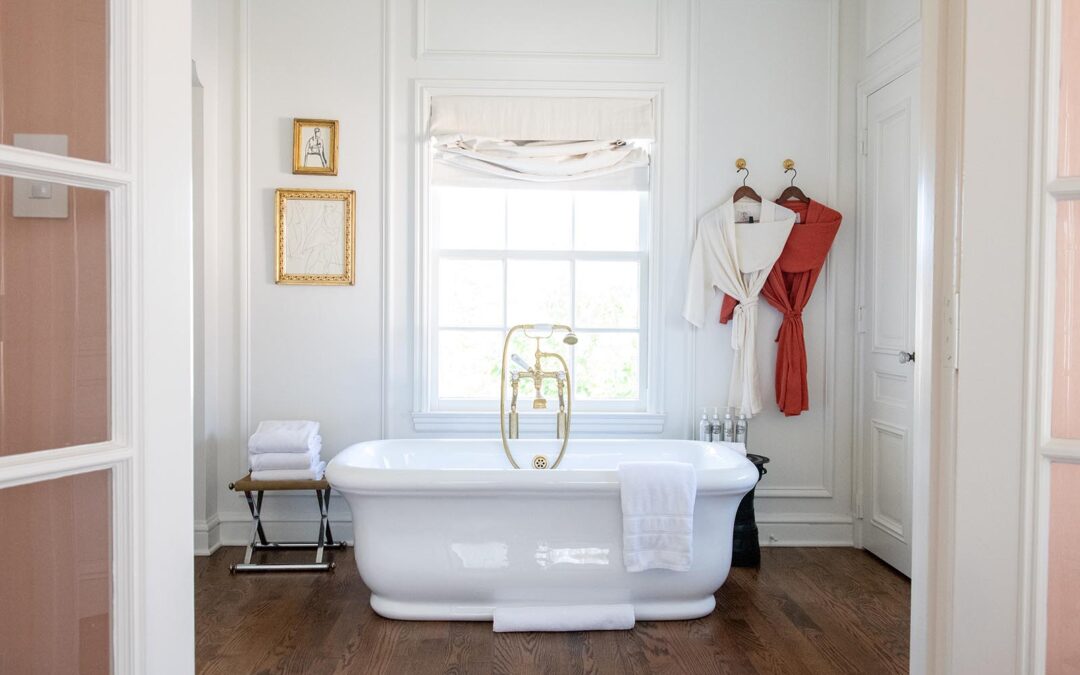
The 10 Best Hotels in Austin: Where to Stay by Neighborhood in 2025
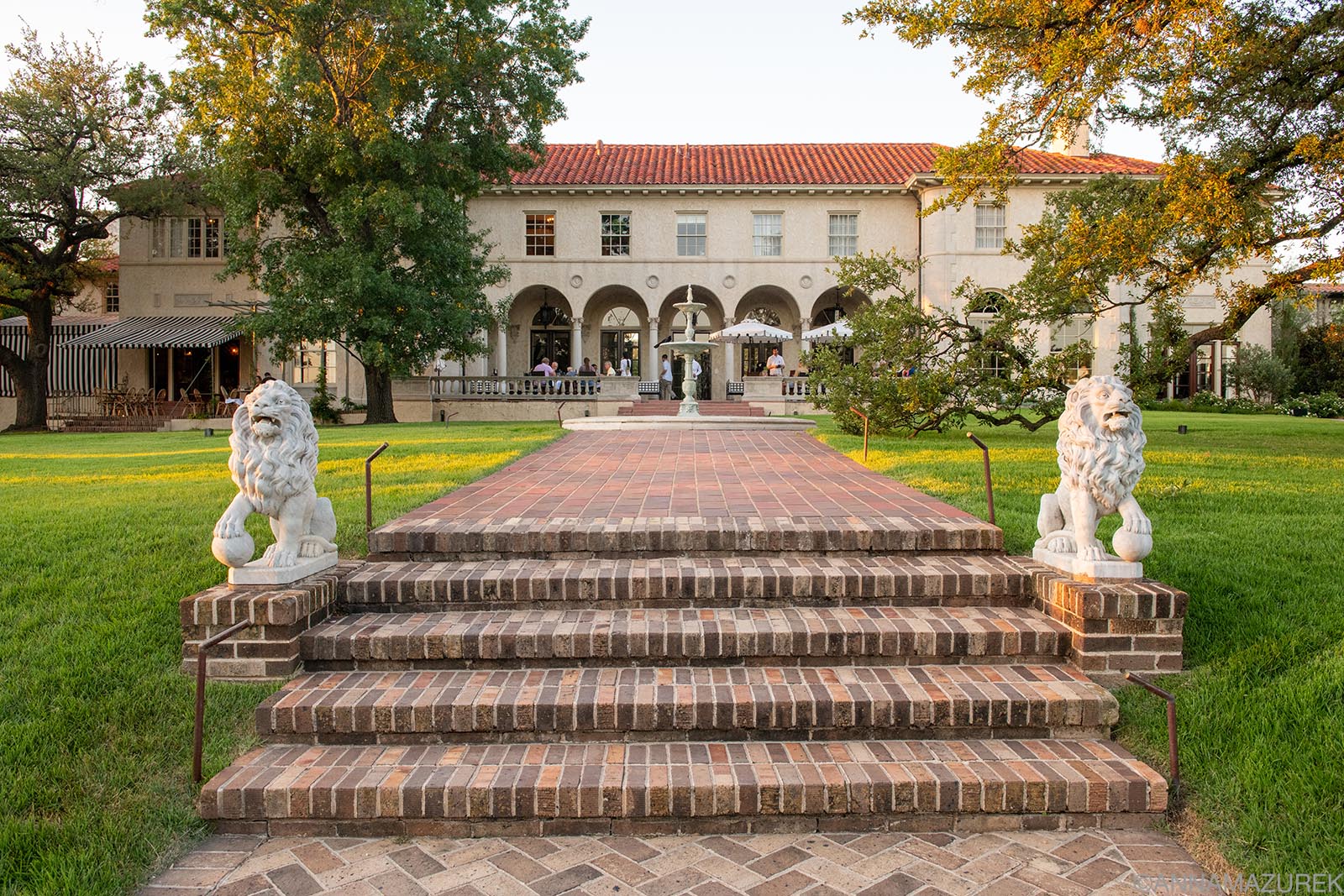 The Commodore Perry Estate is a 1928 mansion that was transformed into a luxury hotel.
The Commodore Perry Estate is a 1928 mansion that was transformed into a luxury hotel.
Austin is booming—the culinary landscape now boasts seven one-star Michelin restaurants, and the live music scene is unmatched. Now, the hotel sector is buzzing with six properties making Travel + Leisure’s World’s Best List. Despite Austin’s rapid growth (the population hovers just under a million), it’s maintained the same small-town vibe that made me move here in 2013. With 30 million tourists visiting the Texas Capital every year, the hotel market is constantly expanding with options for every budget.
To avoid sitting in the notorious I-35 traffic jams that rival L.A., stay in the area you’ll be hanging out in the most. (Austin’s public transit consists mostly of buses and one train line that’s built only for commuters, so ride shares are the easiest way to get around.)
From South Congress to Barton Creek, keep reading for the best hotels in Austin, organized by neighborhood, from bougie to budget friendly. If you’re looking for things to do in Austin or where to eat in Austin, I’ve also written posts about both.
Affiliate links are used in this post. If you make a purchase, I earn a small commission at no cost to you, which goes toward the cost of maintaining this blog.
Hotel List
Just want the list? Here’s a quick round down of the best hotels in Austin.
Four Seasons Austin: Booking.com// Expedia // website
Driskill Hotel: Booking.com // Expedia // website
Austin Proper Hotel: Booking.com // Expedia // website
South Congress Hotel: Booking.com // Expedia // website
Austin Motel: Booking.com // Expedia // website
Frances Modern Inn: Booking.com // Expedia // website
Commodore Perry Estate: Booking.com // Expedia // website
Archer Hotel Austin: Booking.com // Expedia // website
Lone Star Court: Booking.com // Expedia // website
Omni Barton Creek: Booking.com // Expedia // website
The Best Neighborhoods to Stay in Austin
Not sure where to stay? Here’s a quick breakdown of the Austin’s main neighborhoods.
-
Downtown: Urban skyline, walkable, nightlife hubs
-
South Congress: Hip boutiques, live music, eclectic restaurants
-
East Austin: Artsy and laidback, food trucks, breweries and dive bars
-
Domain: Modern shopping, tech, upscale suburban feel
-
Hyde Park: Historic homes, tree-lined streets, quiet charm
-
Barton Creek: Hill Country views, golf, luxury resorts, nature trails
Best Hotels in Downtown Austin
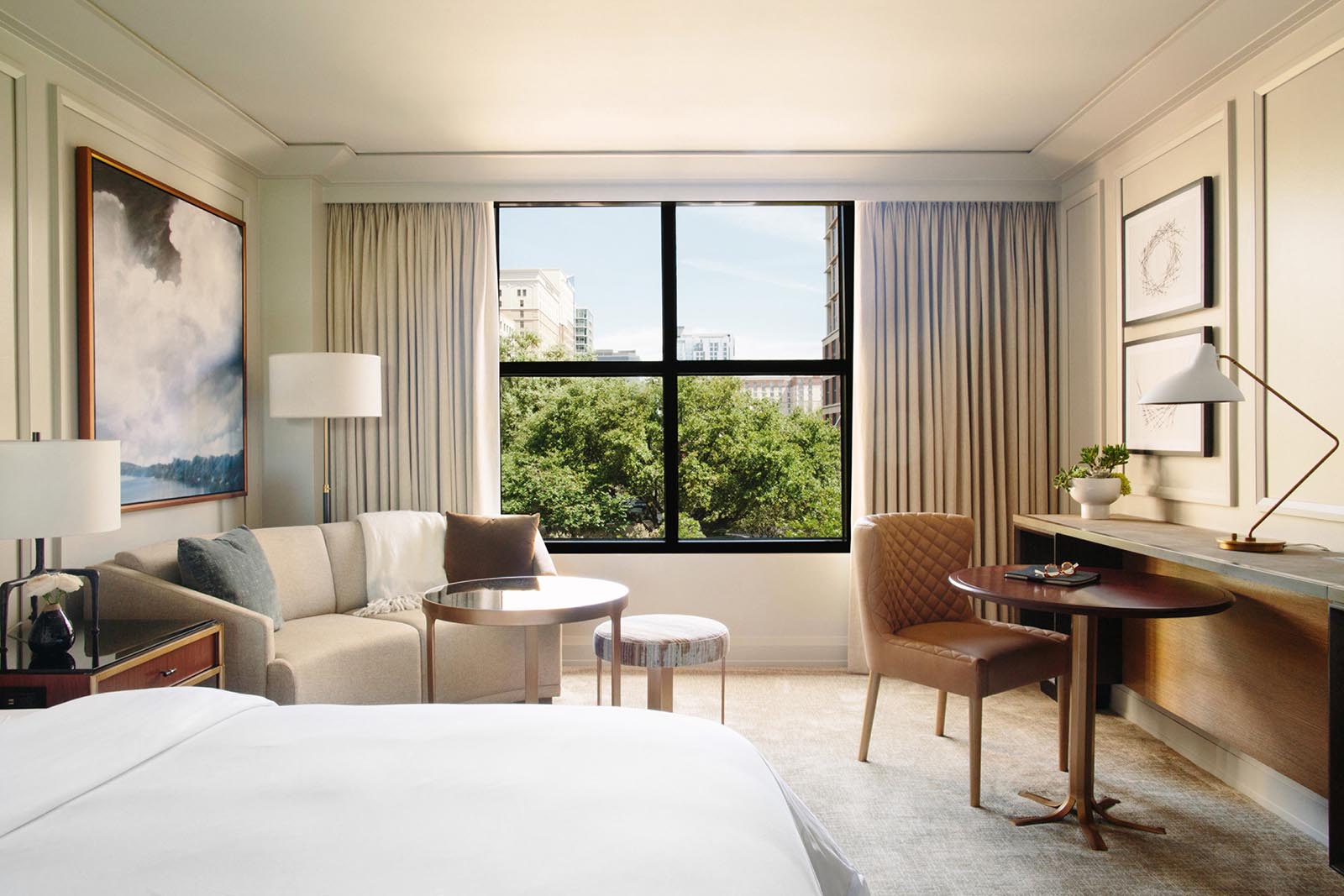 The Four Seasons Hotel Austin offers great views of the skyline and Lady Bird Lake. Photo courtesy of the Four Seasons.
The Four Seasons Hotel Austin offers great views of the skyline and Lady Bird Lake. Photo courtesy of the Four Seasons.
Four Seasons Hotel Austin
Typical starting/peak prices: $650/$1300
Best for: Luxury Travelers, Couples, Business Travelers, Events, Families
On-site amenities: Saltwater outdoor pool, spa, fitness center, multiple restaurants & bar, paid valet parking, event space, lake access, kids’ programs
Pet Friendly: Yes, pets are free.
Book Now: Booking.com// Expedia // website
Unparalleled, direct access to Lake Bird Lake and the shoreside trails is the big draw for the Four Season’s Austin, a hidden refuge in the heart of the city. While the comfortable rooms and lavish amenities will make it hard to leave the property, the location is unbeatable for exploring downtown.
Take advantage of the hotel’s seasonal events and programming, ranging from an annual summer speakeasy pop-up to a winter ice rodeo. These events are open to non-guests making them a big draw for locals.
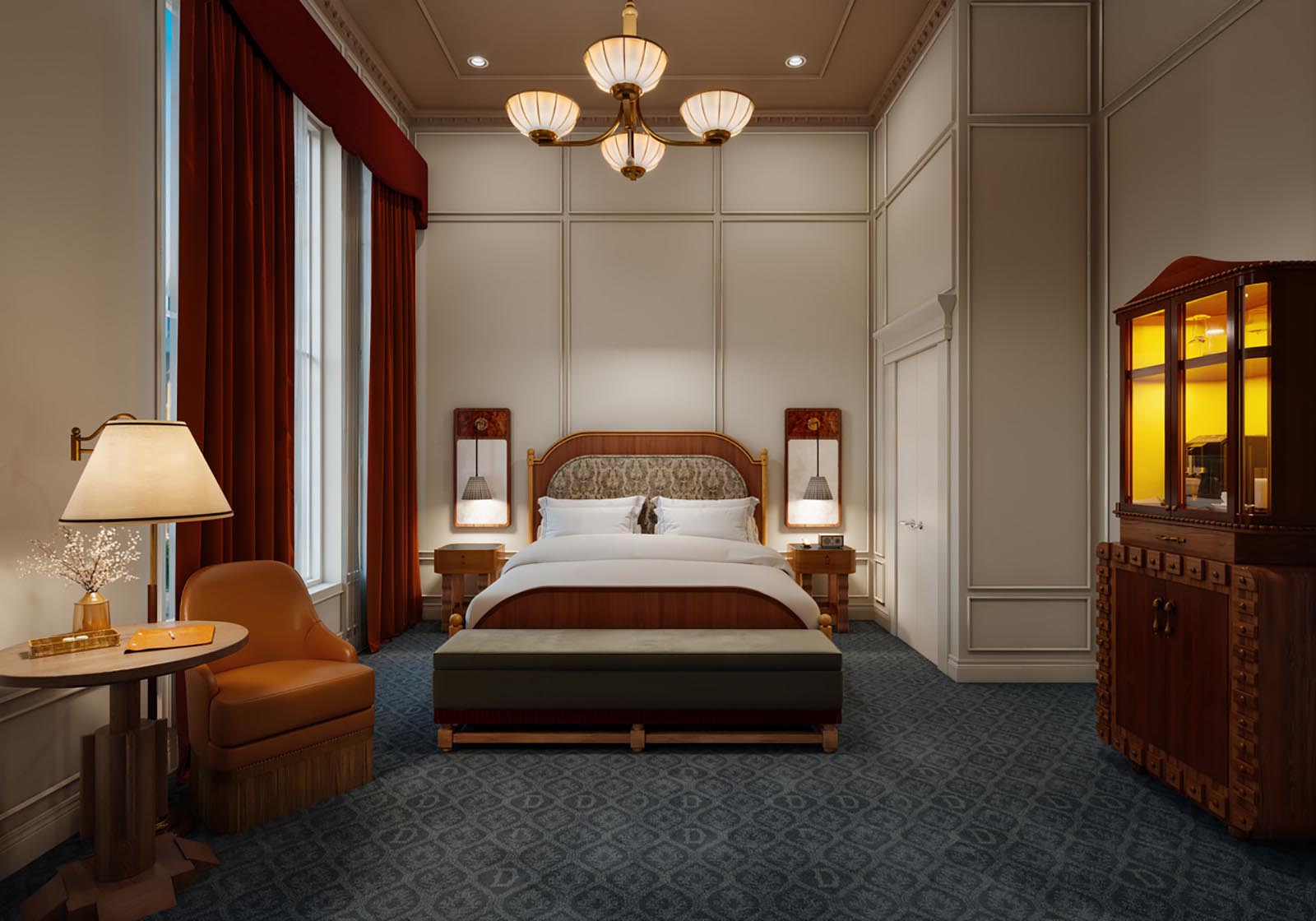 The Driskill Hotel is listed on the National Register of Historic Places. Rendering courtesy of Driskill Hotel.
The Driskill Hotel is listed on the National Register of Historic Places. Rendering courtesy of Driskill Hotel.
Driskill Hotel
Typical starting/peak prices: $299/$648
Best for: History Buffs, Couples, Business Travelers, Events
On-site amenities: Historic property, restaurant, bar, fitness center, paid valet parking, event/ballroom spaces, pet amenities, concierge
Pet Friendly: Yes, pet fee $100 per stay.
Book Now: Booking.com // Expedia // website
Built in 1886, this 18,000-square-foot historic property was the state’s first luxury hotel—President Lyndon B. Johnson and Lady Bird Johnson had their first date in the dining room. (The Governor’s Suite was perpetually reserved for Johnson.) Located on Sixth St., the hotel is only blocks from the Capitol Building.
The property will celebrate its 140th anniversary in December 2026 and a full renovation set to complete in summer 2026. The hotel is open during the process with the fall 2025 debut of the 110 tower guest rooms, new ballroom, fitness center and three dining concepts, including a cocktail lounge named The Victorian.
 The Peacock Mediterranean Grill at the Austin Proper Hotel. Photo courtesy of Austin Proper Hotel.
The Peacock Mediterranean Grill at the Austin Proper Hotel. Photo courtesy of Austin Proper Hotel.
Austin Proper Hotel
Typical starting/peak prices: $360/$900
Best for: Luxury Travelers, Couples, Solo Travelers, Business Travelers
On-site amenities: Rooftop pool and bar, multiple restaurants, paid valet parking, fitness center, spa, event space, concierge
Pet Friendly: Yes, pet fee $100 per stay.
Book Now: Booking.com // Expedia // website
This luxury hotel is nestled on the western side of downtown in the Seaholm district with great skyline views and a stunning rooftop pool. Each of the modern 238 rooms features floor-to-ceiling windows (with blackout drapes) and interiors selected by Kelly Wearstler to reflect the city’s Craftsman style, featuring local art and barefoot-friendly rugs. Fitness buffs will love the 2,000-square-foot gym, cold plunge and sauna. Four dining and bar options will keep you well-fed, from poolside breakfast tacos to Texas Wagyu beef tartare.
Best Hotels in South Congress
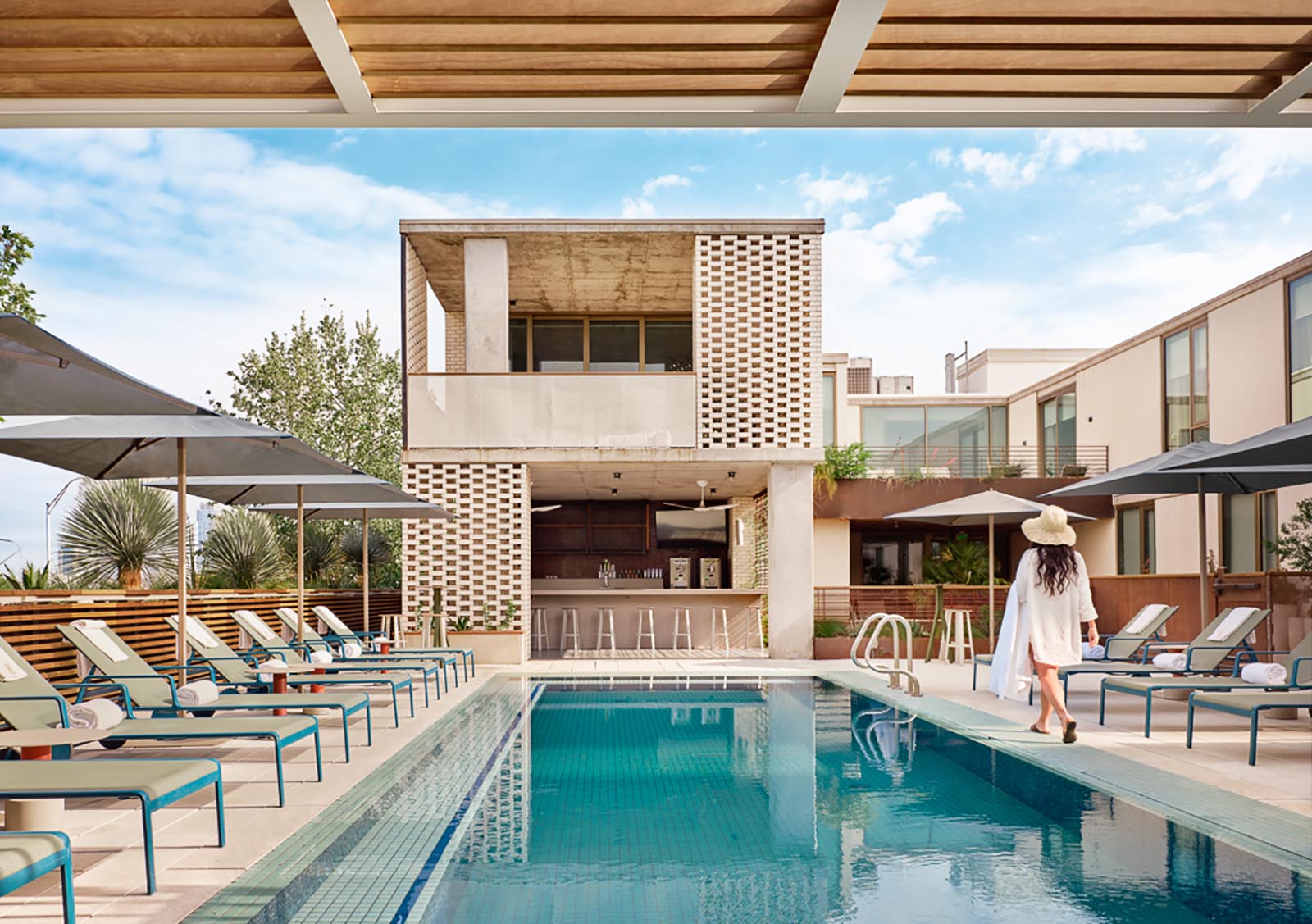 The rooftop pool at the locally-owned South Congress Hotel. Photo by Casey Dunn.
The rooftop pool at the locally-owned South Congress Hotel. Photo by Casey Dunn.
South Congress Hotel
Typical starting/peak prices: $192/$590
Best for: Couples, Foodies, Solo Travelers, Business Travelers
On-site amenities: Rooftop pool and pool bar, multiple restaurants (Japanese omakase, all-day café, chophouse, bake shop), paid parking (valet and self), fitness center, concierge, retail shops
Pet Friendly: Yes, pets are free.
Book Now: Booking.com // Expedia // website
If you want to stay in the heart of South Congress Avenue, there’s no better location with all shops and main attractions within walking distance and easy access to downtown. Families will love the larger suites with private balconies. All rooms have walk-in showers with rainfall shower heads, and locally-sourced mini bars, but the best rooms have rooftop pool views.
This locally-owned spot is a favorite hangout for Austinites thanks to six on-site dining and drink options, including Otoko (12-seat omakase restaurant), Café No Sé (all-day cafe serving up some one of the town’s best breakfasts) and the Watertrade cocktail bar.
 One of Austin Motel’s funky rooms. Photo by Grant Pifer.
One of Austin Motel’s funky rooms. Photo by Grant Pifer.
Austin Motel
Typical starting/peak prices: $193/$329
Best for: Couples, Solo Travelers, Budget Travelers, Pet Owners
On-site amenities: Outdoor pool, free parking, bar/lounge, bodega, complimentary coffee, lobby shop
Pet Friendly: Yes, pets are free.
Book Now: Booking.com // Expedia // website
The property’s 1938 neon sign with ever-changing quirky messages is an Austin icon, like the hotel itself—a retro motor court continuously operated since the sign was put up. The unique 1,100-square-foot kidney-shaped pool is a draw for locals who often take advantage of the daily pool passes. The funky rooms have big pops of color with midcentury-modern inspired furnishings and brightly patterned walls. Texans get a preferred rate when booking directly.
Best Hotels in East Austin
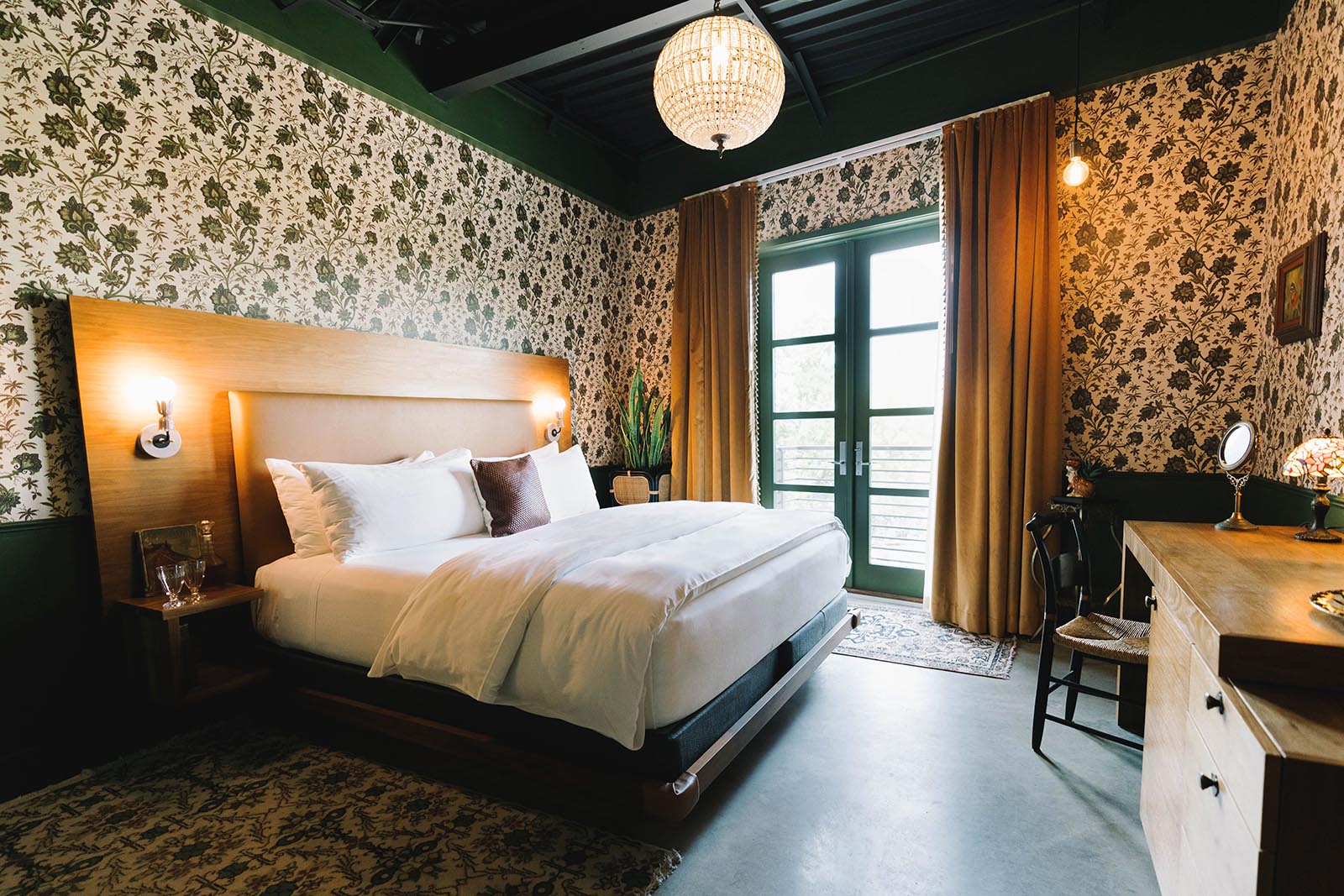 Frances Modern Inn’s medium rooms come with a Juliet balcony. Photo courtesy of France Modern Inn.
Frances Modern Inn’s medium rooms come with a Juliet balcony. Photo courtesy of France Modern Inn.
Frances Modern Inn
Typical starting/peak prices: $174/$454
Best for: Solo Travelers, Couples, Urban Explorers, Business Travelers
On-site amenities: Rooftop terrace, restaurant, free parking, lounge, concierge, complimentary coffee/tea in lobby, individually decorated rooms
Pet Friendly: No
Book Now: Booking.com // Expedia // website
This 15-room boutique hotel is just steps from famed Franklin’s Barbecue. Named after the owner’s grandmother, the space features one-of-a-kind rooms with unique color palettes reminiscent of your grandmother’s house, including whimsical door knockers ranging from a pineapple to a blinking cat. The medium rooms feature Juliet-style balconies while the extra-large room is a two-story space with private entry and a clawfoot tub. Soak in the skyline views while sipping a cocktail on the rooftop.
Best Hotels in Hyde Park (Hancock)
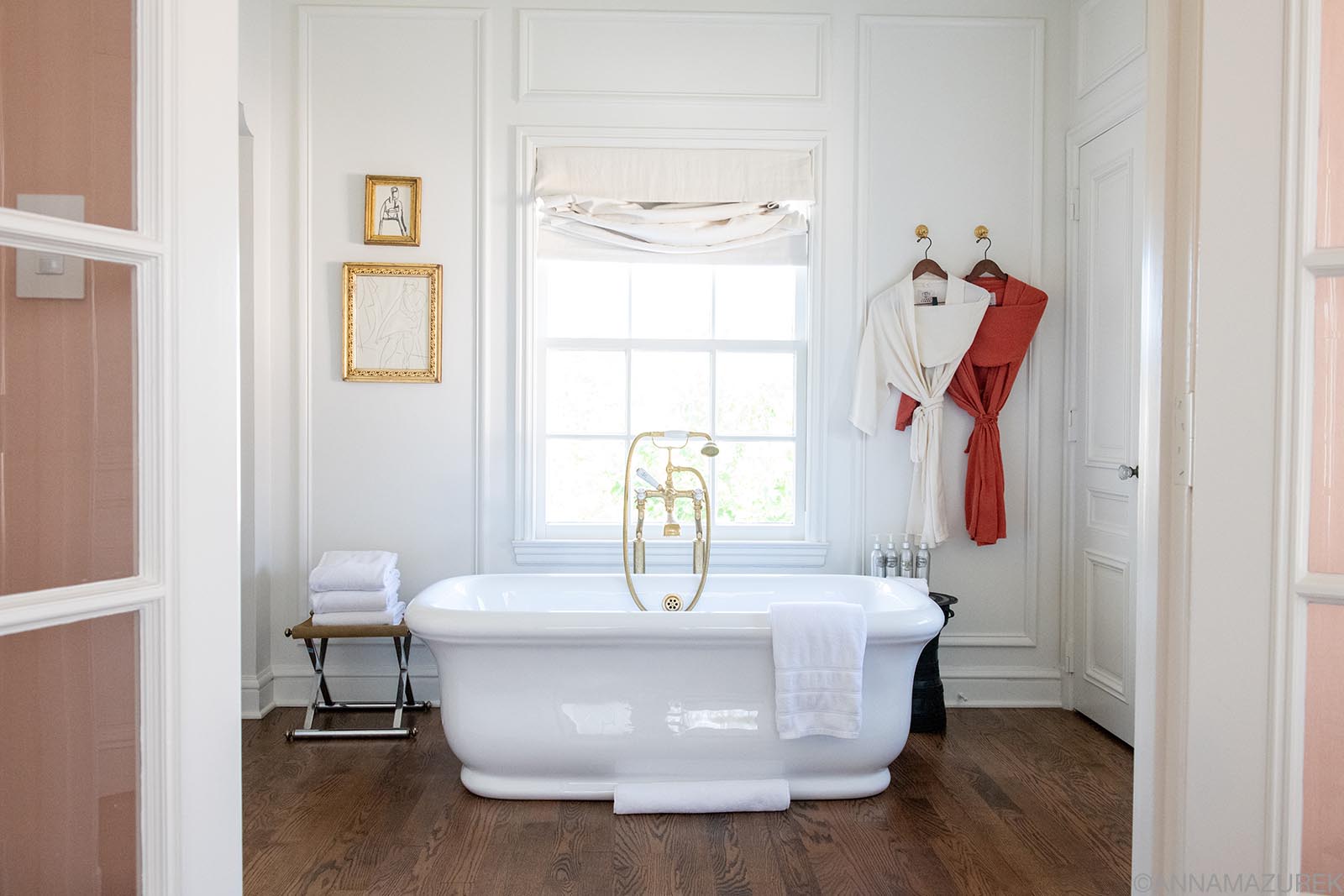 The bathroom in the Mr. & Mrs. Perry Suite at the Commodore Perry Hotel.
The bathroom in the Mr. & Mrs. Perry Suite at the Commodore Perry Hotel.
Commodore Perry Estate
Typical starting/peak prices: Starting at $496 but vary greatly by room type.
Best for: Luxury travelers, couples, wellness seekers
On-site amenities: Pool, 24-hour fitness center, wellness classes, ten acres of private gardens, historic chapel, complimentary guest bikes, valet parking, weekly live music
Pet Friendly: Yes, up to two pets under 60 lbs., $90 per night; includes amenities.
Book Now: Booking.com // Expedia // website
A 1928 mansion is the centerpiece of the 10-acre estate featuring a newly built three-story inn, giant oak trees and sculptured English gardens. Named after the original owner, businessman Edgar “Commodore” Perry, the estate has 54 rooms and 11 suites that make you feel as if you’ve traveled to Europe minus the jetlag.
Each of the mansion’s five original rooms was designed by Ken Fulk. (Pink Floral patterns cover the walls and ceiling of my favorite room, the LaVerne Suite.) Fulk also designed the garden-themed interior of Lutie’s, the on-site dinner and weekend brunch restaurant. (I still dream of the estate bread with layered butter and pastry dishes.)
Best Hotels in The Domain (North Austin)
 The photogenic lobby at Archer Hotel Austin. Photo courtesy of Archer Hotel Austin.
The photogenic lobby at Archer Hotel Austin. Photo courtesy of Archer Hotel Austin.
Archer Hotel Austin
Typical starting/peak prices: $188/$425
Best for: Couples, Business Travelers, Shoppers, Families
On-site amenities: Pool with free cabanas, paid parking, 24-hour fitness and business center
Pet Friendly: Yes, pet fee $75 per stay.
Book Now: Booking.com // Expedia // website
With a chandelier-clad lobby and poolside fire pit, it’s no wonder this Domain hotel landed on the Travel + Leisure World’s Best List for the top five hotels in Austin. The “Texas chic” rooms feature floor-to-ceiling photo murals of iconic Texas scenes and five-star bedding with a mix of down pillows. Watch the UT game from the 14-foot TV while lounging in the Lone Star-inspired splash pool, while nibbling on a pizza. Or grab a cocktail during the “sunset hour” happy hour from the on-site AKB bar.
Lone Star Court
Typical starting/peak prices: $133/$409
Best for: Couples, Families, Business Travelers, Music Lovers
On-site amenities: Outdoor pool, live music, bar/restaurant, free parking, fire pit, deluxe rooms, SMEG refrigerators, wrap-around porches
Pet Friendly: Yes, pet fee $50 per stay.
Book Now: Booking.com // Expedia // website
Tucked on four acres of North Austin, The Lone Star Court Hotel is nestled in the quieter side of the ever-expanding Domain, a shopping, entertainment and residential complex. The property resembles a modern retro-motor court with resort amenities, including fire pits, lawn games, a pool and complimentary bicycles.
The 123 rooms include classic Texas elements, such as sliding barn-style bathroom doors and cowhide director’s chairs and are situated on ranch-house-style breezeways lined with rocking chairs.
Best Hotels in Barton Creek (Hill Country)
 The Omni Barton Creek offers Hill Country views only 10 miles from downtown. Photo courtesy of Omni Barton Creek.
The Omni Barton Creek offers Hill Country views only 10 miles from downtown. Photo courtesy of Omni Barton Creek.
Omni Barton Creek
Typical starting/peak prices: $273/$709
Best for: Families, Golfers, Spa Enthusiasts, Couples, Business Travelers
On-site amenities: Four golf courses, multiple pools (including adults-only), nine dining outlets, paid valet & free self-parking, spa, tennis courts, large fitness center, kid’s programs
Pet Friendly: Yes, pet fee $125 per stay.
Book Now: Booking.com // Expedia // website
This 4,000-acre Hill Country refuge always ranks as one of the best resorts in Texas because of the wide range of lavish amenities from four 18-hole golf courses to the Mokara Spa, a 13,000-square-foot sanctuary featuring a private heated infinity pool. There are four pools—including an adults-only infinity pool. For children, there are nature hiking trails, movie nights, splash pads family-friendly pools and programming.
Rooms range in size from 425 square feet to the 1,800-square-foot suites with a private oversized terrace. Located only 10 miles from downtown Austin, it’s easy to explore the city or visit from the city for a spa day. (Day passes are available for spa guests.) Members of Texas Exes, the UT alumni association, receive 20% off rooms, a $75 resort credit and a complimentary room upgrade based on availability.

Where to Eat Like a True Austinite: The Best Restaurants in Austin
 For dinner or weekend brunch, stop by Lutie’s to check out the interior designed by Ken Fulk.
For dinner or weekend brunch, stop by Lutie’s to check out the interior designed by Ken Fulk.
From traditional Texas barbecue to wild boar pepper pots and red berry concha (a sweet bread), the Austin food scene offers a diversity of flavors. It’s hard to choose between the longstanding famous icons—Franklin’s Barbecue for brisket and Kerby Lane for pancakes—and newcomers—Taqueria De Diez’s volcan tacos.
Planning is key when it comes to Austin’s food scene: Make reservations in advance. For places that don’t take reservations, arrive early with sunscreen—waiting in line for food is a Texas pastime. Expect queues at all barbecue joints (an hour minimum on weekends), weekend brunch and famous spots. The best barbecue spots open at lunch, so arrive early for the best selection and visit on a weekday for shorter wait times. Online orders are also a possibility to save time.
Now, you know the rules—it’s time to eat. Keep scrolling for the best restaurants in Austin, Texas. To help plan your trip, check out my guides on the best things to do in Austin and the best Austin hotels organized by neighborhood.
The Best Barbecue in Austin, Texas
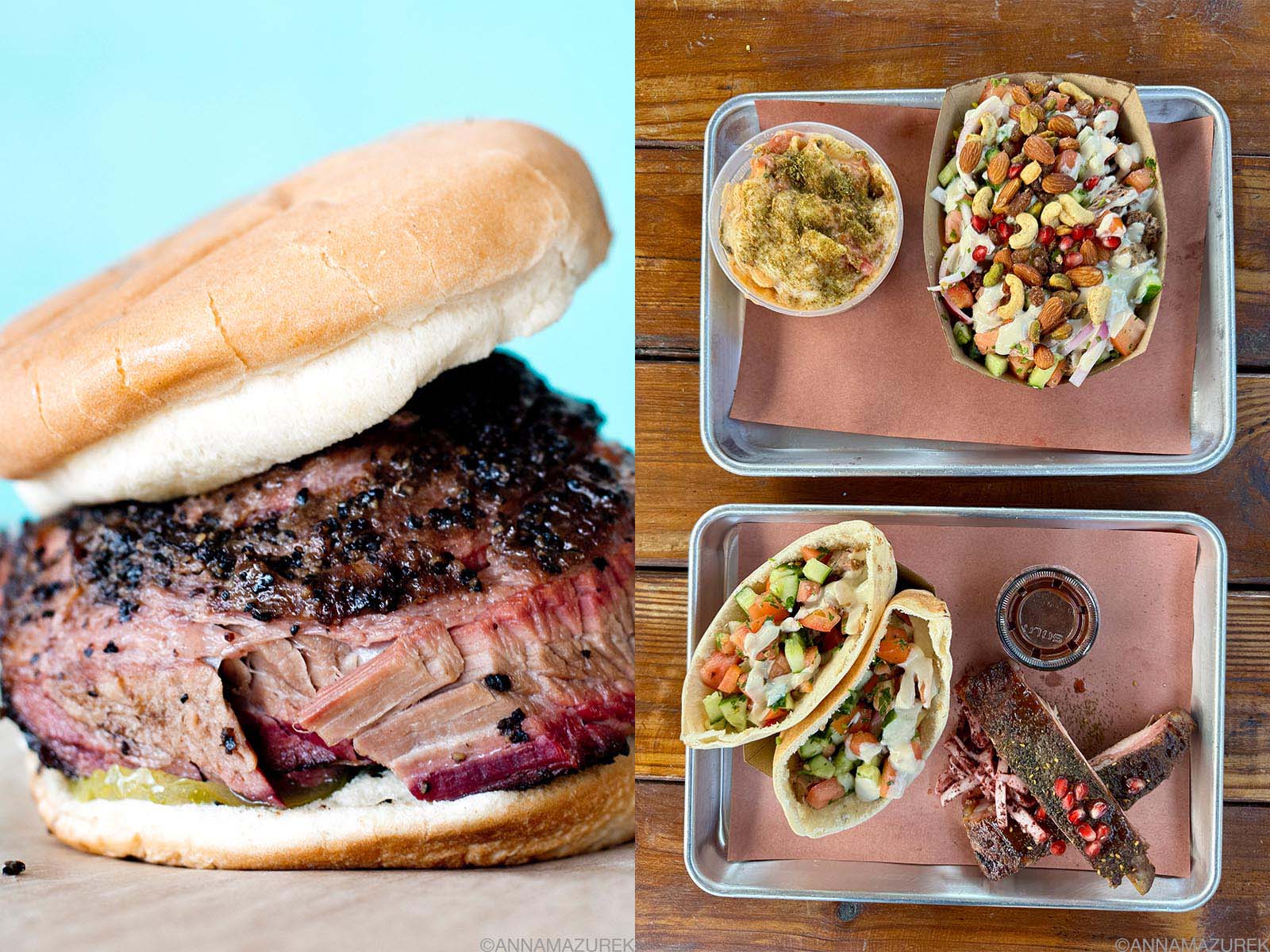 Left: A brisket sandwich from Franklin’s Barbecue. Right: The pomegranate-glazed pork ribs at the Egyptian-inspired KG Barbecue.
Left: A brisket sandwich from Franklin’s Barbecue. Right: The pomegranate-glazed pork ribs at the Egyptian-inspired KG Barbecue.
There is always a line for barbecue, but most places have free beer while you wait. Order online to skip the queues.
-
If Franklin Barbecue is your destination, wake up early and join the roughly 4-hour-long queue before 9 a.m. It’s just like tailgating for a football game, minus the traffic, so bring a chair and some local brews. Order online to skip the queue.
-
For shorter lines, try Micklethwait Craft Meats for sausage, turkey (my favorite) and jalapeno cheese grits. This is one of my favorite go-to spots because I’m a sucker for good sides.
-
La Barbecue’s Eastside location is great for brisket, pulled pork and shells & cheese.
-
LeRoy and Lewis Barbecue, a 2024-Michelin star winner, serves up tasty brisket and beef ribs in their brick-and-mortar location. The brisket burger and cheddar cheesecake are also phenomenal.
-
Interstellar BBQ in North Austin has made the Texas Monthly’s top five list. Aside from the brisket, the turkey, jalapeños slaw and banana pudding are delicious.
-
KG Barbecue fuses Egyptian and Middle Eastern flavors with traditional barbecue—the pomegranate-glazed pork ribs and brisket shawarma pitas.
The Best Brunch in Austin, Texas
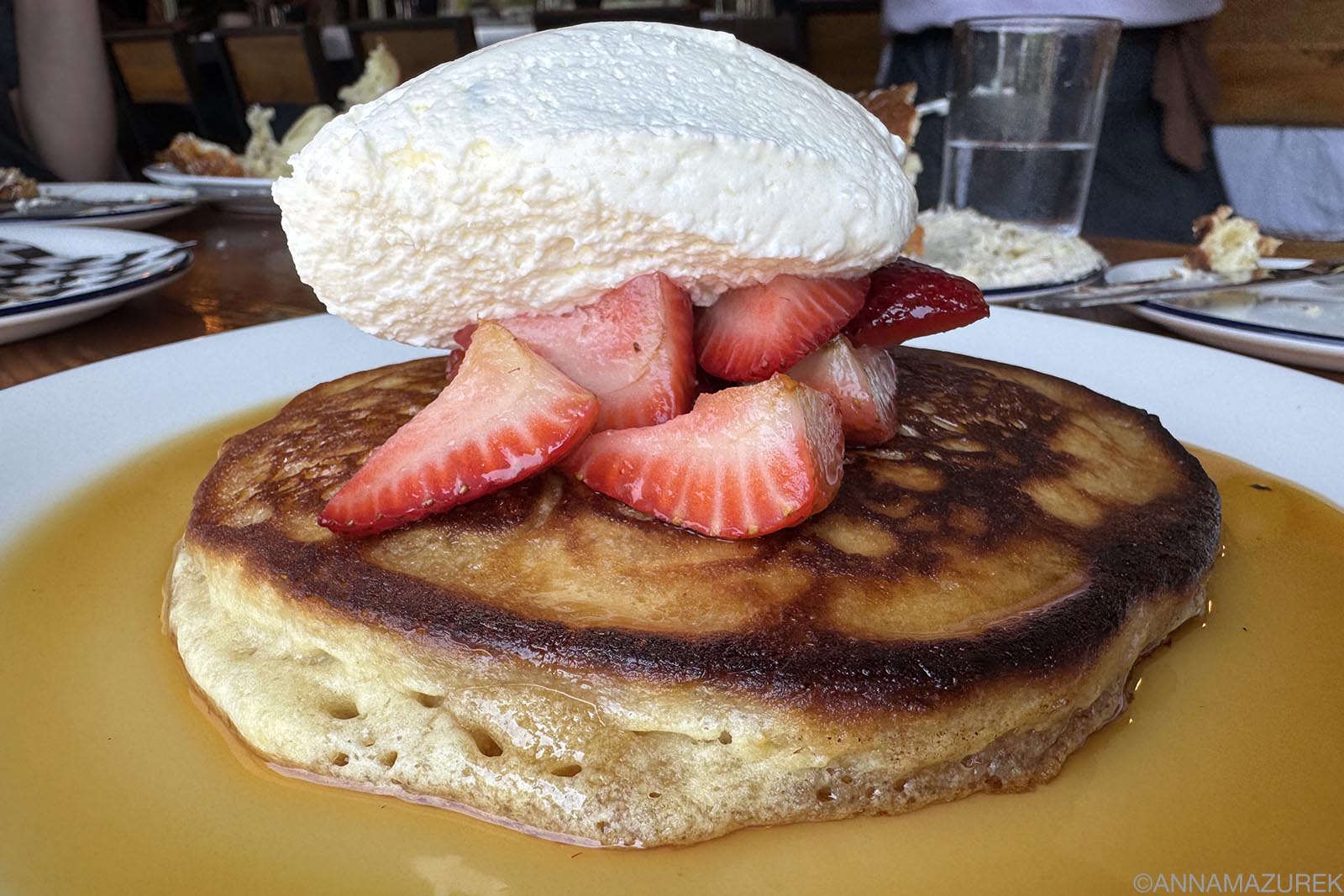 Chef Sarah Heard cooks up the perfect pancake at Foreign & Domestic.
Chef Sarah Heard cooks up the perfect pancake at Foreign & Domestic.
- Lutie’s is one of my favorite dinner spots that serves a scrumptious brunch ranging from Spanish frittatas to brioche French toast. Grab a pastry basket with one of pastry chef Susana Querejazu’s famous Kouign Amanns. Saturday and Sunday. Reservations recommended.
- Foreign & Domestic’s chef Sarah Heard cooks up the best pancakes in town with the perfect amount of crisp on the outside. (She perfected the cooking technique thanks to her picky daughter.) Sunday only. Reservations recommended.
- Banger’s Sausage House and Beer Garden is legendary thanks to the Manmosa, a behemoth-sized mimosa consisting of a bottle of champagne with a splash of orange juice. The menu features house-made sausage, meat-heavy egg dishes and gigantic flaky made-from-scratch biscuits. The restaurant has plenty of seating thanks to an expansion a few years ago but doesn’t take reservations, so expect a line. Sunday only.
- Wu Chow serves dim sum on Sundays only. Menu highlights include pork pot stickers, char siu bao (steamed pork buns), scallion pancakes, pineapple bao and a Thai-chili infused Bloody Mary. Reservations recommended.
- Jacoby’s is my go-to Eastside brunch spot that takes brunch reservations! The grits and strawberry cake are delicious. Saturday and Sunday. Reservations recommended.
- Café No Se is another favorite breakfast eatery located in the South Congress Hotel. Start off with one of their signature pastries—a delectable croissant served with homemade raspberry jam. (Their pastry chef, Amanda Rockman, is a James Beard Award Semifinalist.) I also recommend the ricotta hotcakes. Breakfast is served daily.
The Best Restaurants in Austin
These restaurants are organized by type from casual to upscale.
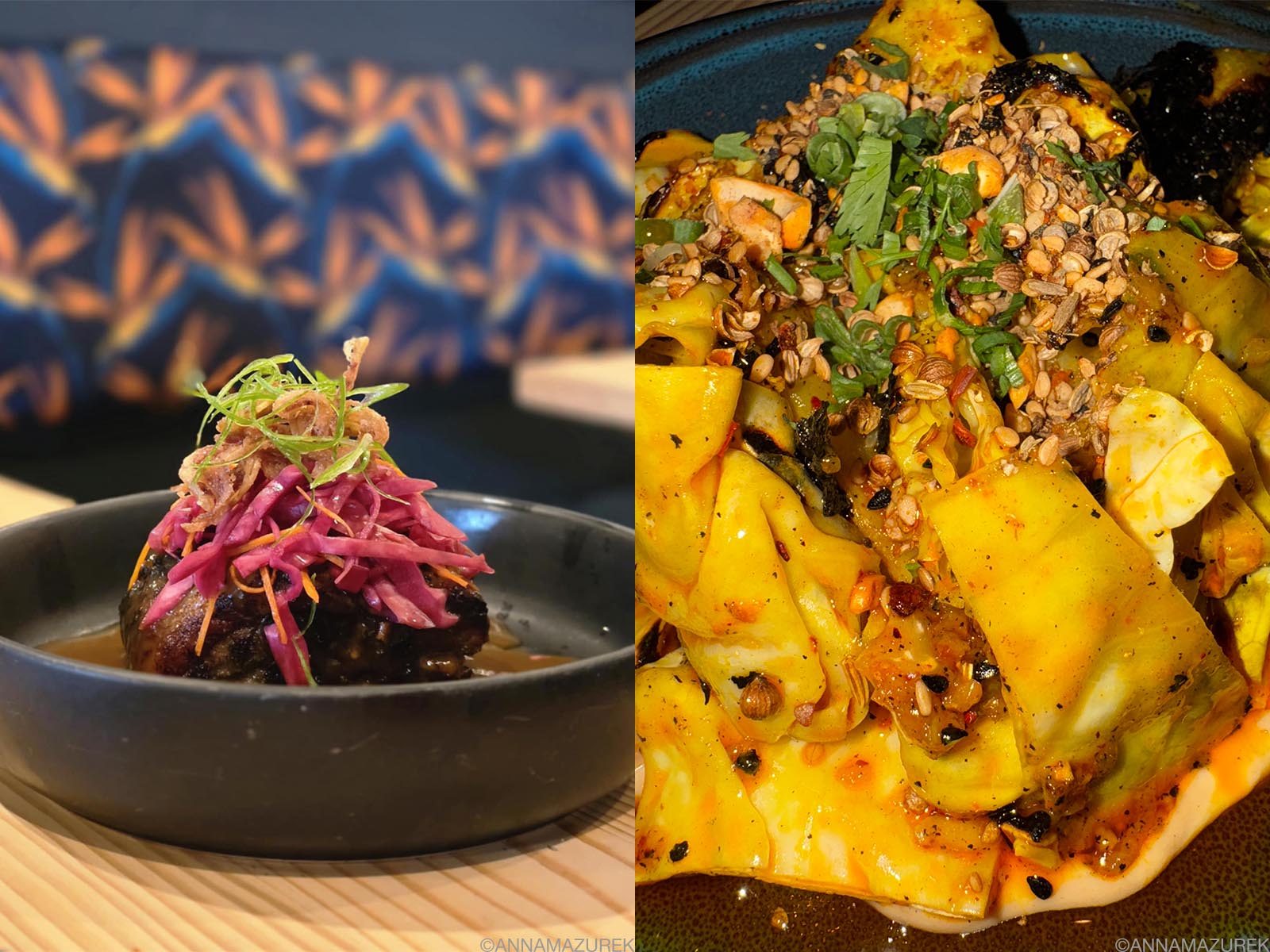 Canje’s modern Caribbean-inspired dishes—pork shoulder and grilled cabbage—should be at the top of your list.
Canje’s modern Caribbean-inspired dishes—pork shoulder and grilled cabbage—should be at the top of your list.
Upscale Restaurants in Austin
- Canje should be your first stop in Austin. The new-age Caribbean restaurant is named after the national bird of Guyana and serves up one of my favorite dishes in town: wild boar pepperpot, a slow-cooked stew. The Guyanese-style roti pairs well with the Wagyu beef West Indian curry.
- Lutie’s is a must for dinner. The garden restaurant’s playful interior was designed by Ken Fulk, which really sets the mood for a fun evening. The menu includes a variety of small, highly seasonal dishes meant to be shared. Highlights include the estate bread with layered butter, the green dish, Texas beef and the kouign-amann dessert, a French pastry that’s broken into pieces and folded into vanilla ice cream. It is located on the Commodore Perry Estate, a 1928 mansion turned luxury hotel. Reservations recommend.
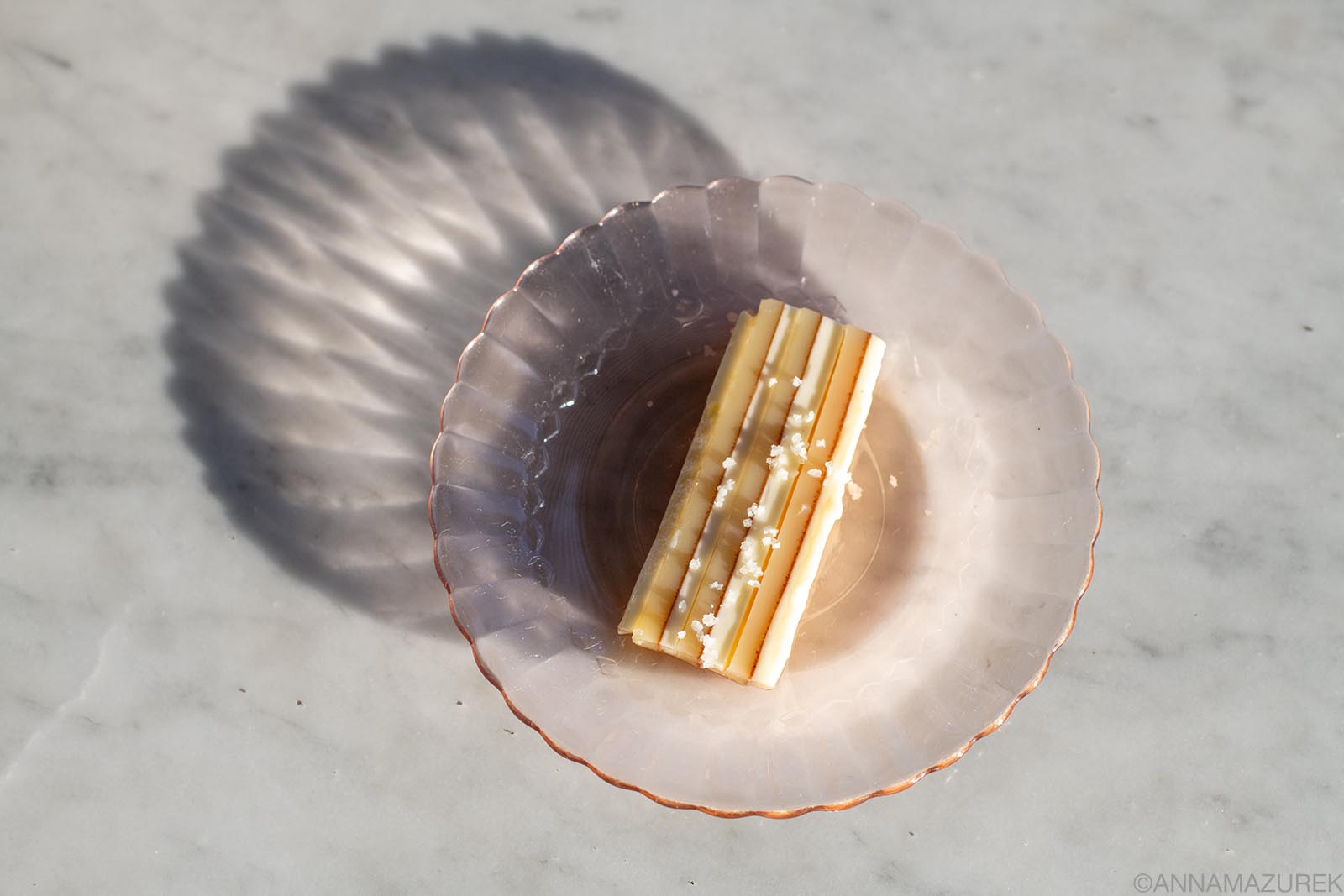 Lutie’s layered butter is both photogenic and delicious.
Lutie’s layered butter is both photogenic and delicious.
- Mattie’s is a truly hidden gem located in a secluded 19th-century home just a few blocks from the buzzing South Congress neighborhood. The resident peacocks provide ample entertainment while you dine on fried chicken and biscuits.
- Eberly is a swanky multi-room restaurant with two patios and a separate bar with a stunning centerpiece – a mahogany wooden bar that was moved from New York City’s Cedar Tavern to Austin. It’s one of the most beautiful restaurants in Austin. Reservations recommend.
- Fixe, an upscale Southern restaurant, is famous for its made-from-scratch, while-you-wait biscuits. It’s the best $12 you will EVER spend.
- Ember Kitchen specializes in live-fire cooking with Latin flavors. Order the pork chop and carrots. Trust me. Snag a seat at the bar by the kitchen to watch the magic.
Casual Dining in Austin
 Left: Taqueria de Diaz’s volcán tacos are arguably the best in town. Right: Yellow Jacket Social Club beet and goat cheese sandwich.
Left: Taqueria de Diaz’s volcán tacos are arguably the best in town. Right: Yellow Jacket Social Club beet and goat cheese sandwich.
- Pinthouse Pizza is an award-winning brewery that serves up Sicilian-style pizzas. They have three locations and a gigantic South Austin brewery. Pinthouse’s Electric Jellyfish brew helped ignite the hazy IPA trend in Austin. It’s my favorite pizza in town (Via 313 is a close second!) and one of my first stops when I get back from a long trip.
- Tumble 22 is the best spot for hot chicken! For sides, try the mac and cheese and slaw. Formerly a food truck, there are now three brick-and-mortar locations.
- Easy Tiger has BEER CHEESE. The bakery bar combo has a full menu of pastries, sandwiches and giant pretzels that go well with the beer cheese. Both locations have great patios, but I prefer the South Lamar one.
- Kemuri Tatsu-ya is a funky izakaya located in an old barbecue restaurant. The Texas-influenced menu includes brisket ramen, Mexican street corn, sticky rice beef tongue tamales and roasted banana pudding.
- Yellow Ranger serves up American Chinese food with a flair in a dive bar (Golden Horn) off Airport Blvd. Menu highlights include black garlic queso dip with house wonton chips, semi-smashed burgers served on Taiwanese milk buns and wok green beans.
- South Austin food truck Artipasta has a variety of homemade pastas from gnocchi to Fusilli and pizzas. The panna cotta is also delicious!
The Best Tacos in Austin, Texas
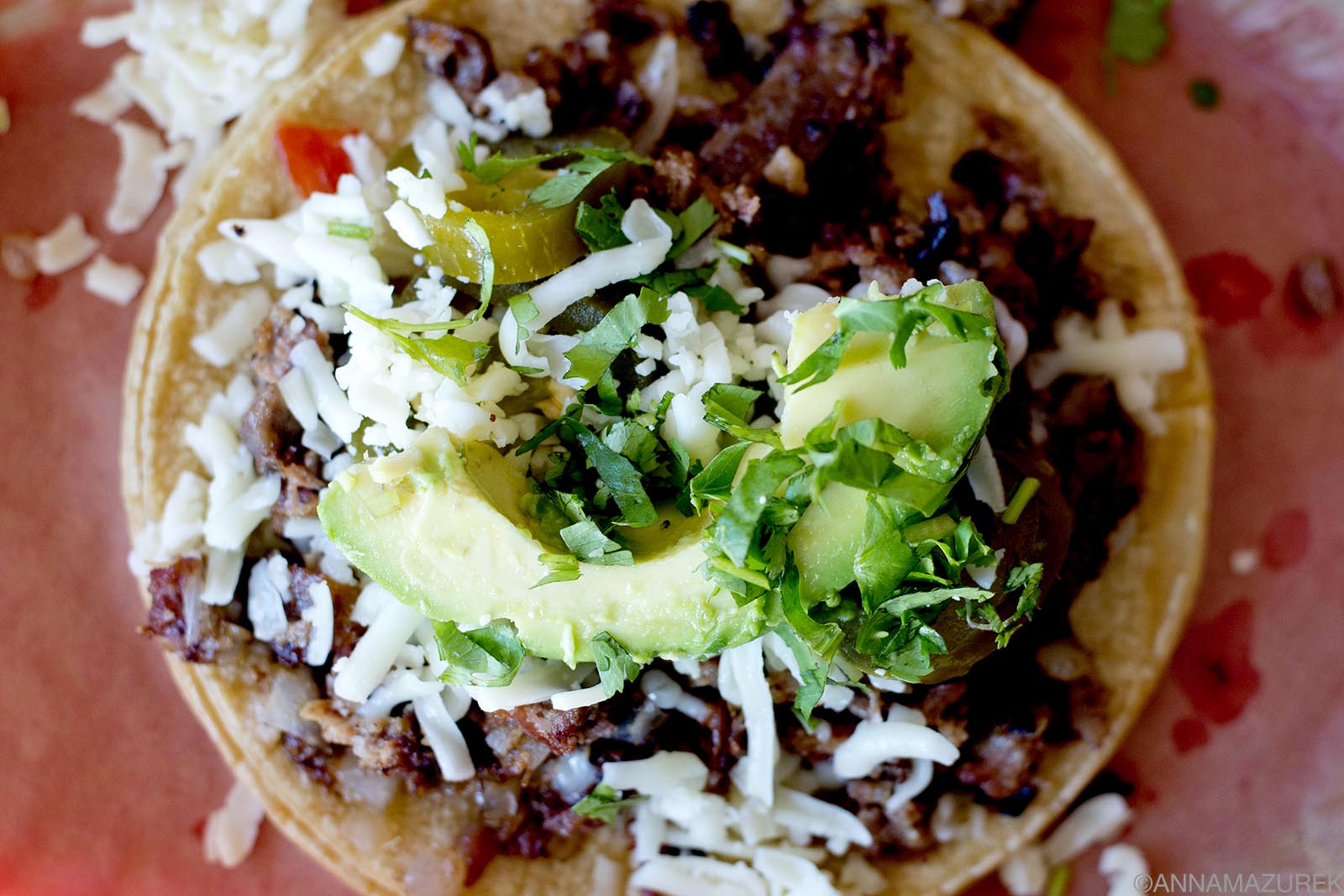 There’s no shortage of good taco joints in Austin.
There’s no shortage of good taco joints in Austin.
Choosing the best tacos in Austin is a tough call because of all the strong contenders. While the Taco Deli and Torchy’s Tacos chains are all over the city, there are better options. (Taco Deli’s white queso is great!)
Nixta Taqueria is arguably the best in town—they make their own masa and tortillas—and serve up some unconventional dishes like duck carnitas tacos. For traditional tacos, I love Veracruz All Natural, started by two sisters from Mexico. There are seven locations around town dishing out excellent migas tacos.
The best newcomer in town is Taqueria de Diaz, famous for the volcán tacos served with cheese and meat on crunchy corn tortillas. It’s hidden in an alley off Trinity Street downtown. The taquitos at Arriba Abajo at the Thompson Austin are another favorite.
The Best Bakeries & Desserts in Austin
 Left: Comadre Panaderia’s concha. Right: Jacoby’s strawberry cake.
Left: Comadre Panaderia’s concha. Right: Jacoby’s strawberry cake.
For sweets and desserts, there are endless options from desserts at all the restaurants listed above and specialty pastry and ice cream shops below.
- Comadre Panaderia is a bakery known for its concha, a sweetbread topped with a flavored cookie shell. I love the masa sugar cookies! Arrive early for the best selection. Open Thursday to Sunday.
- Amy’s Ice Cream is a classic, while Gati Ice Cream serves up coconut milk flavors!
- Everyone in Austin can spot a Tiff’s Treat’s box from a block away. The cookie shop is known for delivering boxes of fresh, warm cookies. You can buy cookies individually, and I recommend the Tiff Wich – two warm cookies with a scoop of ice cream between them. Double yum!
- Hayley Cakes makes the most beautiful and hilariously decorated giant sugar cookies with icing!
- Sugar Mama’s Bakeshop has the best cupcakes I’ve ever eaten in my life. I’m drooling on my keyboard thinking about them.
Where to Drink in Austin
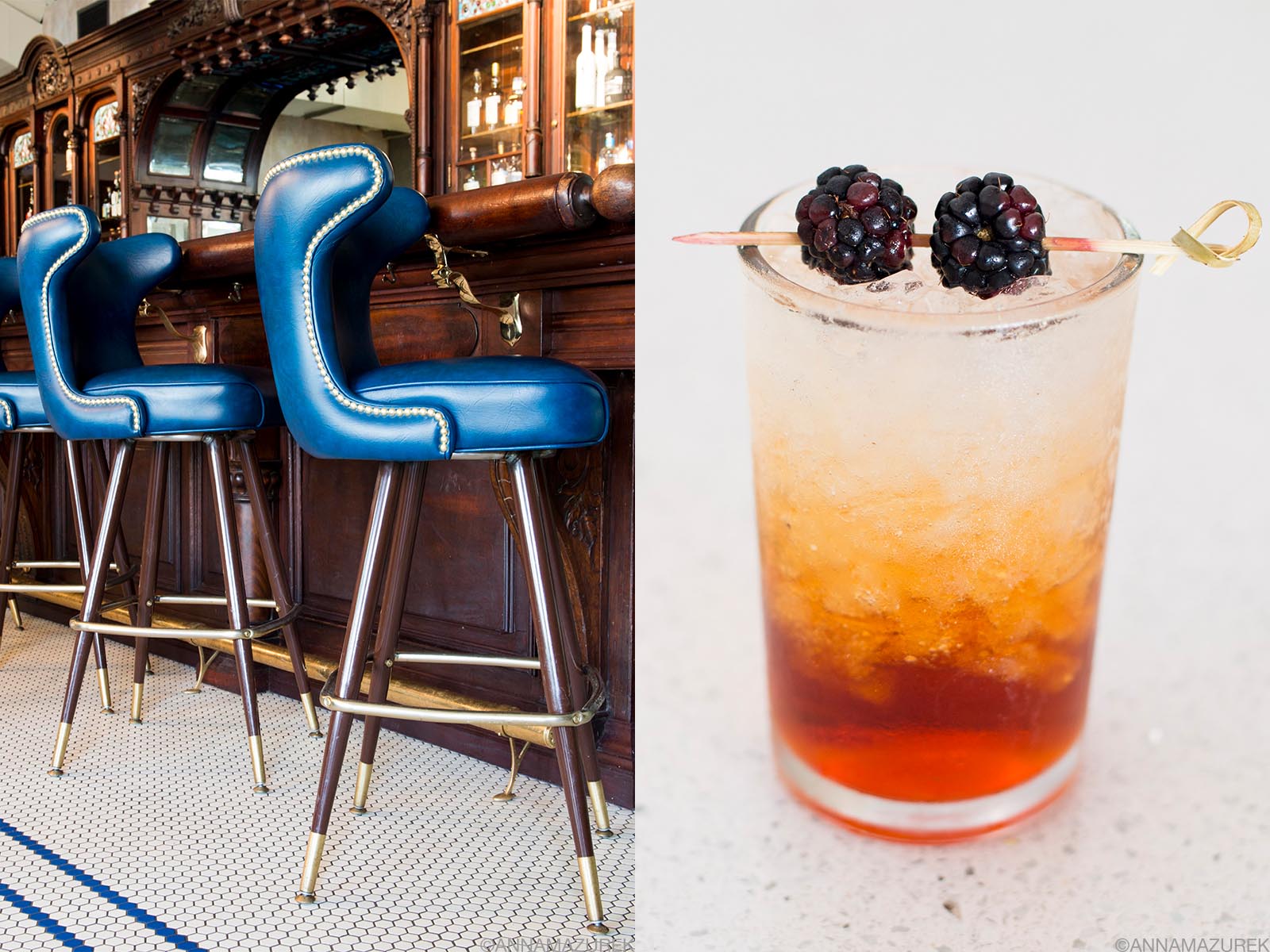 Left: Eberly’s wooden mahogany bar. Right: Drinks at Kitty Cohen’s.
Left: Eberly’s wooden mahogany bar. Right: Drinks at Kitty Cohen’s.
The Best Bars in Austin
Years of experience went into crafting this list. I’m a dive bar fan, so that’s most of the list!
- Tiki Tatsu-Ya is the coolest bar in Austin. Inspired by a fictional backstory, this tropical paradise has two levels and elaborate decor with a menu of tasty drinks and bites. Reservations required.
- Eastside Bars: Yellow Jacket Social Club is one of my favorite dive bars in Austin, with a spacious patio filled with picnic tables. This East Austin dive has a wide variety of good beer and excellent food, including the beet and goat cheese sandwich and Frito pie. Around the corner is The White Horse, an Eastside honky tonk with live music nightly and free dance lessons. They have a nice patio with a food truck. The nearby The Liberty Bar and The Grackle have large patios. Whisler’s is a hip spot a block away known for cocktails and a mezcal bar. Mama Dearest is an Arkansas-themed dive bar with hilarious décor and quirky drinks like the Memphis Michelada made with barbecue sauce.
- Kitty Cohen’s has the best patio in town with a pool for lounging on hot days and a tropical-themed bar. Be sure to check out the amazing flamingo wallpaper in the ladies’ bathroom!
- Batch Craft Beer & Kolaches is a great spot near Mueller with the best (and cheapest!) happy hour in town. They serve up sweet and savory kolaches along with a massive selection of craft beers. (There’s a wall of beer fridges to choose from!) Happy Hour is all day Monday and Tuesday and nightly the rest of the weekdays.
- Ask around for the passcode to get into the Red Headed StepChild (also referred to as Floppy Disk Repair), a small speakeasy with great drinks and a creepy decor that looks like the set of a horror movie.
- Many of the restaurants I mentioned in the previous food section are also great spots to grab a drink, including Easy Tiger, Eberly’s Cedar Tavern Bar and Banger’s.
The Best Breweries in Austin
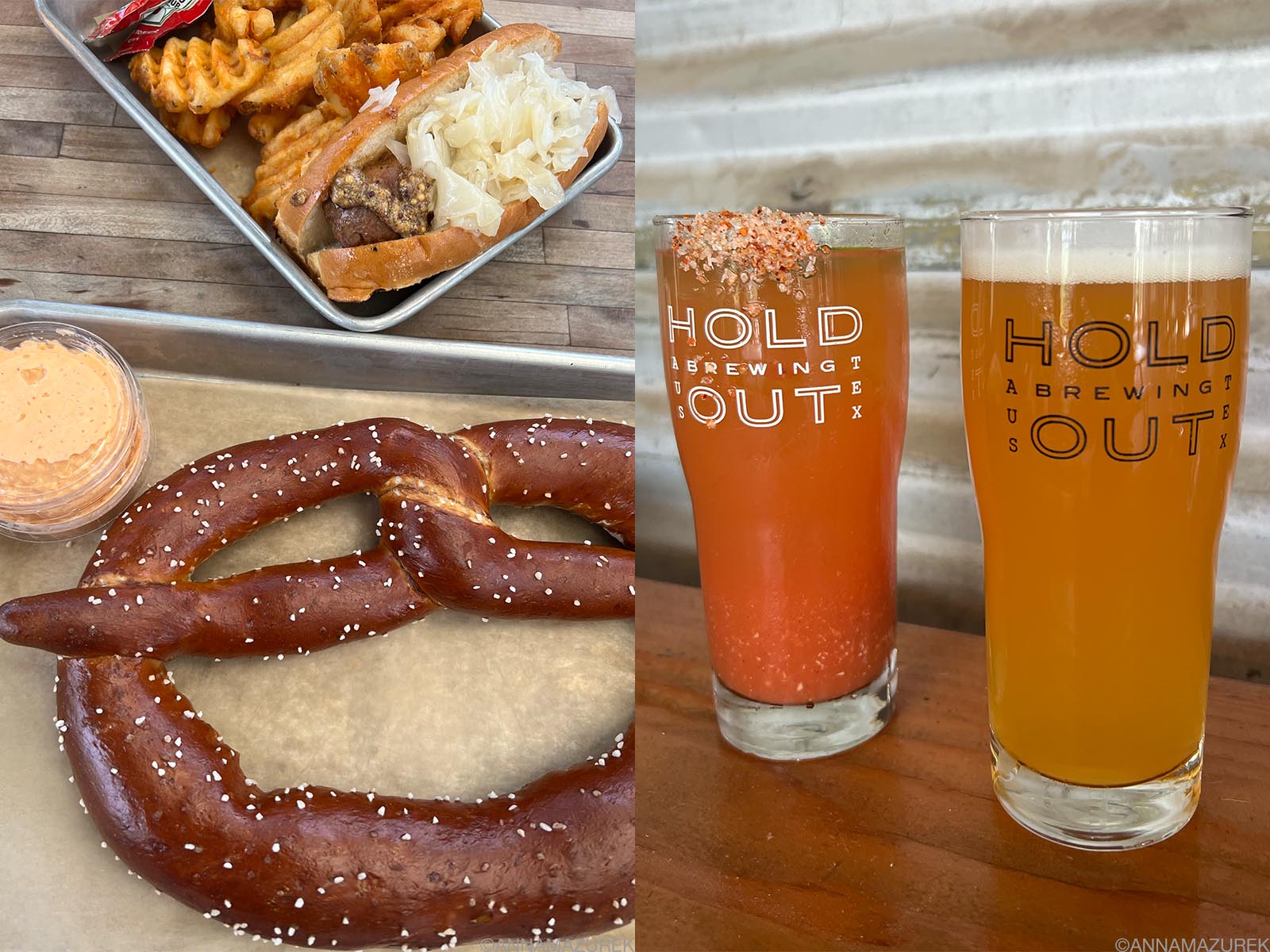 Left: Baked pretzels and beer cheese from Easy Tiger. Right: Brews from Hold Out Brewing.
Left: Baked pretzels and beer cheese from Easy Tiger. Right: Brews from Hold Out Brewing.
While several craft breweries have closed in the last few years, there’s still a great scene in Austin. Most also offer nonalcoholic options, including hop water. Here’s a roundup organized by location.
- Downtown (kinda): Hold Out Brewing is my go-to spot. Located in walking distance of downtown, this quirky half-domed building has East Austin vibes with a gigantic courtyard it shares with its sister restaurant, Better Half Coffee & Cocktails. The brewery’s hazy pale ales and IPAs are tasty along with its happy hour burgers. There’s free parking in the lot in front and behind.
- East Austin Breweries: Zilker Brewing on East Sixth Street is a great spot with rotating food trucks and walking distance to downtown. Located in the heart of the Eastside in an old gas station, Lazarus Brewing Company serves up brews, tacos and coffee. Central Machine Works has a huge patio that’s a great hangout spot on the far Eastside. Hi Sign Brewery’s spacious taproom is located slightly farther east.
- North Austin Breweries: HopSquad Brewing is just a few minutes’ walk from Q2 Stadium. Austin Beerworks is another Northside favorite.
- South Austin Breweries: While these aren’t all in walking distance of each other, South Austin is another great area for breweries. A few highlights are Nomadic Beerworks, ABGB, St. Elmo Brewing Company, Meanwhile Brewing, Vacancy Brewing and Pinthouse Brewing. (Vacancy and St. Elmo are within walking distance of each other.)
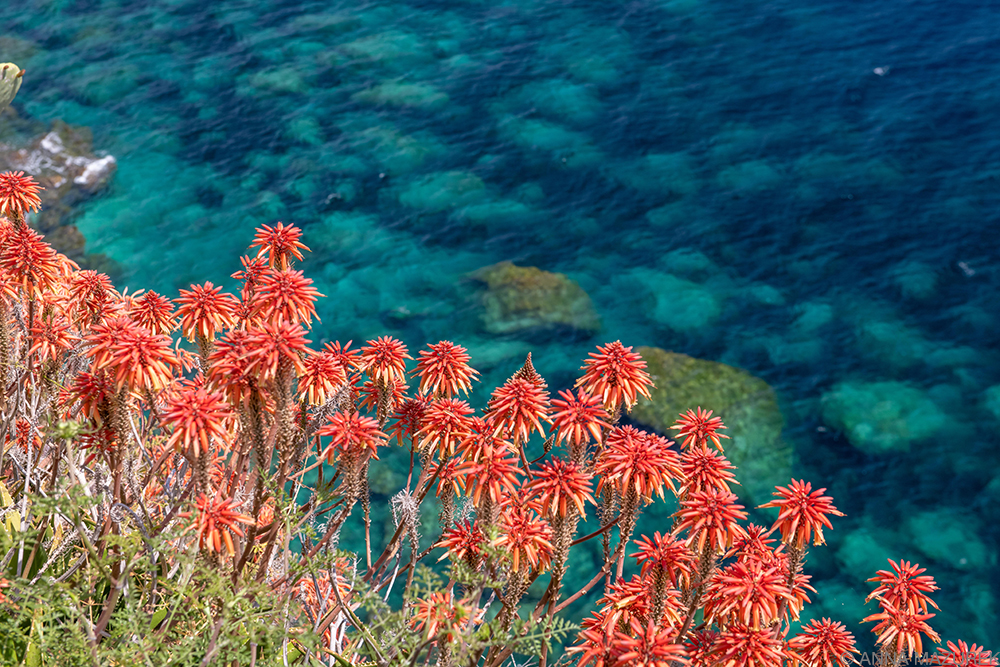
Pros & Cons of eSIM Cards for Travel
 Bonifacio, Corsica // I used an EU SIM card I bought in Italy for a trip to three different countries in the Mediterranean with success.
Bonifacio, Corsica // I used an EU SIM card I bought in Italy for a trip to three different countries in the Mediterranean with success.
One of my biggest travel pet peeves is finding affordable cellular data plans abroad. Historically, I’ve always bought local SIM cards because they are significantly cheaper than paying $10/day for my normal U.S. plan (Verizon) to work abroad. (Also, it’s absurd that both Verizon and AT&T charge $10/day on top of your regular phone plan for international coverage.) Keep reading for more details on eSIM cards for international travel!
Affiliate links are used in this post. If you make a purchase, I earn a small commission at no cost to you, which goes toward blog maintenance costs. I only recommend products and companies I truly love and use.
What is an eSim card?
It’s essentially a digital SIM card included in many newer phones. (Apple nixed the SIM card tray on U.S. models with the iPhone 14, so eSIMs are the only option for those models and newer ones going forward.) It makes things more convenient since people no longer have to go to a store to get a physical SIM card and find a tool or paper clip to open the SIM tray! The main benefit of an eSIM card is that it can work in mutliple countries, so it eliminates the hassle of buying multiple SIM cards. Plus, it’s much cheaper than paying for an internatinal plan through a U.S. carieer.
In certain parts of the world, you can still buy the newest iPhone model with a physical SIM tray, especially in Asia. The only negative side to buying an iPhone abroad is that the AppleCare plan doesn’t include the theft option.
What are the cons of an eSIM card for travel?
They can be tricker to activate and aren’t compatible with all phones or phone plans. I had issues with my previous phone (iPhone 13 Pro) initially but have zero issues with my current newer iPhone. Now, most eSIM apps will tell you if your phone is capable.
The biggest problem with eSIM cards is that they don’t cover some remote parts of the world. Options are either limited to expensive. I struggled to find an affordable eSIM card for my trip to Laos in Southeast Asia earlier this year but was able to buy an affordable one from a local provider at the airport with no issues.
Also, learn from my mistakes: If you’re buying a regional or global eSIM card, be sure to check that every country on your trip is covered by your plan.
How do I get an eSIM card?
Simply download the app on your phone from any of the eSIM card brands, including Airalo or Saily. Choose and purchase a global, regional or local eSIM card, then follow the on-screen instructions to install, which I recommend doing before leaving for your trip. (The apps will even tell you right away if your phone is compatible before purchasing.) In the cellular settings on your phone, make sure the eSIM card is selected for cellular data. The plan will not activate until you arrive in the destination.
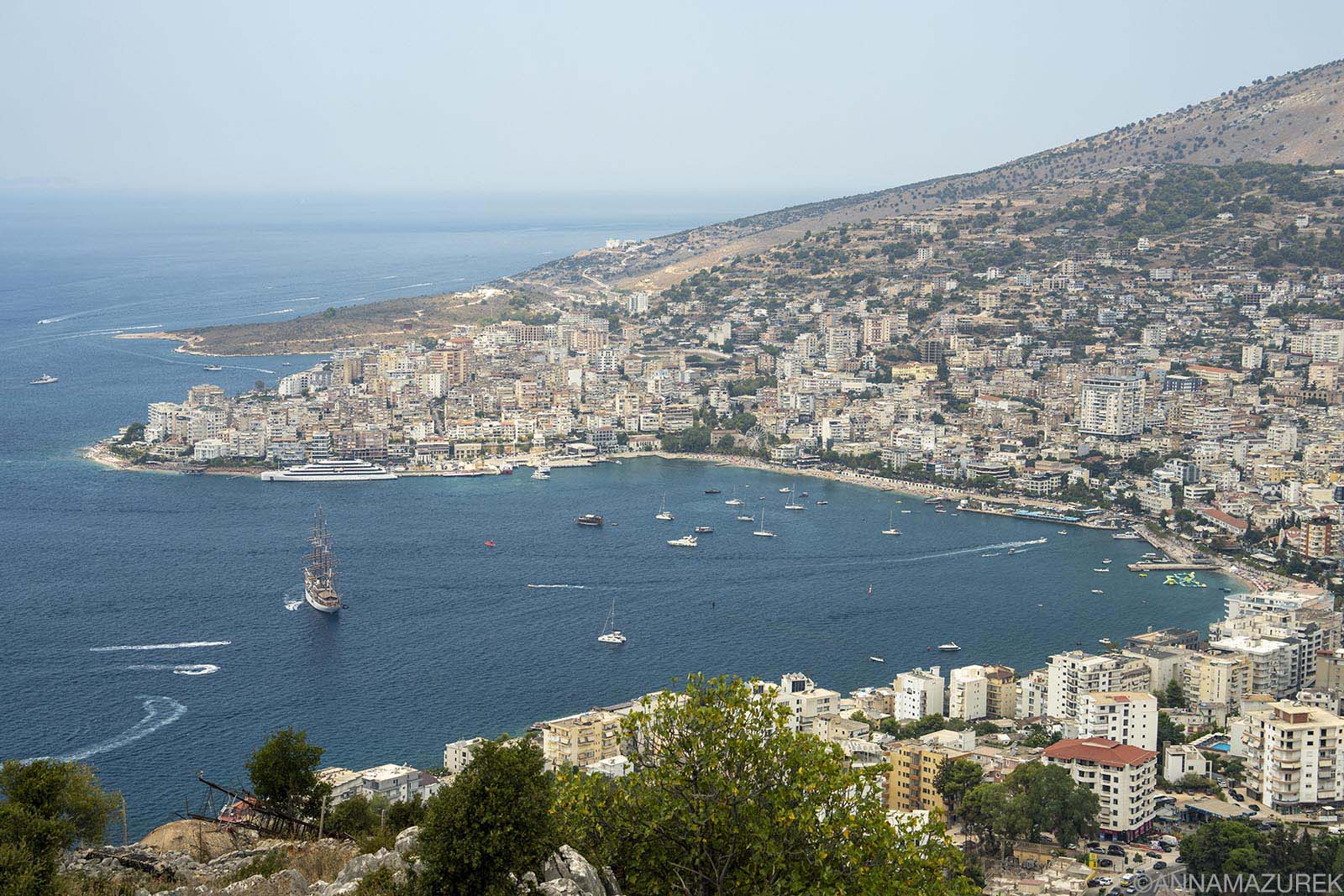 Sarandë, Albania // I used an Airalo 10 GB Europe eSIM for seamless connectivity hopping between Greece, Croatia, Albania and Montenegro recently. Since the latter two are not E.U., so I’d had pervious issues with a physical SIM card bought in Greece not working in those countries. The eSIM solved the issue.
Sarandë, Albania // I used an Airalo 10 GB Europe eSIM for seamless connectivity hopping between Greece, Croatia, Albania and Montenegro recently. Since the latter two are not E.U., so I’d had pervious issues with a physical SIM card bought in Greece not working in those countries. The eSIM solved the issue.
Do eSIMs offer unlimited data?
Yes, there are several companies that offer the option, but read the fine print. The word “unlimited” is deceptive because there’s always a “fair use” data limit, where you get a set amount of high-speed data (usually 3-5gb) per day. After that, data speeds are throttled, which makes sense. This also really affects hotspot users. I’ve seen brands that cap hotspot data at only half a gig a day, which is insane.
Most unlimited plans are more customizable allowing you to pick exactly the number of days you need but are always more expensive that plans with set data limits.
Are eSIMs cheaper than buying a regular SIM card for travel?
It depends. While they are cheaper than paying for a U.S. international plan, they are not cheaper than buying a local physical SIM card in most places. In Thailand, I pay roughly $10/month for an unlimited plan and in Laos, I paid $4 for 30 GB a few months ago.
With companies like Airalo or Saily, it’s $16-20 for 5GB in various regions of the world, which is a good deal and more convenient if you’re country-hopping. If you’re staying in one place long-term, it’s still cheaper to buy a local SIM card.
Always avoid buying one in an airport—everything is usually half-price outside the airport! I’ve found physical SIM cards to be slightly less expensive than a regular SIM, but most phones don’t have this option anymore.
Do eSIMs work for travel in the U.S.?
Yes, Airalo, especially, has plans in the U.S. This spring, I ran out of data on my Verizon plan right before a three-month trip to Europe, so I but didn’t want to renew for another month. It worked perfectly with no issues. This is great for people traveling in the U.S. or expats returning for a short visit. Here is a list of their U.S. plan options.
Do eSIMs support personal hotspots?
The short answer is yes but not all do! This is a dealbreaker for me because I work while I’m traveling and most of the time, I find that WiFi networks are terrible. I rely heavily on my personal hotspot for WiFi on my computer for Zoom calls.
I’ve had great success using my personal hotspot with both country-specific and regional Airalo eSIMs in Asia recently in Japan, Korea and Southeast Asia. Airalo says it’s available if the carrier supports it, so it’s hard to say if it will work every time, but it’s always worked for me.
Read my reviews of Airalo eSIMs & Saily eSIMs in Southeast Asia & Japan!
Are eSIMs safe? Are there privacy concerns with eSIMs?
eSIM providers require you to use their app to activate and use the service, which means you can be tracked. Apple users should turn on the “ask app not to track” setting to avoid this. I’m sure Android devices have a similar setting. In some ways, eSIMs are safer.
If your phone is stolen, you can easily switch the service off your phone to prevent your number from being stolen. If you’re really concerned, you can also use a VPN for added security. (Saily eSIM cards actually include a VPN.) I personally use NordVPN, which is the company that owns Saily. For more about VPNs, check out my recent post about two-step verification and traveling.
What is the best eSIM card for international travel?
All eSIM brands have a similar pricing structure, but eSIM cards are only as good as the local network they partner with. I’ve had great experiences with Airalo eSIMs for my iPhone, which you can read about in my Airalo review post.
To save money, use these promo codes: New customers save 15% off with NEWTOAIRALO15 and existing users save 10% with AIRALOESIM10.
The team behind NordVPN recently launched Saily, which has a wide variety of pricing options. (Use promo ANNA5 for 5% discount on Saily.) I had an overall good experience with Saily, which I review in this post.
Other brands include Nomad (which the New York Times writes about), GigSky Holafly and Flexiroam are others, but I can’t vouch for any of these. Apple also has a webpage with a list of wireless carriers worldwide that offer eSIM services.
What I do for phone data when I travel long-term
I’ve had the same U.S. phone number since I was 16. It’s the only consistent thing in my life. I’ve changed addresses so many times that I literally had to type up a Word document with all my previous addresses so I could apply for Global Entry! Since I’m often abroad for months at a time, it’s a waste of money to pay my U.S. phone bill while I’m gone since it’s worthless. And, paying $10/day for the international plan is outrageous and should be a crime! Verizon previously had a policy where you could suspend your service without billing for six months a year, but they did away with it. The only workaround that I could find was a prepaid plan. As long as I pay my bill every 60 days, I keep my number.
For example, I only paid for two months on my recent six-month trip abroad. Plus, I always downgrade to the cheapest plan. If I’m in a country for a long time, I buy a local eSIM card at the mall because airport kiosks are too expensive.
For the last two months in Europe, I’ve used strictly Airalo eSIMs, a regional Europe plan and a Greece-specific plan, which has been great.
Final eSIM Takeaways
Overall, eSIMs are the future—ready or not. They are very convenient and cheaper than paying for an international plan for your American phone plan unless you have T-Mobile. Regional eSIM plans are excellent for short trips to multiple countries. Currently, Airalo is one of the best options and is worth trying out. Saily is comparable with a great built-in virtual location feature.
If you’re going to be traveling long-term in a country or region, I still think getting an eSIM or regular SIM card from a local cellular provider is a better deal, especially in places like Southeast Asia. Certain parts of the world will take longer than others to catch up to this new technology so that’s my concern. (I’m about to head to Africa, and prices are insane!)
After much hesitation, I upgraded my iPhone last year and kept my old iPhone 13 as a backup in case I need a physical SIM card to use the hotspot to work while I’m traveling. It’s too risky for me otherwise with work to not have that feature. I haven’t needed it yet, but I’ll report back after my two months in Africa!
Happy travels!
